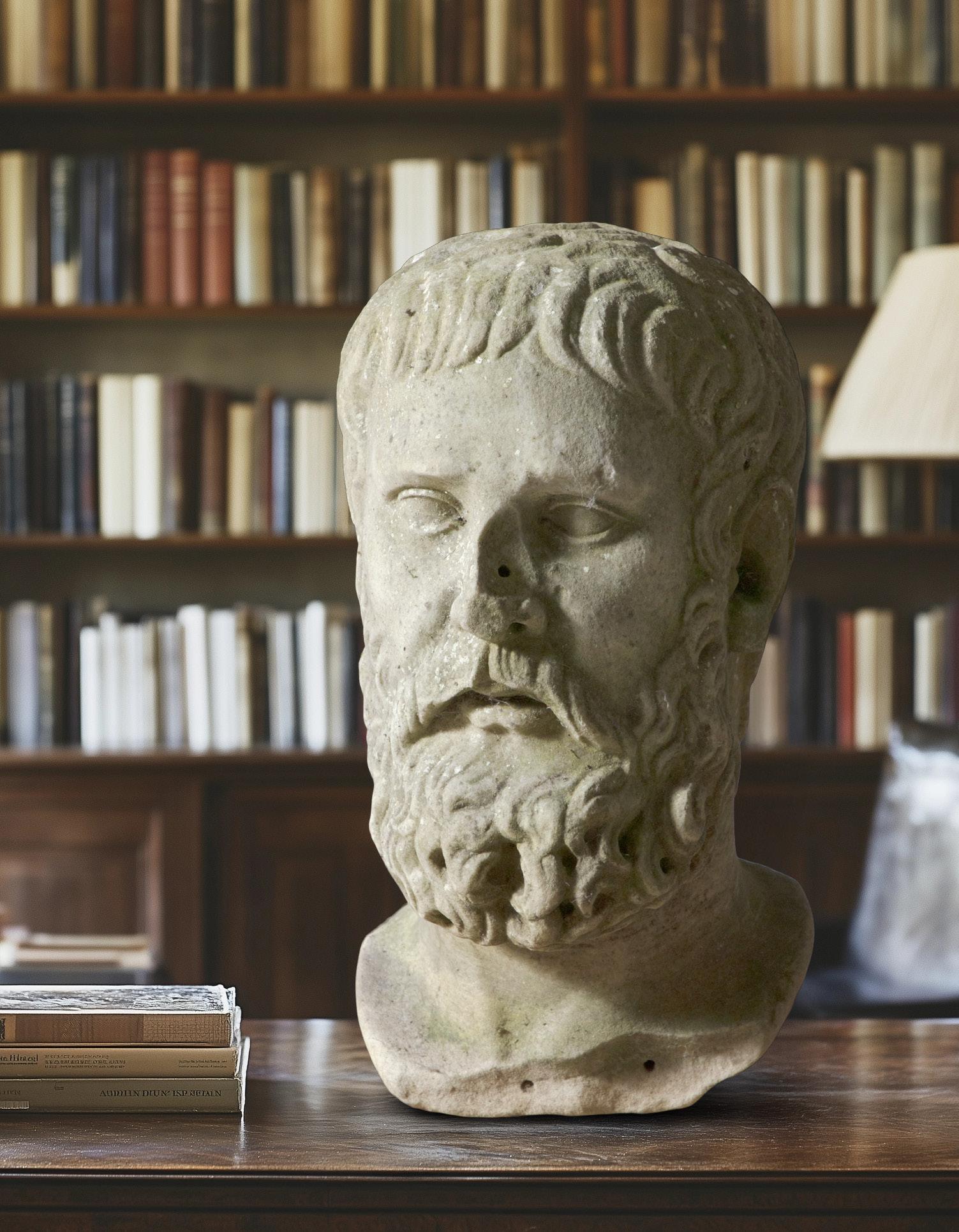
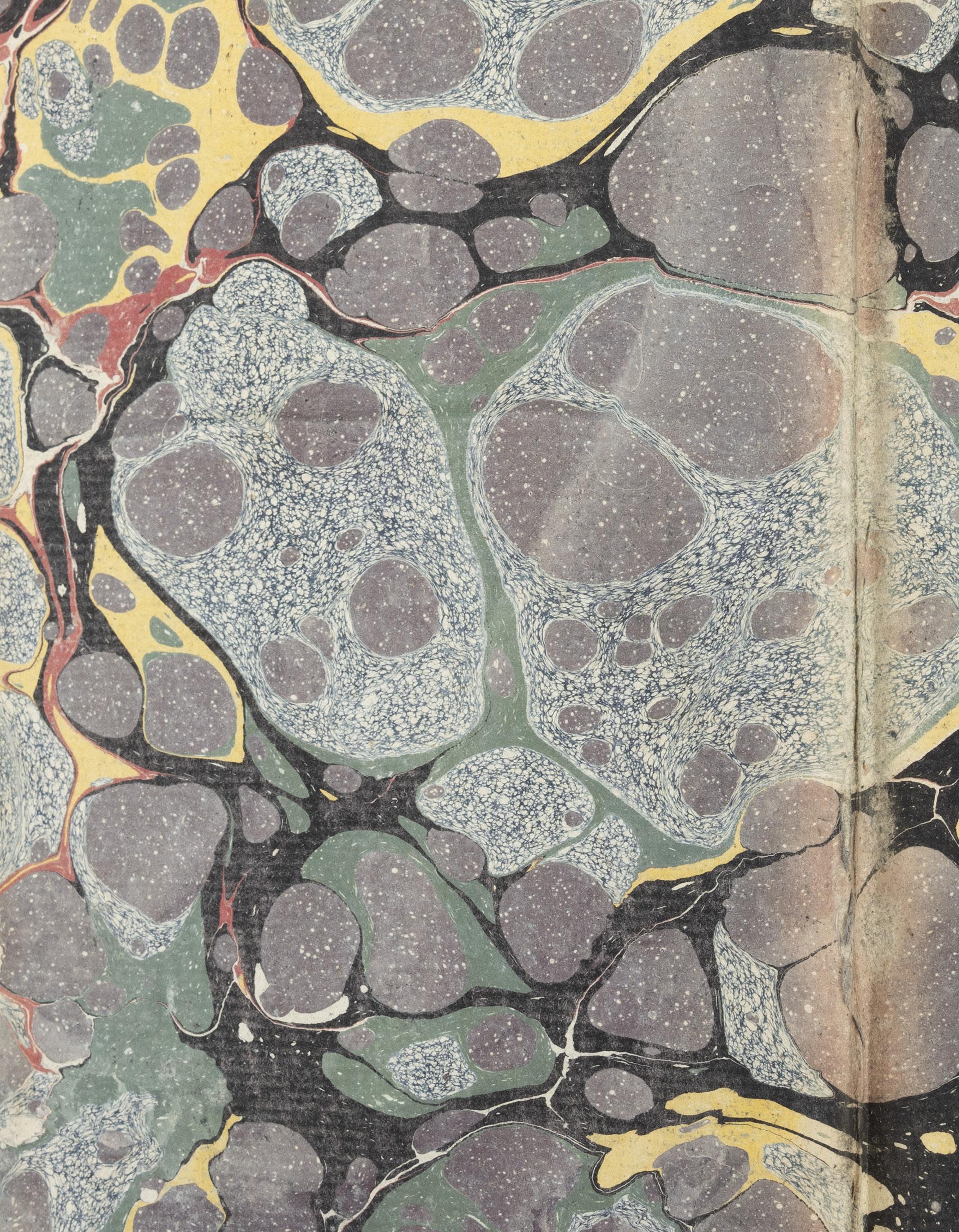
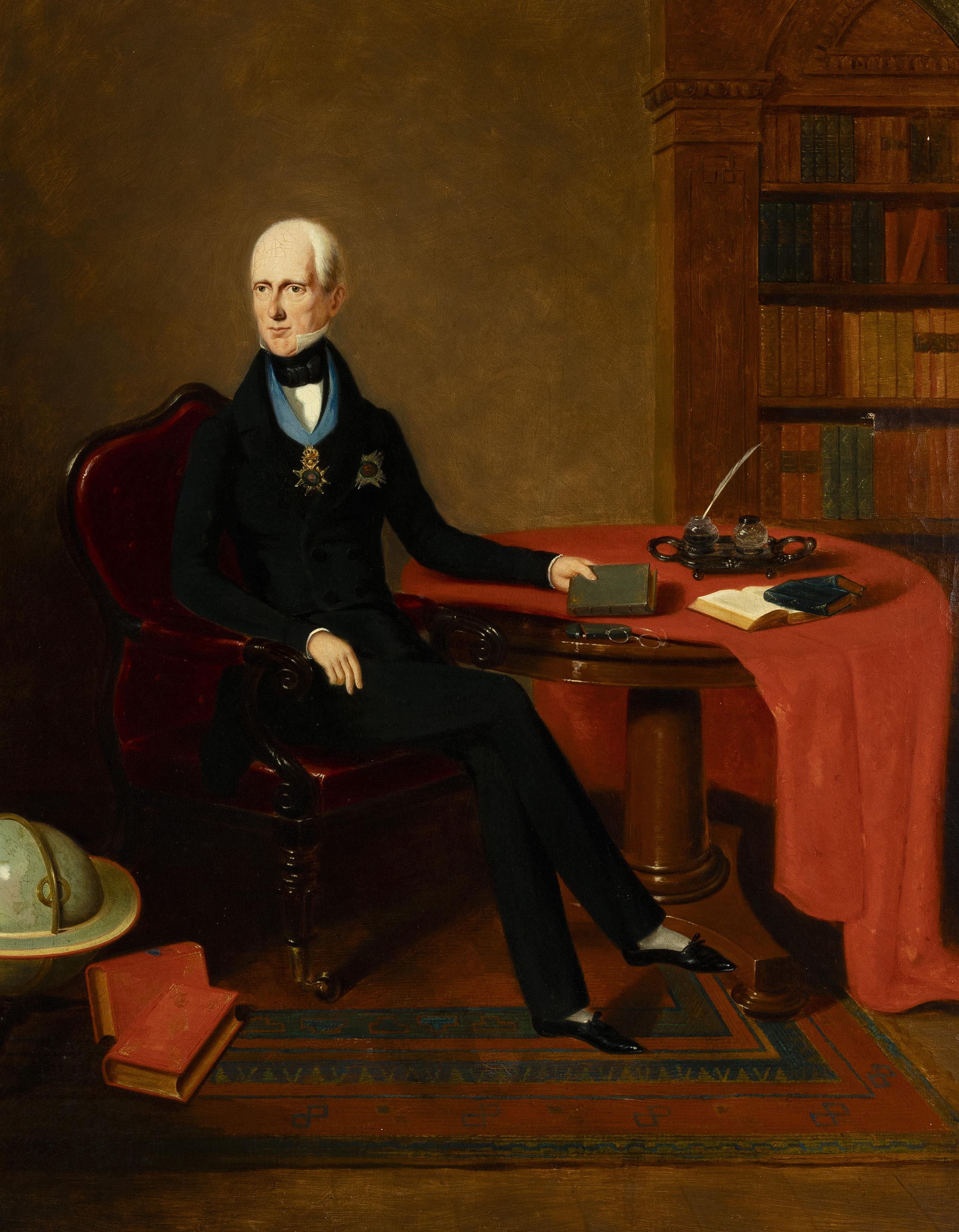






AUCTION
29th April at 11.00am
26 St. Stephen’s Green, Dublin 2. Ireland, D02 X665
+353 (01) 676 0261 adams.ie
FOLLOW US
Instagram: adams.auctioneers
X: Adams1887

ON VIEW AT 26 ST STEPHEN’S GREEN, DUBLIN 2
All Auction Viewings are free and open to the public
Friday 25th April 10.00am – 5.00pm
Saturday 26th April 1.00pm – 5.00pm
Sunday 27th April 1.00pm – 5.00pm
Monday 28th April 10.00am – 5:00pm
Please refer to the Buying At Auction section at the back of this catalogue, or adams.ie for further details on bidding in this auction, including absentee bidding.

26 St. Stephen’s Green, Dublin 2. Ireland
+353 1 676 0261
info@adams.ie | www.adams.ie
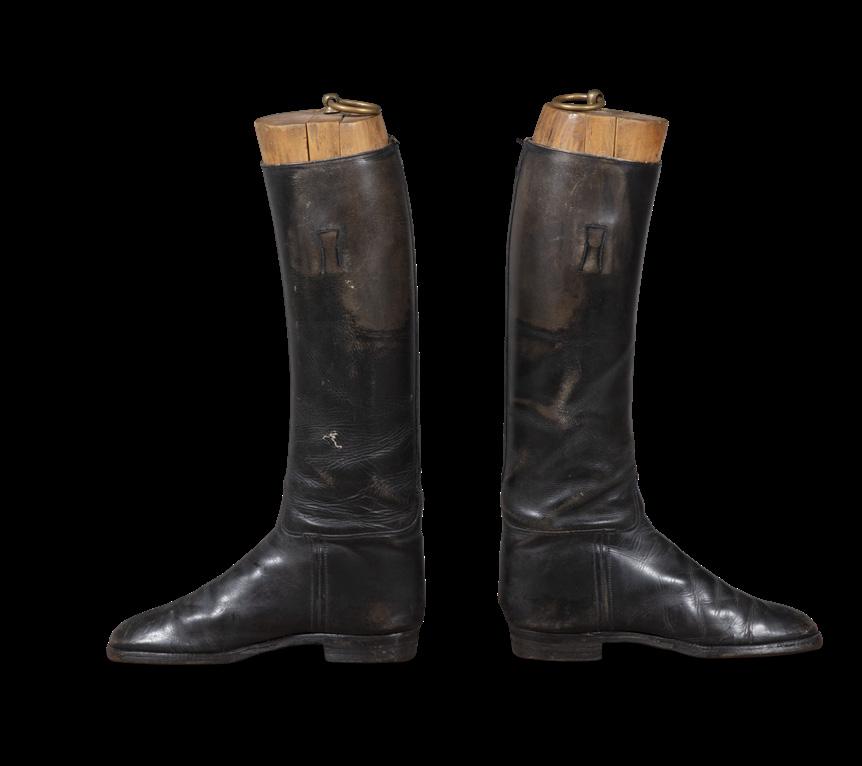
1. Estimates and Reserves
These are shown below each lot in this sale. All amounts shown are in Euro. The figures shown are provided merely as a guide to prospective purchasers. They are approximate prices which are expected, are not definitive and are subject to revision. Reserves, if any, will not be any higher than the lower estimate.
Under no circumstances will delivery of purchases be given whilst the auction is in progress. All purchases must be paid for no later than Friday 2nd May 2025. Please contact a member of staff to arrange delivery of your purchases. Auctioneers commission on purchases is charged at the rate of 30% inclusive of VAT (effective from January 2025) Terms: Strictly cash, card, bankers draft or cheque drawn on an Irish bank. Cheques will take a minimum of eight workings days to clear the bank, unless they have been vouched to our satisfaction prior to the sale, or you have a previous cheque payment history with Adam’s. We also accept payment by all major credit and debit cards. Please note a surcharge will apply of 2% of the invoice total for non-EU card types. For payments by bank transfer please ensure all bank charges are paid in addition to the invoice total, in order to avoid delays in the release of items. Goods will only be released upon clearance through the bank of all monies due. Artists Resale Rights (Droit de Suite) is not payable by purchasers.
3. VAT Regulations
All lots are sold within the auctioneers VAT margin scheme. Revenue Regulations require that the buyers premium must be invoiced at a rate which is inclusive of VAT. This is not recoverable by any VAT registered buyer.
It is up to the bidder to satisfy themselves prior to buying as to the condition of a lot. Whilst we make certain observations on the lot, which are intended to be as helpful as possible, references in the condition report to damage or restoration are for guidance. The absence of such a reference does not imply that an item is free from defects or restoration, nor does a reference to particular defects imply the absence of any others. The condition report is an expression of opinion only and must not be treated as a statement of fact. Please ensure that condition report requests are submitted before 12 noon on Monday 28th April 2025 as we cannot guarantee that they will be dealt with after this time.
We are happy to execute absentee or written bids for bidders who are unable to bid online themselves and can also arrange for bidding to be conducted by telephone. However, these services are subject to special conditions (see conditions of sale in this catalogue). All arrangements for absentee and telephone bidding must be made before 5pm on the day prior to sale. Bidding by telephone may be booked on all lots. Early booking is advisable as availability of lines cannot be guaranteed.
Bidders should be advised that importation regulations of several countries, including the US, prohibits the importation of ivory and that endangered species, or any goods containing same. Therefore Adams advises prospective purchasers who intend to ship lots containing either ivory or coral to another country to familiarise themselves with the relevant importation regulations prior to bidding. Adams will not be responsible for shipping items herein and the onus will be on the buyer to organise shipping at their own behest.
LOTS MADE OF / CONTAINING ANTIQUE IVORY, CORAL AND ENDANGERED/OTHER SPECIES ARE INDICATED BY THE FOLLOWING SYMBOLS ‘*’&’**’
These are sold as ‘antiques’ only and if bought for use, buyers must have them checked over for compliance with safety regulations by a qualified electrician before you use them. Adam’s does not take responsibility for non-functioning electrical goods as most second-hand electrical items sold at auction require re-wiring even if functioning at the time of the auction viewing.
ELECTRICAL GOOD IN NEED OF REWIRING ARE INDICATED BY THE SYMBOL ‘(E)’
8. All lots are being sold under the Conditions of Sale as printed in this catalogue and on display on our website.
9. Acknowledgments
We would like to acknowledge, with thanks, the assistance of Conor Barry, Stephanie Brennan, Dr. Mark Faulkner, Weronika Kocurkiewicz in the preparation of this catalogue.

Stuart Cole MSCSI MRICS MANAGING DIRECTOR s.cole@adams.ie

Amy McNamara BA MA ASSOCIATE DIRECTOR amymcnamara@adams.ie

Niamh Corcoran BA FINE ART DEPARTMENT niamh@adams.ie

Conor Barry FINE ART DEPARTMENT conor@adams.ie

Adam Pearson BA SALEROOM CURATOR a.pearson@adams.ie

Ronan Flanagan HDip WAREHOUSE MANAGER r.flanagan@adams.ie

Nathaniel Nicholson ASSOCIATE DIRECTOR n.nicholson@adams.ie


Weronika Kocurkiewicz FINE ART ADMINISTRATOR weronika@adams.ie

Eamon O’Connor BA FINANCIAL DIRECTOR e.oconnor@adams.ie

Stephanie Brennan FINE ART ADMINISTRATOR stephanie@adams.ie

Hitesh Khatri ACCOUNTS DEPARTMENT hitesh@adams.ie

Tara Coakley ACCOUNTS DEPARTMENT tara@adams.ie
Viewing has never been easier. Go to www.adams.ie. Choose the auction you wish to view from the Auctions/Forthcoming auctions menu, and you will be offered a range of ways to view. You may choose to view a digital version of the printed catalogue in the view e catalogue option or explore the virtual 3D option which allows you explore the saleroom with easy to navigate options or view the list view which opens automatically. This last option provides additional information and photographs of each lot as you choose the View Details button. Lastly, and only during office hours there is a live chat button onscreen. If at any time you have a question whilst you are on line you can open a live chat and one our staff can help you.
We are delighted to advise that our own on-line bidding platform, Adam’s Live is now fully operational for those who wish to bid on-line. Watch the auction as it happens. On the Live platform you can arrange to bid as the auction is taking place or at any timeleave comission bids and the Adam’s Live platform will bid on your behalf.
Bidding through this portal will attract no additional internet surcharge for lots purchased so in effect those bidders will pay the same as a room bidder. Online bidding through the-saleroom.com and invaluable.com remains unaffected.
Sign up today for your own My Adam’s account and start saving on your on-line purchases.
Log on to our web site www.adams.ie and create an account by signing up and registering your particulars online. The process involves supplying valid credit card information. This is a once off request for security purposes, and once the account is activated you will not be asked for this information again. The card information supplied is securely stored by Sage Pay. You can leave absentee bids online, and add, edit or amend bids accordingly as well as bidding over the internet in real time through ‘Adam’s Live’. You can also view your invoices, bid history, wish lists & other useful functions including paying your invoice and creating you very own personalised catalogue with search tags that will notify you once a catalogue is uploaded for your key word search.

Circular navigation points allow you to walk around the viewing room
Information points provide “point & click“ details on lots in view
ADAM’S LIVE

Watch the Auction and bid live with Adam’s Live


A BRASS DOOR LOCK AND KEY mounted on timber base. 31 x 18cm
€ 500 - 800

3
A GOLD MOUNTED RIDING CROP of typical form, the foliate engraved gold knop with a turquoise stone terminal and a further foliate engraved gold band toward the lower handle, with label. 75cm long
€ 500 - 700


4 A CAST IRON POLYCHROME PAINTED ROYAL COAT OF ARMS FOR THE UNITED KINGDOM modelled with a rearing lion and horse either side of a shield with motto banner ‘Dieu et Mon Droit’ translating to ‘God and my right’, mounted on a painted timber panel. 76cm high, 36cm wide
€ 400 - 600
5 A FRENCH CAST-IRON COAT AND UMBRELLA STAND IN THE MANNER OF CORNEAU FRÈRES, LATE 19TH CENTURY, in the form of ivy issuing hooks centred by a mir ror above two dogs, with inset white enamel tray, 226cm high, 73cm wide, 32cm deep
€ 500 - 800

6 A CEREMONIAL HUNTING HORN, 19TH CENTURY, of cow horn with brass mounts and incised with the Royal Arms of the United Kingdom and motto ‘Honi Soit Qui Mal Y Pense’, 47cm long
€ 300 - 500

7 A PAIR OF BLACK LEATHER RIDING BOOTS WITH BOOT TREES/ SHAPERS, the trees/shapers stamped ‘LORD FREDK. BLACKWOOD 9TH LANCERS / ROBERTSON & PANZETTA MAKERS, 29 MADDOX
ST.W’
c. 50cm high
€ 200 - 400




8
A DOCUMENT BOX BY HEPBURN & COCKS with hinged lid and twin carrying handles,inscribed to one side ‘The Trees of Mr and Mrs Blands M/S’, with plaque to inside of lid inscribed ‘HEPBURN & COCKS, CASH & DEED BOX MANUFACTURERS, 49 LINCOLNS INN FIELDS’. 20.5cm high, 27cm deep
€ 400 - 600

A MAHOGANY AND BRASS MOUNTED MINIATURE
COUNTRY HOUSE LETTER BOX, the domed octagonal top with central roundel above a rectangular letter slide, the body with cupboard door applied with paper-slip register, on circular plinth base, 43cm high, 25 cm diameter
€ 500 - 800
The late Victorian and Early Edwardian period, 1870–1910 has been acknowledged as the apex of popularity for these charming desktop post-boxes. A favourite of the aristocracy, they were generally found in a country house estate or foyer of a well-appointed hotel and accumulated letters from the family as well as those in the employ of the house. The footman was then charged with emptying the box and transporting its valuable content to the local post-office every day, twice a day. It is worth noting that the street post-boxes and pillar boxes that have become so iconic today were only introduced to the Great Britain in 1853 and so we can assume that this early model was installed in quite a sophisticated and affluent home.
A LARGE VICTORIAN OAK PILLAR POST BOX of square shape with moulded top, panelled sides and hinged door with collection slot and fitted with a zinc lined catch basket, 138cm high, 65cm wide, 65cm deep
€ 1,000 - 1,500

11 IN THE MANNER OF JOHN
FREDERICK HERRING SENIOR
Racehorse with Jockey and Handler
Signed and dated 1856 Oil on canvas, 46 x 61cm
€ 1,500 - 2,500
12 A VICTORIAN MAHOGANY ARMCHAIR, the scroll back and outscrolling armrests with carved foliage upholstered in burgundy hide on turned fret with castors
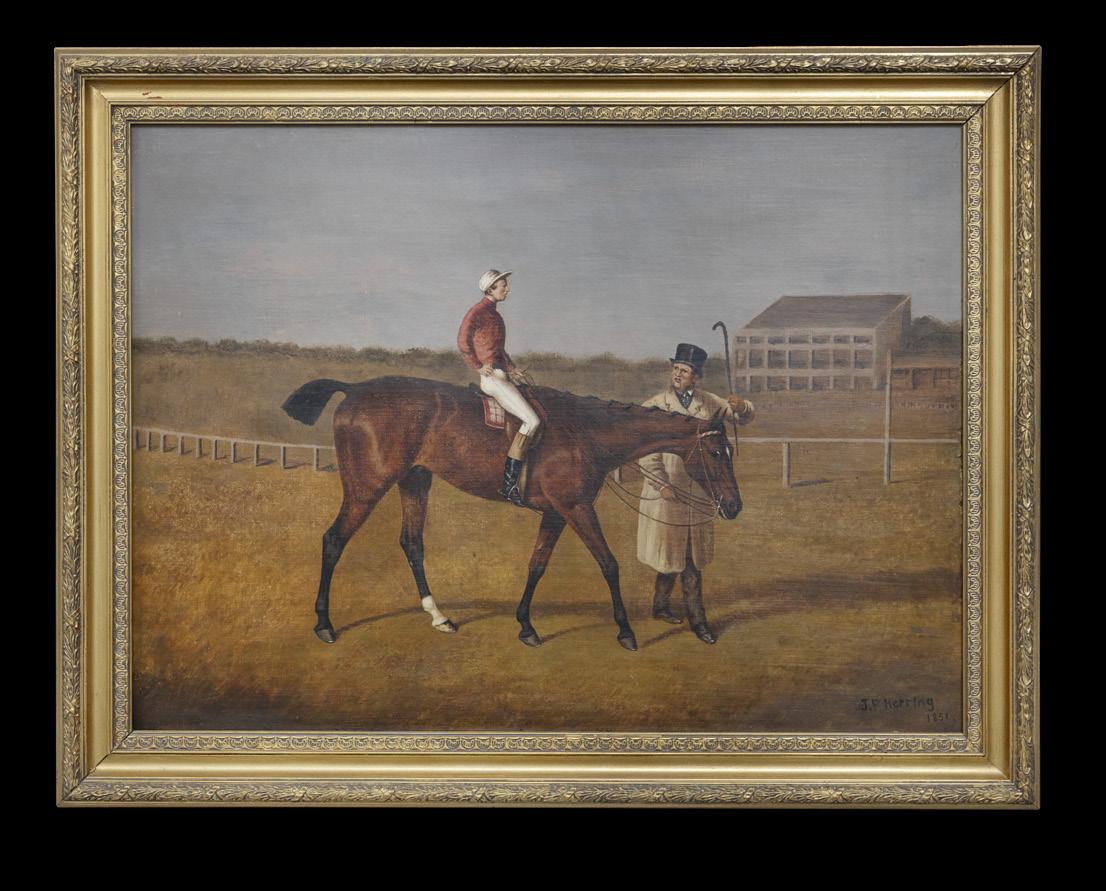



A CAPE BUFFALO (SYNCERUS CAFFER) HUNTING TROPHY
mounted on a timber board. 100cm wide
€ 300 - 400
A FRENCH GILT BRONZE ‘VERSAILLES’ CEILING LIGHT, 19th century, in Louis XVI style, surmounted with suspension ring and coronet above two bands of bevelled glass panels, the divisions applied with scallop shells and river gods, converted to electricity, 60cm high, 37cm diameter (E)
€ 500 - 800

A LATE 19TH-CENTURY HAWKSBILL SEA TURTLE SHELL 50cm long
€ 300 - 500
17
A PAIR OF WILLIAM IV MAHOGANY X-FRAME WINDOW SEATS, with inscrolled arms, with twist turned struts and cross stretchers, with brown leather horse hair padded seats, raised on scroll legs and porcelain castors. 82cm high, 108cm long, 44.5cm deep


18
THOMAS LUNY (1759-1837)
Royal Navy Ships off Yarmouth Oil on board, 25 x 35.5cm
Signed and dated ‘Luny 1818’ (lower left)
Provenance : Sale, Christie’s, South Kensington, 24 November 2011, lot 20; With N.R. Omell Gallery, London, where acquired October 2014
€ 2,000 - 3,000
20

THOMAS LUNY (1759-1837)
Boats rough seas, men rowing with light house in the background - Shipping on the River Scheldt Oil on board, 22 x 30cm
Signed and dated ‘Luny 1820’ (lower left)
Provenance : With N.R. Omell Gallery, London, where acquired
€ 1,500 - 2,000
A PAIR OF GEORGE II STYLE MAHOGANY LOW WING ARMCHAIRS
Each with padded back and seat in mustard yellow upholstery, with out scrolling arms and leaf capped paw feet joined by stretchers, 103cm high, 74cm wide, 60cm deep
€ 1,000 - 1,500


21 FRANK HENRY JOSEPH GARDINER (b. 1942)
HMS Victory Anchor off the Carrick Roads off Mawes Castle; and HMS Victory Anchored off the Hard at Portsmouth Watercolour and gouache, 28 x 38cm Each signed and dated ‘F.J.H GARDINER ‘16’ (lower left) (2)
€ 800 - 1,200
The Gladstone Bag was designed by Mr J.G. Beard of Westminster, London and was named in honour of the British Prime Minister William Ewart Gladstone (1809-1898) of whom Beard was an avid fan. The bag was popular due to its lightweight construction which was a far cry from the weighty wooden framed trunks which had been in use before. For this reason, the gladstone bag has been associated with the medical profession and is recognisable as the archetypal doctor’s bag adopted widely due to its secure claps, generous storage and smart silhouette.

A LARGE VINTAGE ALLIGATOR SKIN GLADSTONE TRAVELLING BAG,
with twin handles and concertina action opening, fitted staps and brass handles, the interior lined with a metal frame, 70cm wide, 34cm deep, 32cm high
€ 1,000 - 1,500


24
A VINTAGE BROWN LEATHER RECTANGULAR SLOPEFRONT CASE, with brass lock, 60cm x 32cm
€ 100 - 200
23 **
A VINTAGE CROCODILE SKIN SATCHEL BAG, MID 20TH CENTURY, with medium brown colouration, stitched handle, the foldover flap with pierced fastening straps, 30 x 39cm
€ 100 - 200


25
A SMALL BROWN LEATHER VINTAGE CASE BY H. MOORE, BUILDER, CARDIFF with brass mounts, 35cm x 22cm x 10cm
€ 100 - 150

26
A BROWN LEATHER ‘HORSESHOE’ SHAPED JEWELLERY BOX the top decorated with a fruiting vine. 16cm wide, 8cm high
€ 100 - 200
AN OFFICERS CAMPING TEA SET, EARLY 20TH CENTURY, contained in a brown leather fitted travel case by A. Barrett & Sons, Piccadilly , London, opening to reveal a teacup and saucer, a burner and pot and stand, tea boxes etc., stamped Captain J.W. Taylor, 22cm x 12cm x 13cm
€ 300 - 400



29
A VINTAGE GREEN STONED ALLIGATOR SKIN SQUARE JEWELLERY BOX, the hinged lid opening to reveal a tiered hinged interior of trays with fitted cushions and carrying handles, 20cm x 11cm x 16cm
€ 400 - 600

28
A VINTAGE BROWN LEATHER RECTANGULAR CASE, with brass mounts, 58cm x 27cm x 9cm
€ 150 - 200

30 A VINTAGE BROWN LEATHER JEWELLERY CASE, with hinged lid and false front revealing three trays, with carrying handles, 29cm x 6cm x 17cm
€ 200 - 300
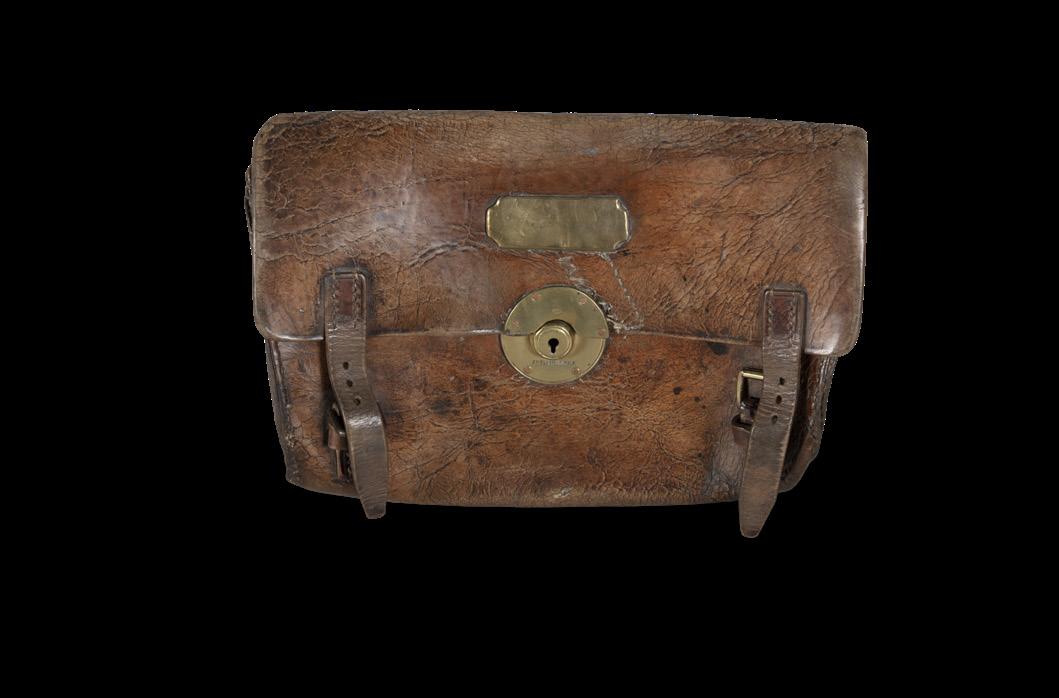
31
A BROWN LEATHER CARTRIDGE SATCHEL, with brass mounts and name plate inscribed T.E Burrows Esq, 29cm x 22cm
€ 200 - 300

32
A LARGE LEATHER TROLLEY TRUNK, 19TH CENTURY, with hinged lid and carry handle, straps and buckles, 50cmx x 45cm x 40cm

33
A VICTORIAN LEATHER GLADSTONE BAG BY DREW & SONS, PICCADILLY, LONDON, with brass fastenings, 70cm wide
€ 800 - 1,000

35
A BROWN LEATHER TRAVELLING TRUNK BY DREW & SONS, PICCADILLY, LONDON, 19TH CENTURY, the hinged top with strap stamped revealing a plain interior bearing the initials R.M.W, 55cm x 25cm x 37cm
€ 500 - 800
€ 200 - 300

34
A BROWN LEATHER CARTRIDGE CASE, EARLY 20TH CENTURY, with carrying handle, the case inscribed MAISON MONSIOUR HANCOCK, ROYAL FUSILLIERS, the interior of the case timber lined and , 29cm x 30cm x 9cm
€ 150 - 250
36

A FAUX LEATHER TRAVEL TRUNK of rectangular form, with metal mounts, stained timber lined interior and base. 32cm high, 59cm wide, 30cm deep
€ 50 - 100

37
A NEEDLEWORK TAPESTRY DEPICTING THE DEFEAT OF THE SPANISH ARMY NEAR THE CANAL OF BRUGES BY FRENCH TROOPS OF LOUIS XIV
174cm x 262cm
38
A PAIR OF WILLIAM IV MAHOGANY AND GREEN LEATHER LIBRARY ARMCHAIRS, each with button-back upholstery and armrests with brass studding on arched legs and brass castors, 99cm high
€ 2,500 - 3,500

A Portrait of Captain Byron Oil on canvas, 126 x 100cm
Provenance : Sale, these rooms, 11 Oct 2016, Lot 459
€ 20,000 - 30,000 40



John Byron (1723-1786), British vice-admiral, the second son of the 4th Lord Byron, and grandfather of the poet, was born on the 8th of November 1723. He joined the navy as a midshipman but would go on to be considered one of the finest sailors in all of England; despite his dogged bad luck for which he received the nickname of ‘Foul Weather Jack. During one of his expeditions he was wrecked on the southern coast of Chile but survived and proceeded to write up his adventures as ‘The Narrative of Hon. John Byron, Containing an Account of the Great Distresses’ (1768), which his grandson, George Gordon Byron, used in his satirical poem ‘Don Juan’ (1819-1824). Habitually in action against the French, he was chosen to command a secret British expedition in the Dolphin frigate - one of the first British ships to have a copper sheeted hull - to the Falkland Islands to break into the Spanish trade. Afterwards, he completed the circumnavigation of the globe, claiming various Pacific islands for the Crown.
The provenance of the present example is by repute with Torridon House in the Scottish Highlands, the estate, which once belonged to the Duke of Leeds and is now home to the Earl and Countess of Lovelace, sandwiched between rugged, soaring mountains and the deep blue of a sea loch. The family auctioned the contents of the house in 2015 offering a wonderful collection of furniture, paintings and other works of art to the public. The connection with the Byron family resulted from the marriage between Lord King William who married Augusta Ada Byron, the only legitimate daughter of George Gordon, 6th Baron Byron. The Lovelace title was chosen to mark the fact that Ada was, through the families of Byron, Milbanke, Noel and Lovelace, a descendant of the Barons Lovelace of Hurley. This union brought the promise, in marriage settlement, of vast estates in the Midlands and also political advantage, for Adas cousin was Lord Melbourne, the Whig Prime Minister.
In this quarter-length portrait Byron is presented in an appropriate manner of attire wearing his captain’s undress uniform and a grey wig. He is set against a dark clouded filled background, with a small patch of light blue sky out of which sails a ship from the British Fleet. Byron strikes a formidable presence in this portrait reflecting his many successive years of dedicated and hard service. The numerous long and arduous expeditions is succinctly captured in the line inscribed on the frame, from Byron’s poem, Epistle to Augusta, ‘Our grandsires fate of yore /He had no rest at sea’.
Joshua Reynolds (1723-1792) was apprenticed in 1740 to the portrait painter Thomas Hudson, (170190) and after early work in his native Devon travelled to Italy in 1749. He returned in 1753 to London and rapidly began to establish himself as a portrait painter, profoundly influenced by his time in Italy. He was the most influential figure of the century in elevating British portraiture painting. Reynolds borrowed poses from the old masters, as evidenced by Lord Byron’s strong stance with arms crossed and his left hand holding onto the sword hilt, a pose which dignified the status of the sitter.

41
A PAIR OF MAHOGANY AND GILT DECORATED BOXES
of shaped rectangular from, the plain tops over a frieze of faux book spines, inked with roman numerals. 24.5cm high, 40cm wide; 22cm deep
(1 - 14; missing no. 11; with two no. 4s)
€ 500 - 800



42
AN ITALIAN WALNUT, TORTOISESHELL AND BONE INLAID CENTRE TABLE, 19TH CENTURY
the rectangular top with compartments of marquetry panels depicting mythical figures and animals, bordered by a thumb-moulded edge and supported on splayed bobbin-turned legs joined by stretcher. 68cm high, 84cm wide, 52cm deep
€ 1,200 - 1,800
Newton’s New and Improved Terrestrial Globe; together with New & Improved Celestial Globe, London Published 1853 both supported on an engraved brass arc and turned mahogany base, each globe made up of twelve hand-coloured engraved gores and two polar calottes. 36cm high, 20cm diameter (2)
The Newton family ranks among the foremost globe makers. John Newton (1759–1844), who trained under Thomas Bateman, established his own globe-making enterprise in 1780. In the early 19th century, John, together with his second son, William Newton (1786–1861), relocated to 97 Chancery Lane, where they traded under the name J & W Newton. From 1831 to 1841, the company expanded to include civil engineer Miles Berry as a partner, operating under the name Newton, Son and Berry. Following 1841, ownership passed to John’s eldest son, William Edward Newton (1818–1879). As was customary among prominent globe makers of the period, the Newtons updated their globes to reflect the latest geographical discoveries and astronomical data by applying newly published paper gores. This practice accounts for the varying dates that may appear on globes from their workshops.
€ 1,500 - 2,000

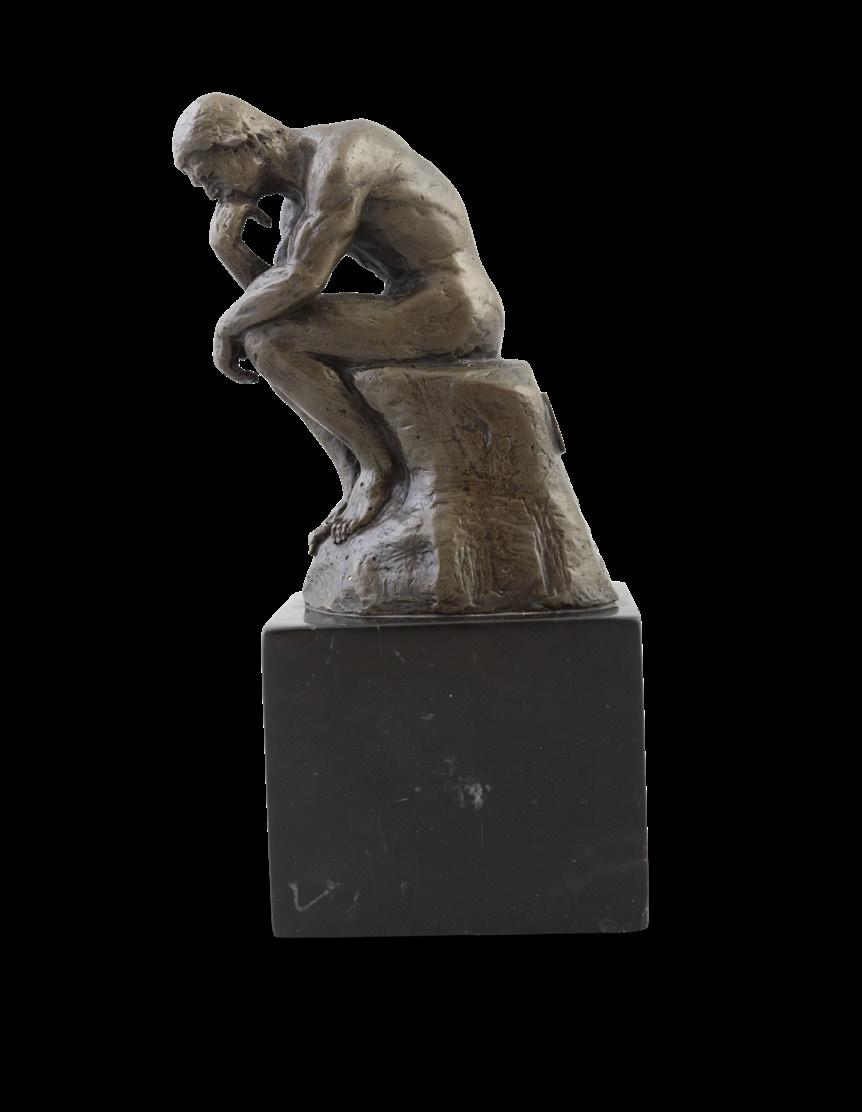
AFTER AUGUST RODIN (1890-1917)
The Thinker
Bronze, 19cm (including base)
Signed and numbers ‘Rodin 1233’ with foundry mark ‘J B
Deposee Bronze Garanti Paris’
€ 100 - 200

TWO BRASS CANNONS WITH STAINED-WOOD CARRIAGES
One 18cm high, 35 cm long, including barrel, 19 cm deep
€ 1,000 - 1,500


46
the rectangular top with tooled brown leather inset, the base with fitted with three frieze drawers to each side, with inventory mark for Liverpool University, the pedestals each with three deep drawers and turned button handles on a plinth base. 75cm high, 150cm wide, 95cm deep
€ 1,500 - 2,000

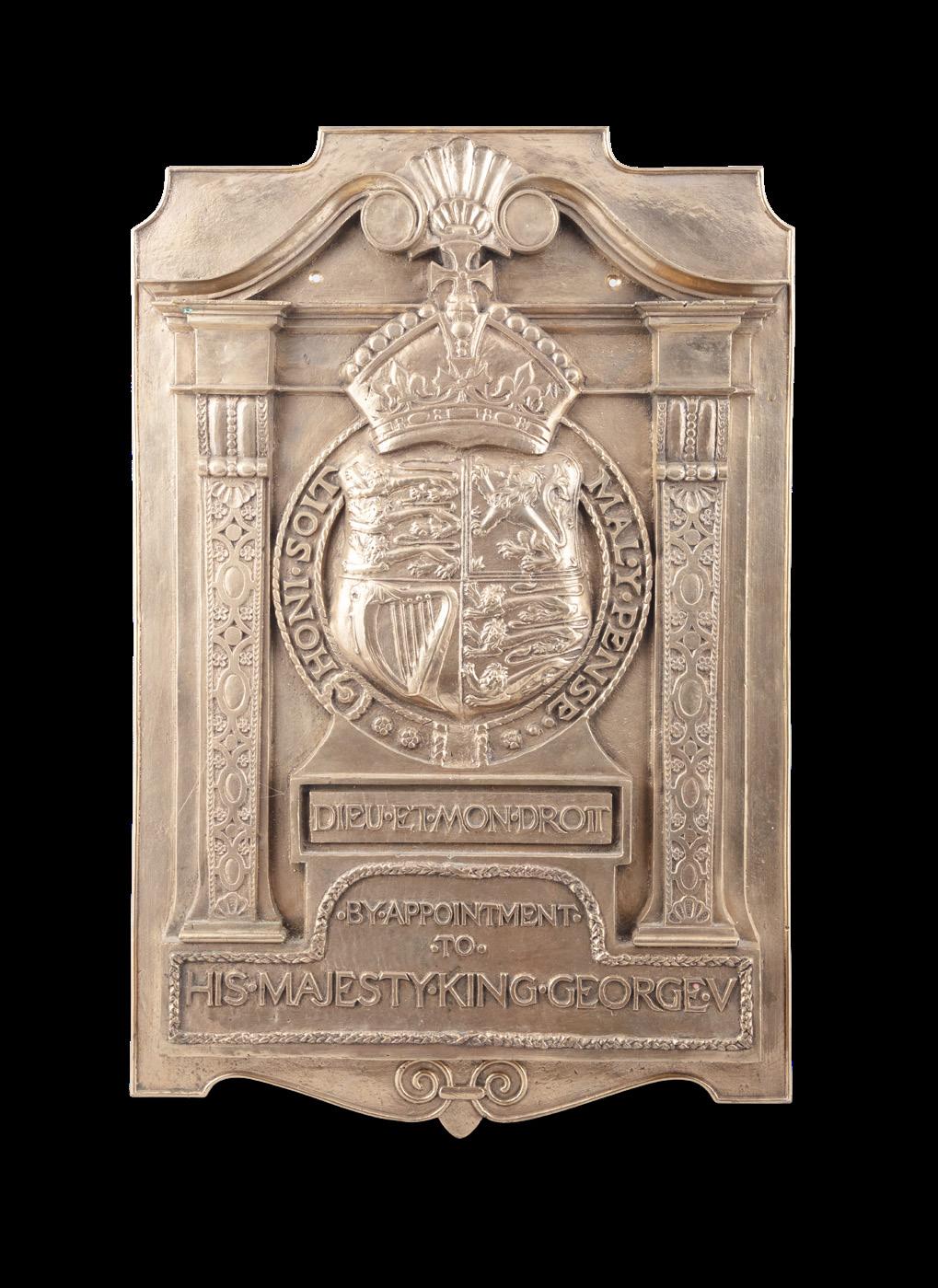
49
A VICTORIAN BRASS FRAMED AND WIREWORK NURSERY FENDER, 83cm high, 137cm wide, 40cm deep; together with irons and a pair of fire dogs
€ 300 - 500
47
A BRITISH ROYAL WARRANT PLAQUE, 20TH CENTURY
a bronze plaque bearing the royal arms of King George V, inscribed ‘By Appointment to His Majesty King George V’. 66cm high, 43cm deep
€ 1,000 - 1,500
48
A PAIR OF IRISH GEORGE III STYLE MAHOGANY PEAT BUCKETS
each brass bound with ring handles, ribbed sides and removable liners, 46cm high, 38cm wide
€ 1,200 - 1,800



A NEO-CLASSICAL STYLE CARVED BEECH FIRE SURROUND, 20TH CENTURY, with moulded mantle top, above a frieze with Classical portraits, urns and rosettes, the upright with acanthus leaves and trailing bellflowers on a block plinth base, 135cm high, 166cm wide
€ 800 - 1,000
A POLISHED BRASS CLUB FENDER, 20TH CENTURY
with button back and close nailed seat upholstered in black fabric, with dipped central section, raised on upright tubular supports, plinth base.
51cm high, 202cm wide (interior 170cm wide), 49cm deep (interior 33cm deep)
€ 2,000 - 4,000
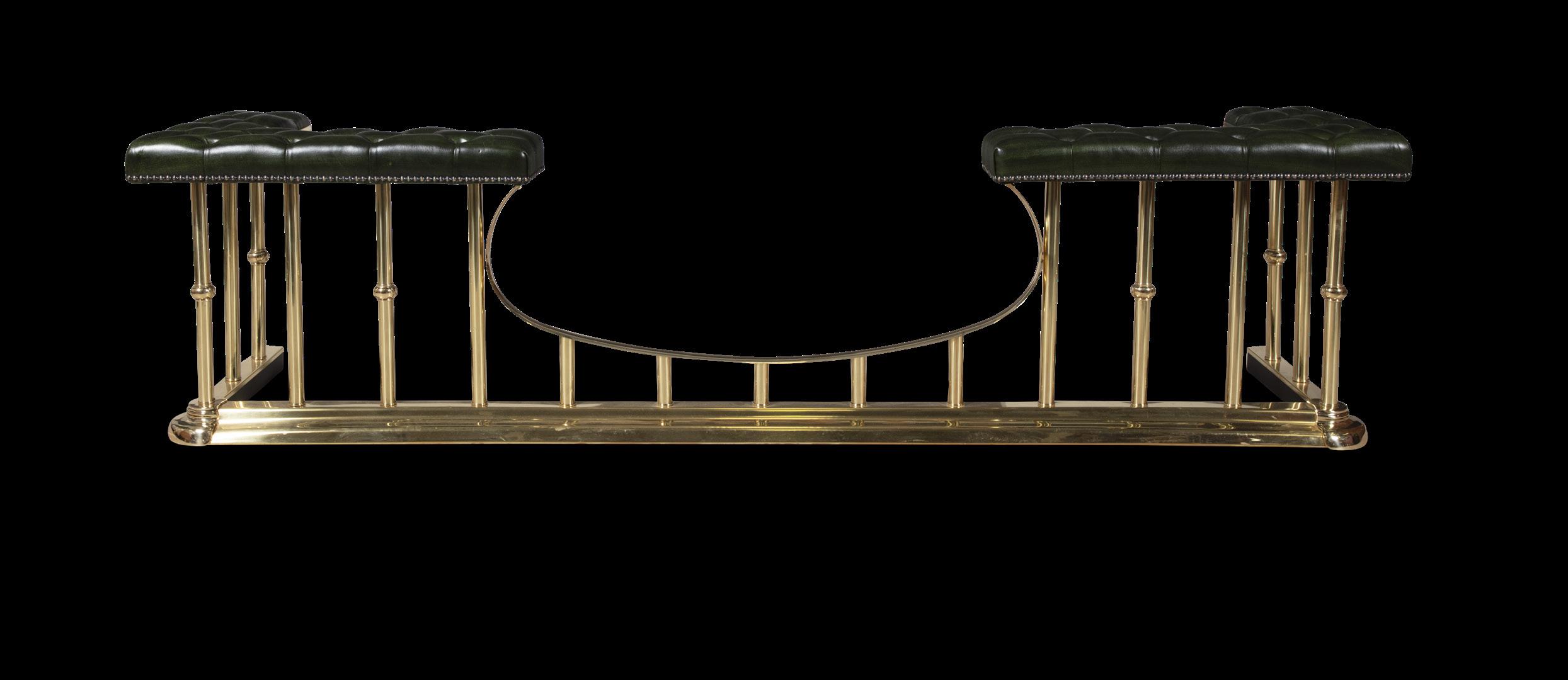
A CARVED MARBLE HEAD OF A PHILOSOPHER, POSSIBLY ROMAN PERIOD, of life-size proportions with full beard and hair radiating in crescentic locks.
47 x 24cm
Provenance: Private collection, Ireland, since circa 1940’s
€ 1,000 - 1,500
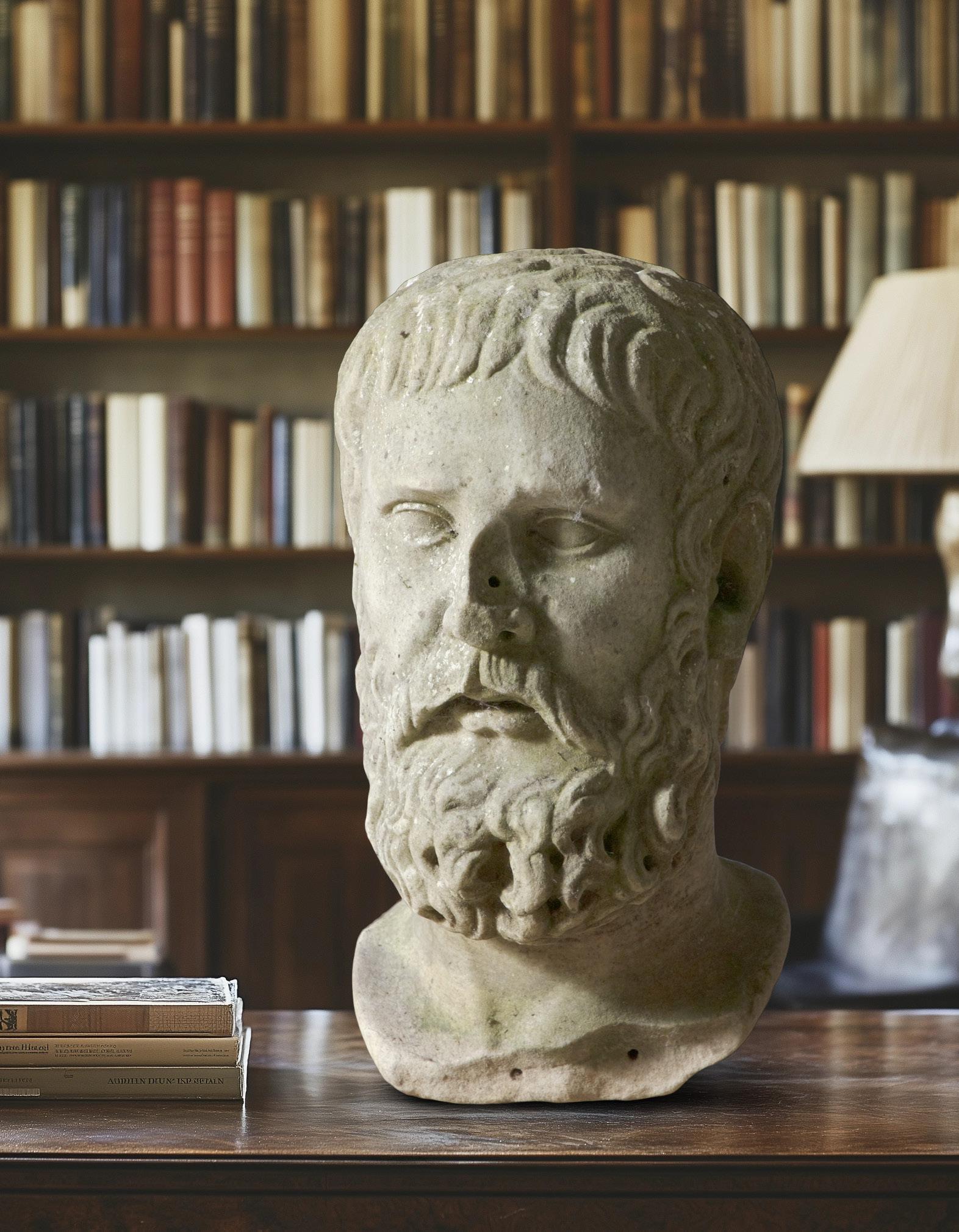
53
A CARVED MARBLE CORINTHIAN CAPITAL, POSSIBLY ROMAN PERIOD, with acanthus decoration adorning the front, the rear quarter uncarved. 40 x 42cm
Provenance: Private collection, Ireland, since circa 1940’s


54
A CARVED MARBLE STELE, POSSIBLY ROMAN PERIOD, the front panel carved with Latin text, the right side with oenochoe and left with patera on a shallow stepped base. 65hm high x 26cm wide x 23cm deep
Provenance: Private collection, Ireland, since circa 1940’s
€ 600 - 800
55
AN ITALIAN 19TH CENTURY TERRACOTTA GARDEN URN
of circular baluster form, with out-turned leaf carved rim, the body with beaded banding, and applied leaf decoration, raised on socle and plinth base. 56cm high x 50cm diameter
€ 400 - 600
55A
A PAIR OF BRONZE MODELS OF RECUMBENT SPHINXES,
each in traditional form and raised on a rectangular plinth bases, 60cm high, 85cm long, 25cm wide
€ 4,000 - 6,000



56
AN EDWARDIAN POLISHED BRASS TALL HAT AND COAT STAND, C.1896 raised on slender side columns above a compartmented umbrella and stick stand on black metal base, stamped with registration mark no. 271825. 202 cm high, 57cm wide.
€ 1,500 - 2,000

TWO VINTAGE LEATHER HAT BOXES,

58
A VINTAGE BROWN LEATHER HAT BOX BY SCOTT & CO. PICCADILLY, LONDON, containing a hat by Blake, case stamped G.G.F. 34cm x 26cm 22cm
€ 100 - 200

AN ART NOUVEAU COPPER AND BRASS LEAF CAST JARDINIERE ATTRIBUTED TO W.A.S. BENSON, of cylindrical form, fitted with zinc liner. 38 cm high.
€ 700 - 1,000

and floral vines within a larger main border of floral vines and two guard stripes.
Provenance: Formerly with Peter Linden, Blackrock, with certificate
€ 800 - 1,200


61 A GEORGE IV MAHOGANY BREAKFRONT BOOKCASE, with moulded cornice and a brass Greek key banded frieze above eight lancet glazed panel doors enclosing adjustable shelving, the conforming base with rosewood banded fielded panel doors on a platform base. 160cm high, 362cm wide, 45cm deep
€ 7,000 - 10,000

William Blackwood, Edinburgh & Baldwin, Cradock & Joy, London. Marbled boards, leather spine.
€ 800 - 1,200
63
GROSE FRANCIS,
The Antiquities of Ireland. London 1791, S. Hooper, Two vols. Complete hardcover in full black calf with raised bands of gilt title and decoration to spine, marbled end papers 4to
€ 300 - 500
64
TRACTS ON THE UNION OF IRELAND
Vol I & II, 1798 - 99. Dublin printers. Vol I includes 10 pamphlets; 9 in Vol II. 8vo. Green leather boards, gilt ribbed spine
Some first edition pamphlets, comprehensive collection of arguments of arguments relating to the Union.
€ 300 - 400
65
SWIFT, JONATHAN


Miscellanies. 14 volumes, London 1736 - 1746; Full calf. Ribbed spines
€ 500 - 700
Please see www.adams.ie for full description

66
GROSE, FRANCIS
The Antiquities of England & Wales. London, S. Hooper, 1773 - 87. Vol I -VI , including supplementary volumes. 4to. Polished calf, spines ribbed.
€ 400 - 600

67
ITALIAN SCHOOL, 19TH CENTURY
Portrait bust of a young boy On circular socle, 35cm high Carrara marble Signed indistinctly
€ 600 - 800
Maud, and other poems. London, Edward Moxon, 1855. 1st edition. 12mo. Half calf. Ribbed gilt spine
€ 300 - 500

70
ELIOT, GEORGE
Felix Holt. The Radical. Edinburgh, William Blackwood and Sons, 1866. 3 vols. 1st edition. Half calf, Morocco boards. Ribbed gilt spine. Fine
€ 300 - 50


Three Musketeers, trans. William Robson. London, Routledge, Warne & Routledge, 1862 . Half calf, marbled boards ;together with BRONTE, ANNE [PSEUD. ACTON BELL]
The Tenant of Wildfell Hall. London, Smith, Elder & Co., 1859. Half calf, marbled boards; SWINBURNE, CHARLES ALGERNON Poems & Ballads. London, John Camden Hotten, 1866
(3)
€ 200 - 300

The Reverie: Or, a Flight to the Paradise of Fools. London, 1767. 8vo. 2 vols. 2nd ed. Spines with gilt motif and black and red morocco. Armorial bookplates of Verdon Evans
€ 150 - 250
ABEL BOYER (ATTRIB.)
The English Theophrastus: or, the manners of the age. Being the modern characters of the court, the town, and the city. London, 1702. 1st ed. 8vo. 1 vol. According to ESTC page numbers 145-160 omitted, but text and register are continuous. Rebacked. Full calf with raised bands and gilt title to spine. Frontis and adverts; together with
XENOPHON OF ATHENS (c.BCE 430 - BCE355/354)
De Cyri Institutione [Education of Cyrpus}. Ex. latin interpretation by Joannis Leunclavii Amelburni. London, 1720. 8 books contained in one volume. Greek and Latin text. 8vo. Full calf. Ribbed gilt spine
€ 150 - 250
73 THE DUKE OF WESTMINER’S COPY. BINDINGS. GASKIN, J.J.
The Viceregal Speeches And Addresses, Lectures and Poems of the Late Earl of Carlisle, K.G., D. Dublin, McGlashan & Gill, 1866. Green Morocco with gilt fillet borders, gilt spine in panels, raised bands, with book plate of Duke of Westminster & with gilt armorial on front cover, by Holloways.
€ 120 - 180
The History of Tom Jones, A Foundling. In four volumes. London , A Millar, 1749. Fourth Edition. 12mo. Full calf. Rebound
€ 300 - 500




The Backgammon Players Oil on panel, 26 x 40.5 cm
Provenance: Senator Edward McGuire, Newtownpark House, Blackrock, thence by descent
€ 2,000 - 3,000
the interior with poker and penwork decoration depicting Old Testament scenes possibly the Judgement of Solomon, the floor of the interior branded with inventory of merchant’s or maker’s mark, with later brass carrying handles to each side, 59cm high, 178cm wide, 59cm deep


77
the square section centre with assorted marble specimens and a parquetry border, flanked by lidded counter compartments with chess playing pieces, on fluted trestle end supports and castors, 76cm high, 79cm wide, 55cm deep
€ 1,500 - 2,500


78 A MAHOGANY FRAMED CANEWORK BERGERE
with loose cushion seat on sabre legs with brass socks. 93cm high, 63cm wide, 75cm deep
€ 700 - 900
Russian icons, central to Orthodox worship, developed after the Christianisation of Rus’ in 988, drawing on Byzantine models. The earliest surviving works include 11th-century mosaics and frescoes in St. Sophia Cathedral, Kiev. By the 12th century, regional schools in Novgorod and Vladimir produced panel icons alongside monumental painting.
The Mongol invasion (1237–1480) disrupted production, but revival followed in the late 14th century with Theophanes the Greek (c.1340–c.1410), whose dynamic style is seen in his 1378 frescoes in Novgorod. The Moscow school dominated the 15th century under Andrei Rublev (c.1360–1430), creator of the Trinity (c.1410–25, Tretyakov Gallery), and later Dionisius (c.1440–1502), whose refined manner is exemplified at Ferapontov Monastery.
In the late 16th and early 17th centuries, the Godunov and Stroganov workshops, supported by elite patrons, advanced intricate miniature styles. By the mid-1600s, Simon Ushakov (1626–1686), working at the Kremlin Armoury, introduced Western elements, marking the close of the medieval tradition under Peter the Great. The Temple Gallery, London, founded in 1959 by Richard Temple—described by Byzantinist Kurt Weitzmann as “the foremost dealer in icons” — has supplied works to institutions including the British Museum, the Louvre, and the Menil Collection, and remains a leading authority in Byzantine and Russian icon art.
79
RUSSIAN SCHOOL, 19TH CENTURY
Icon of Virgin and Child
Housed within silvered oklad and kyot
Overall 36 x 31cm
€ 250 - 350
80
RUSSIAN SCHOOL, 19TH CENTURY
An Icon of St. Nicholas
Contained within Kyot
27 x 22cm; Overall case: 61 x 44cm
€ 300 - 500



81
BULGARIAN ICON, CIRCA 1800
Triptych with Virgin and Child and Saints
27 high x 18cm centre panel , 38cm wide, overall
Provenance: With The Temple Gallery, London, where acquired
€ 400 - 600
82
RUSSIAN SCHOOL, 19TH CENTURY Deesis, triptych Brass and enamel, 13.5 x 35.7cm
Provenance : With The Temple Gallery, London, where acquired November 2010
€ 400 - 600

83
RUSSIAN MSTERA SCHOOL, 19TH CENTURY Entry into Jerusalem Panel, 31.4 x 27.2cm
Provenance: With The Temple Gallery, London, where acquired May 2008
€ 800 - 1,200
84
RUSSIAN ICON, 19TH CENTURY Virgin of Kazan, Panel, 36 x 31cm
Provenance: With The Temple Gallery, London, where acquired
€ 500 - 800
85
RUSSIAN ICON, 19TH CENTURY Resurrection Panel, 33.3 x 27cm
Provenance: With The Temple Gallery, London, where acquired December 2007
€ 500 - 800





86
RUSSIAN SCHOOL, 19TH CENTURY
Saint Nicholas, parcel-gilt and oil on panel 36 x 31.1cm
Provenance: With The Temple Gallery, London, where acquired November 2007, no. 22
€ 700 - 1,000
87
A RUSSIAN ORTHODOX ICON, CIRCA 1600
Saint John the Baptist, tempera on panel 31.7 x 26.7cm
Provenance: With The Temple Gallery, London, where acquired November 2007, no. 21
€ 1,000 - 1,500

88
Madre della Consolazione Tempera, tooled gold leaf and gesso on panel, 42 x 32cm
Provenance: By repute Princess Olga Sherbatov; Cornelius Bousie, Esq.; With The Temple Gallery, London, where acquired May 2006, no. 3
This icon type relates to the work of Nicholas Tzaphouris (active 1480-1500).
€ 3,000 - 5,000
FRANZ LUDWIG HERMANN (GERMAN, 1723-1791)
The Dedication of the Temple of Solomon Oil on canvas, 173 x 354cm
Signed and inscribed “Invenit & Pinxit Anno MDCCXX”
€ 5,000 - 8,000

Franz Ludwig Hermann was thought to have been born in Ettal, Bavaria in 1723, although 1710 has also been suggested as his date of birth. Not a great deal has been written about his life, however we do know he was the son of the painter Franz Georg the Younger (1692–1768), with whom he received his artistic training. Ludwig Hermann was educated at the Noble Academy of the Ettal Benedictines. After he married in 1750, he predominantly lived and worked in the Lake Constance region, where he is said to have painted ceiling frescoes in more than twenty churches. Hermann was also a court painter for the Prince-Bishopric of Constance, a small ecclesiastical principality of the Holy Roman Empire.
One of Hermann’s many commissions around lake Constance, was Münsterlingen Abbey. In fact, the only work by Herrmann in a UK public collection is a portrait of Anna Gertrude Hofner, Abbess of Münsterlingen, which is housed in the Bowes Museum, Durham. While a drawing titled The Archangel Michael Banishing Vice, from 1782 is held in the Metropolitan Museum, New York.
Monumental in scale, The Dedication of the Temple of Solomon (1760) is one of several known works Hermann created depicting King Solomon. Solomon was the son of David and is believed to be responsible for undertaking construction of the First Temple and home for the Ark of the Covenant on what it thought to be the site of the present-day Temple Mount, where the Dome of the Rock presides in Jerusalem.
The painting depicts a fantastical view of the Temple, where early Jewish iconography sits alongside more contemporary Italianate Mannerism. The viewers’ attention is drawn primarily to the large plume of smoke arising from the centre of the picture, which symbolises an overpowering cloud that interrupted the dedication ceremony as a sign from God, indicating Solomon’s success in creating an exalted house and seat for the Ark.
Solomon kneels in the foreground as he leads the assembly in prayer, flanked by lion cubs, soldiers and an entourage. The dedication was concluded with musical celebration and sacrifices said to have included twenty-two thousand bulls and one hundred and twenty thousand sheep.
Much of the architectural language in the painting is borrowed from 17th century prints such as those of Jan Luyken (Amsterdam 1649-1712). We see objects associated with historical accounts of the Temple such as the raised sacrificial alter and Brazen Sea, a large bronze sculpture that stood in the Inner Court of the Temple and was formed of twelve oxen beneath a large basin. We can also see the ten bronze lavers present in the composition, which are described in the bible as being placed around the Temple building itself, five on the north side and the other five on the south, being used for washing the hands and feet of the priests before ritual service.
The bottom flanks of the picture are filled with attendants, minstrels and perhaps merchants. Whilst the door of the temple is open and we catch a tantalising glimpse inside its gilded entrance hall, which led the way to the most sacred room of the Temple, the Holy of Holies, which in turn housed the Ark of the Covenant, the sacred relic for both Christians and the Israelites, containing the two stone tables bearing the Ten Commandments.


The Last Communion of St. Jerome Oil on canvas, 212 x 130cm
€ 1,000 - 2,000

91 AFTER RAPHAEL, 19TH CENTURY
The Transfiguration Oil on canvas, 200 x 134cm
€ 1,000 - 2,000



This type of bureau writing desk, designed for both seated and standing use, was supplied by Gillows of Lancaster. They were provided for accounting firms as well as for gentleman libraries. The alphabet-inlaid drawers and fall front, supported by quadrants, reflect a style popularized by Thomas Shearer’s The Cabinet Maker’s London Book of Prices (1788–1803).
An early example was made by David Wright who was a journeyman, working in Gillows Lancaster, in August 1751 - now in the Victoria & Albert Museum. During the late 18th century, Gillows produced numerous variations of this desk form. A desk of this model, dated circa 1790 and with the impressed stamp: ‘GILLOWS LANCASTER’, is illustrated in S. Stuart, Gillows of Lancaster and London, 1730-1840, 2008, p.282, pl.296. A pattern for a very similar desk with a rising ratchet-supported top and ‘turn down’ front features in the firm’s 1798 Estimate Sketch Book (no. 1481) preserved in the Westminster City Archives.
The present example closely relates to a design supplied to Mr. Dickinson in which was later modified by Gillows at the customer’s request. In a letter from Richard Gillow dated 1766, it was suggested that the desk’s appearance and structural strength would be improved by incorporating three drawers beneath the top, supported by rails, instead of the two drawers originally requested by Dickinson. While the letter also references the use of castors to allow furniture mobility within a room, Mr. Dickinson chose not to include them, resulting in a desk with an unfinished back, requiring placement against a wall. In contrast, this example lacks castors and has a fully finished back, though it retains the extra framed top, which could be raised for more comfortable standing use. A nearly identical desk was produced for Williams Hassell of Penrith in November 1774.
A closely related desk to this lot sold in Bonhams, London 12 June 2013 for £18,750 including premium.

the rectangular adjustable ratchet-action top inset with green leather scriber, above a faux drawer fall-front pull-out secretaire section, having baise lined writing surface sliding back to reveal a fitted interior with alphabetised compartments, above a central cupboard door flanked by six short pedestal drawers stamped ‘GILLOWS LANCASTER’. 95cm high, 130cm wide, 71cm deep
€ 6,000 - 8,000

94
A MAHOGANY AND BUTTON BACK LEATHER READING CHAIR, 19TH CENTURY, the curved back with turned spindle supports, broad seat, tapering legs with brass castors.
AN EARLY VICTORIAN BOBBIN-TURNED ROSEWOOD ARMCHAIR, the padded rectangular back and seat covered in an Aztec pattern fabric with padded armrests and turned tapering legs ending in brass castors
€ 600 - 1,000


of compact proportions, each with curved back, outward turned arms with brass studding with loose cushion seat on turned legs and castors. 77cm high, 68cm wide
€ 2,500 - 3,500



98
A VICTORIAN FINE BURR WALNUT AND MARQUETRY INLAID CENTRE TABLE, C.1840 STAMPED HENRY WOOLEY, 97 NEW BOND STREET, LONDON
the circular top with floral marquetry bouquet and ebon crossbanding similarly inlaid with further flower groups , on a carved scrollwork tripod base, 54cm diameter
€ 2,000 - 4,000
96
A SILVER ‘EGYPTIAN AND NUBIANS’ CHESS SET AND CHESS BOARD, SPANISH 20TH CENTURY,
modelled as opposing forces, each piece stamped ‘STERLING SILVER’ to the base and with monogram C. CMJ, the pawns stamped MOD. PAT. Height of Egyptian King 11.4cm high; the chessmen contained within a fitted box, the top converting to a chess board, with applied metal mounts and plaque “No. 12-2, Promotor: Alberty Joyeros, S.A., Autor: Jose M. Calero”.
The Board 40.5 x 40.5cm, the Box 47 x 47cm, contained within fitted case with handle
€ 2,500 - 3,500
97
AN EARLY VICTORIAN WALNUT AND BRASS MOUNTED DECANTER BOX
the hinged cover enclosing a gilt tooled leather interior fitted with five squared and labelled decanter bottles each with facet cut globular stoppers amongst an arrangement of small shot and liquor glasses. 24cm high x 30cm wide
€ 500 - 700

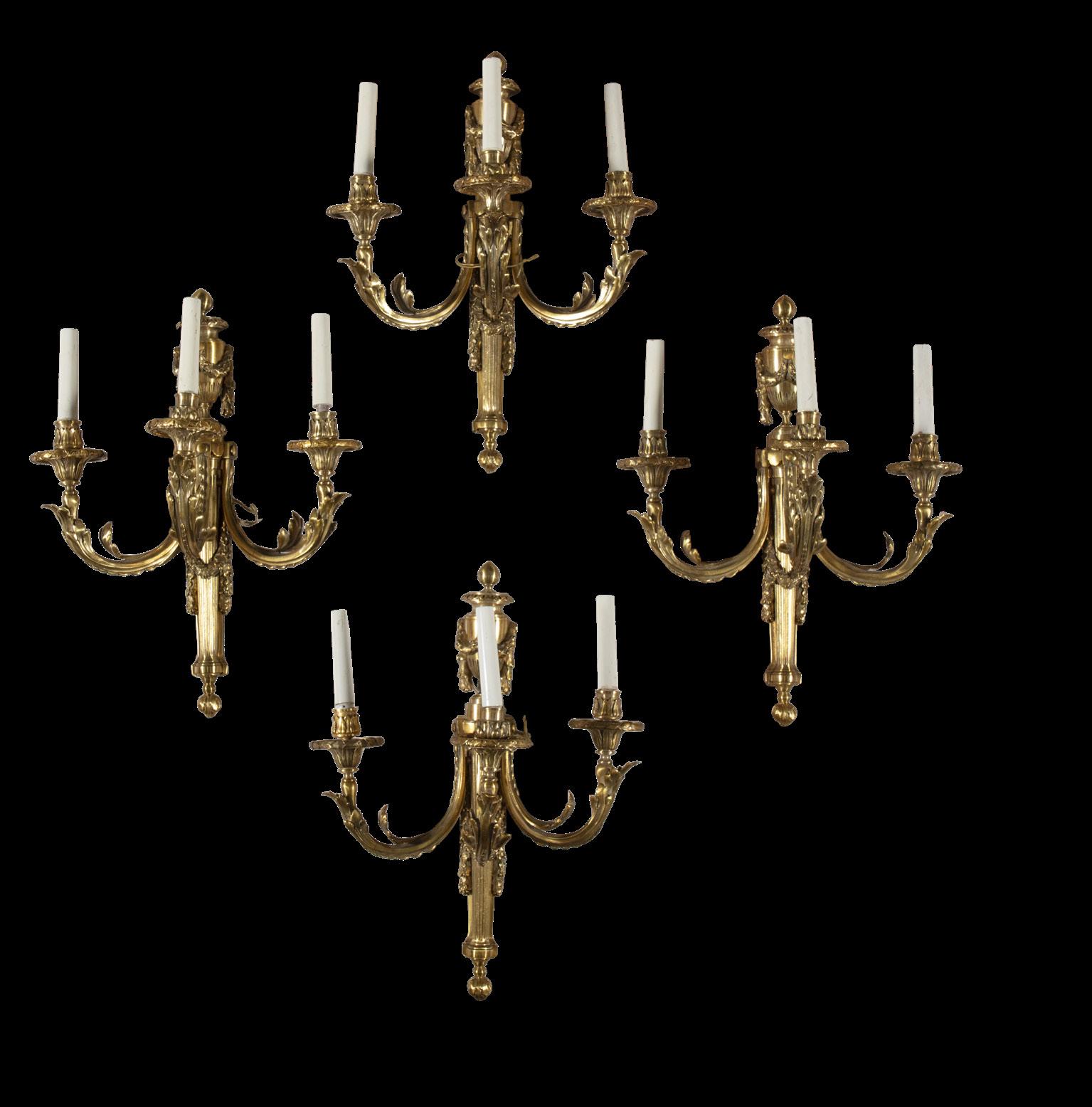
A SET OF FOUR FRENCH LOUIS XVI STYLE GILT BRASS WALL SCONCES
each with three upturned branches with light sockets and faux candle sleeves, the back plate cast as a classical urn and fluted pilaster. 57cm high
€ 3,000 - 5,000

signed ‘Straub & Hebting, London’, with inverted bell shaped hood surmounted by brass urn finials, with sunburst grill panels to each side, the arched glazed door enclosing a gilt dial face with white enamel chapter inked with roman numerals, subsidiary chime and regulation dials, applied with swag and mask decoration, on claw feet, with pendulum and winding key. 72cm high (to top finial), 40cm wide, 26cm deep
€ 1,500 - 2,500
101
A VICTORIAN BUTTON BACK CHESTERFIELD SOFA
with scroll arms, upholstered in a green fabric with spiral trimming, on short bun feet and castors. 67cm high, 206cm wide, 58cm deep
€ 1,000 - 1,500


102
VINCENT HADDELSEY (1934 - 2010)
Redbourne Hall Gates Gouache on canvas, 47 x 61cm
Signed with initials VH lower left; signed verso
With Arthur Toothe & Sons (according tolabel verso)
€ 700 - 1,000
103
A LATE GEORGIAN MAHOGANY HUNT TABLE, extending to oval form, the solid panel top and drop leaf side with moulded edge on square gate leg action supports. 73cm high, 192cm wide, 132cm (when fully open)
€ 2,000 - 3,000


104
A PAIR OF FRENCH GILTWOOD AND CREAM-PAINTED BOISERIE PANELS, 19TH CENTURY
each with carved scrolls centred by musical trophies, 72cm high, 189cm wide, 7cm deep
Provenance: Westland, London, where acquired
€ 2,000 - 3,000
105 AN ANTIQUE ROUGE MARBLE WATER FONT
c.30cm high, 26cm wide
€ 500 - 700
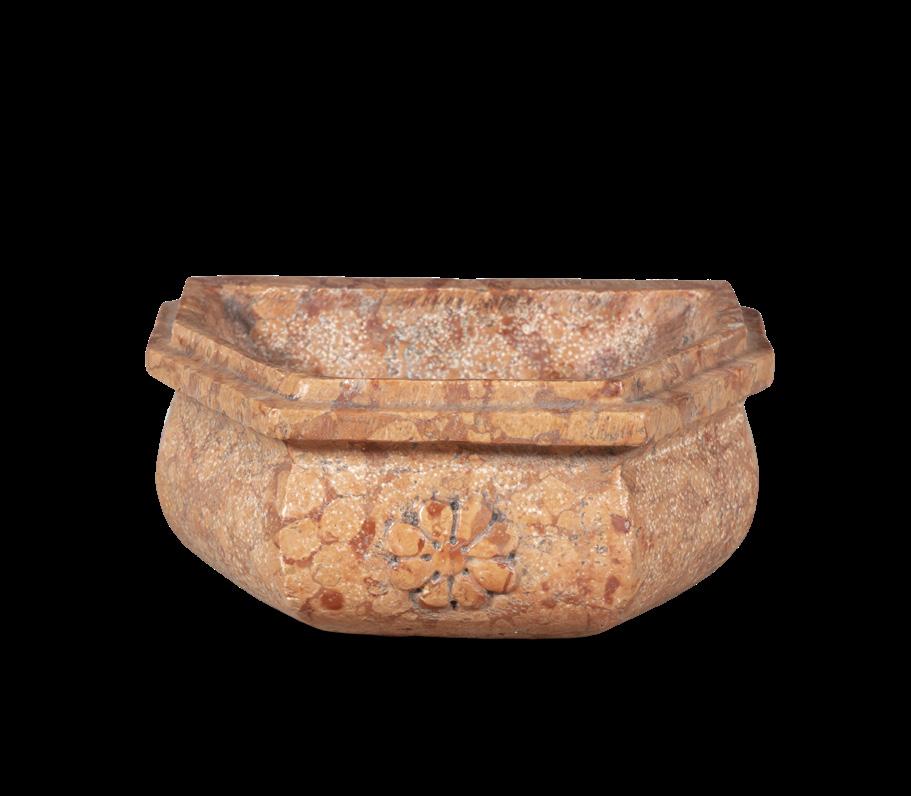
107
A PAIR OF MARBLE STATUES OF RECUMBENT LIONS
c.20cm high, 37cm wide, 18cm deep
€ 800 - 1,200
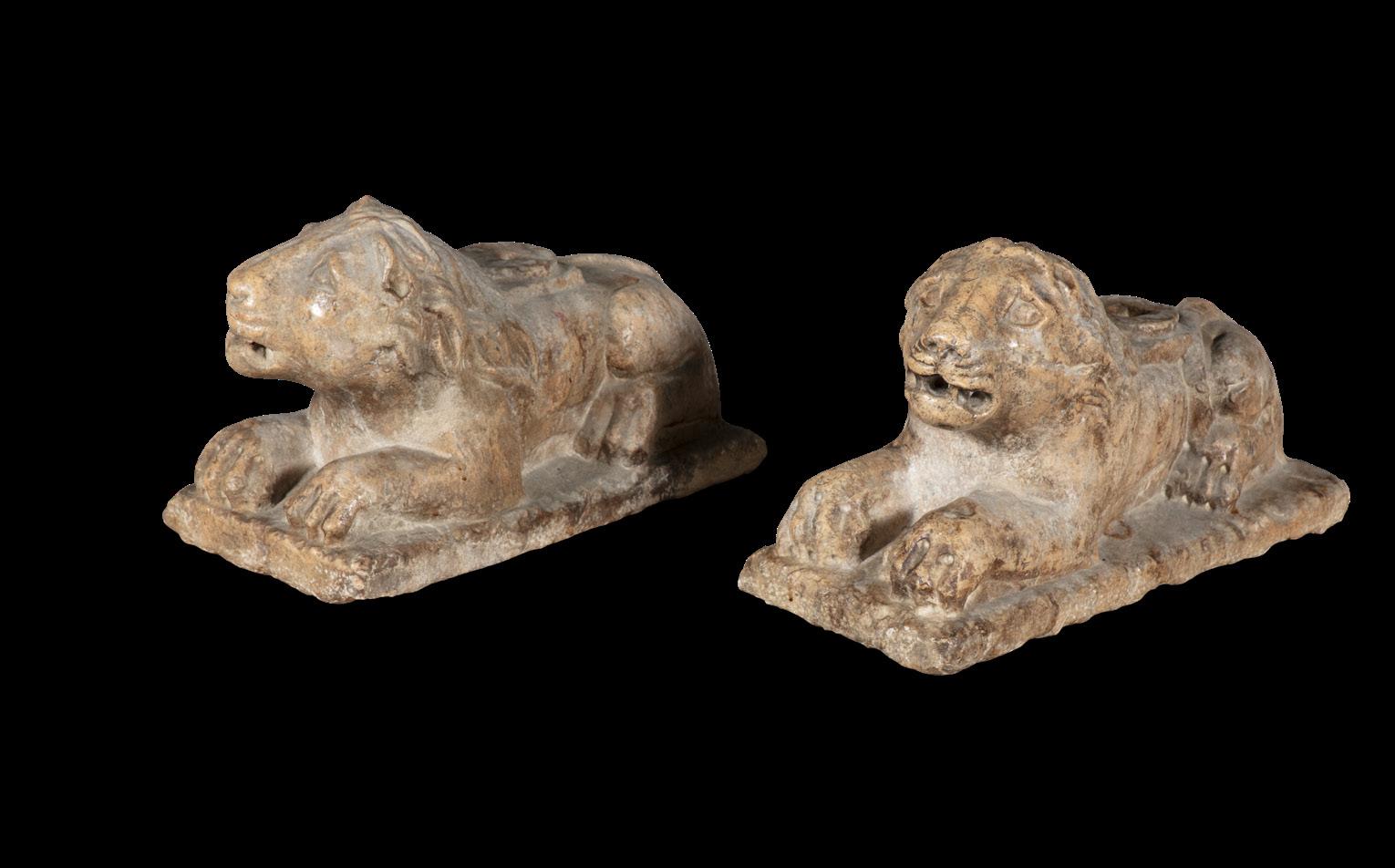

108
A SARREGUEMINES MAJOLICA PORELCAIN
Sarreguemines Pottery was founded around 1790 by Nicholas-Henri and Paul-Augustin Jacobi, along with Joseph Fabry. The company gained prominence under Paul Utzschneider, who took over management in 1800 and established its reputation for exceptional majolica work, making Sarreguemines a key centre for European ceramics. Notably, its tiles were used in the Paris Métro, inaugurated in 1900. In 1836, Utzschneider’s son-in-law, Alexandre de Geiger, assumed leadership, later partnering with Villeroy & Boch to expand operations during the industrial revolution. Following the annexation of Moselle by Germany in 1871, de Geiger relocated to Paris, leaving the factory to his son, Paul de Geiger, who oversaw the establishment of new facilities in Digoin and Vitry-le-François. Despite its historical influence, Sarreguemines ceased production in 2007.
Celebrated for its avant-garde designs and vividly glazed ceramics, the company’s creations—including pedestals, jardinières, and fountains— demonstrated extraordinary craftsmanship. During the late nineteenth century, European ceramic trends embraced revivalist styles and the rise of Art Nouveau, Aestheticism, and the Arts and Crafts Movement, featuring botanical and animal motifs reflected a vibrant artistic and cultural era in which Sarreguemines played a significant role.
WALL CLOCK BY ALEXANDRE DE GEIGER (18081891) & PAUL DE GEIGER (1837 - 1913), C.1875
circular glazed door enclosing a white enamel dial inked with Arabic numerals, twin winding apertures, with scroll work cresting, the body decorated with fruiting vines and ribbon tied bough. c.66cm high
Provenance: Galerie Vauclair, Paris, where acquired
€ 1,500 - 2,500
109
A LARGE SARREGUEMINES MAJOLICA URN AND PEDESTAL BY ALEXANDRE DE GEIGER (18081891) & PAUL DE GEIGER (1837 - 1913)
C.1880 - 1890
the urn with stylised sunburst lion heads to either side, decorated with serpents wrapped around the handles and water reeds draped below on socle base, raised on pedestal base with geometrical design to each side and acanthus capped bracket to each corner, 172cm high
Provenance: Galerie Vauclair, Paris, where acquired
€ 6,000 - 10,000
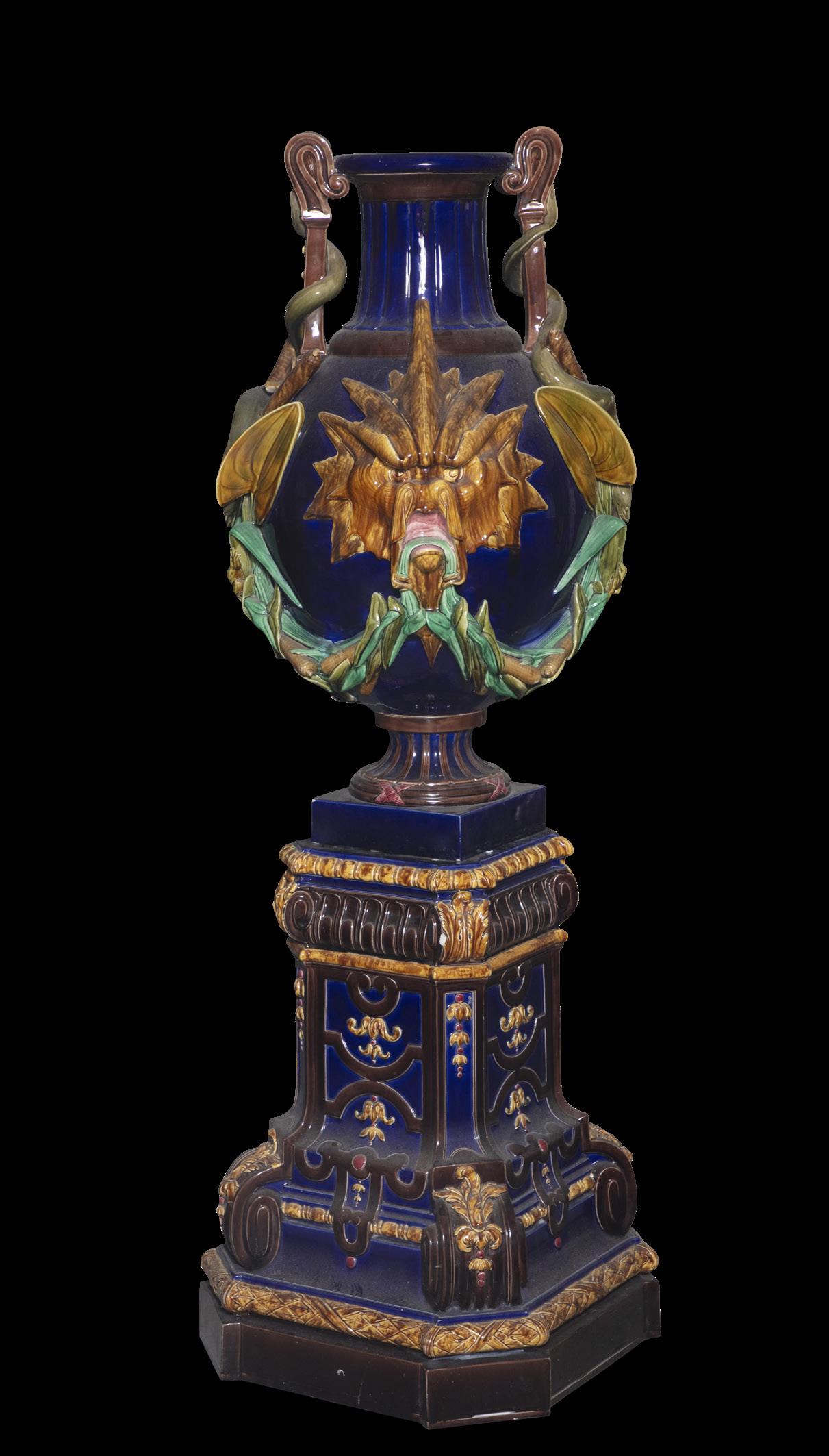
110
ENGLISH SCHOOL, 18TH CENTURY
Portrait of a Lady in a pink dress
Oil on canvas, 77 x 64cm, feigned oval
Signed and dated indistinctly
€ 800 - 1,200
111
A FRENCH KINGWOOD AND MARQUETRY AND ORMOLOU
MOUNTED WRITING DESK, 19TH CENTURY,
the shaped rectangular top with brass edge and fitted with felt scriber over single deep frieze drawer on square cabriole legs with cast leafy mounts and scroll feet, 77cm high, 98cm wide, 54cm deep
€ 1,500 - 2,000
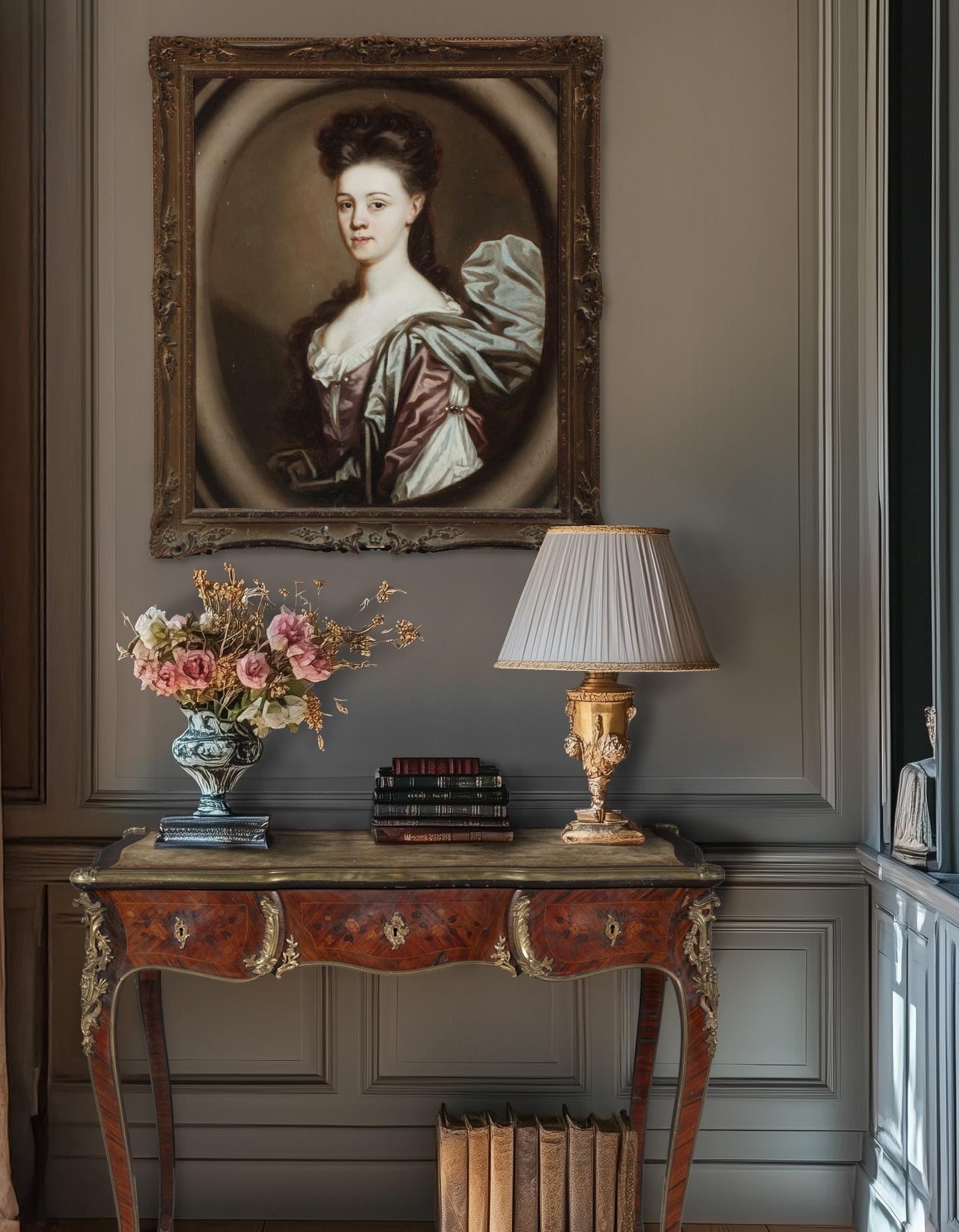

A NEEDLEWORK TAPESTRY OF THE HUNTS OF MAXIMILIAN LIBRA: SEPTEMBER - THE STAG HUNT CAUGHT IN THE RIVER
219 x 264cm
€ 800 - 1,200
This tapestry is based on the September example from the series of twelve tapestries which depict the hunting scenes in the Sonian Forest, Brussels, by the court of Maximillian I. In this example it depicts the moment in the hunt, ‘bat-l’eau’ as it is referred to in French, when the animal tracked by a pack of hunting dogs throws itself into a body of water. The tapestries were completed in the 1530s and designed by Bernard Van Orley and woven by Willem Dermoyen. The set is now in the collection of the Louvre, Paris.

AN EARLY VICTORIAN ROSEWOOD CIRCULAR CENTRE TABLE, the figured top with gadrooned edge and frieze carved with oak leaves and rosettes, on a boldly carved centre column with lotus and acanthus leaves on a concave platform base and compressed bun feet, 120cm diameter and approximately 70cm high
€ 1,500 - 2,000
114
SIR WILLIAM REID DICK (1878-1961)
Figure of ‘The Catapult’ or ‘Slingshot Boy’ Bronze with a dark brown patina, 33cm high overall
Signed ‘W.REID DICK’ (on the base)
Provenance : Sale, Adam’s, 19 October 2021, lot 744
€ 1,000 - 1,500

115
EBINGHAUS (GERMAN SCHOOL)
Hercules with Club Bronze, 66cm high
Signed Ebinghaus; also with foundry mark Guss C. Leyrer, Munich
€ 1,000 - 1,500
116
A WHITE MARBLE STATUE OF SPINARIO, 19TH CENTURY, sitting on a rock, removing a thorn from his foot, on a raised circular plinth base 66cm high, 35cms diameter
€ 1,000 - 1,500



118
A REGENCY ROSEWOOD AND BRASS MOUNTED TEA CADDY
of rectangular form with hinged lid, enclosing twin lidded compartments and a cut glass bowl, the sided applied with lion mask and ring handles, rope twist rim and com pressed bun feet. 17cm high, 32cm wide, 16cm deep
€ 100 - 200
119
A GEORGE IV EBONISED AND PARCEL GILT WINDOW SEAT, fitted with loose cushion seat the raised sides painted with en grisaille classical panels on ring turned tapering legs. 77cm high, 120cm wide, 46cm deep
€ 600 - 800
117
A FRENCH ORNITHOLOGICAL TEA SERVICE AND TRAY IN THE MANNER OF SEVRES, comprising a teapot, sugar bowl and cover, milk jug, cup, two saucers and tray each decorated with finely hand painted birds contained in vignettes against a celeste blue ground, the tray with pseudo Sevres marks. The tray 39cm wide across handles
€ 800 - 1,200



120
A LOUIS XV ORMOLU AND PORCELAIN MANTEL CLOCK THE MOVEMENT BY ANTOINE-ROBERT BUNON, MID-18TH CENTURY
the white enamelled dial with Roman and Arabic numerals and movement signed ‘BUNON A PARIS’, framed by flowers and foliate rockwork, on shaped supports decorated with flowers, on a pierced base decorated with windmill with figures of a shepherd and shepherdess playing music, originally with further ormolu elements. 52cm high, 46cm wide, 26cm deep
Provenance: Almost certainly, sale, Christie’s, Paris, 17 November 2011, lot 194
€ 5,000 - 8,000

121
AN IRISH CARVED OAK FRIEZE MASK, 18th/19th century, finely carved as a male lion head, 16cm high, 14cm wide
€ 100 - 200

122
A 19TH CENTURY ROYAL ARTILLERY REGIMENT SABRETACHE AND POUCH, embroidered with gold and silver bullion wire, the sabretache 34cm x 26.5cm wide; The pouch 10 x 16.5cm
€ 400 - 600
123
A WILLIAM IV CARVED MAHOGANY ARMCHAIR,
the rectangular back and seat covered in gros point tapestry fabric, bearing a crest and motto with lotus carved down-scrolling arms and turned fore-legs and castors
€ 1,200 - 1,600


AN ITALIAN CARRARA MARBLE PORTRAIT BUST OF JULIUS CAESAR, 19TH CENTURY
his shoulders with drapery fastened by a rosette, on later socle and plinth base and supported on a grey and pink marble cylindrical column. Bust and socle 85cm high; 185cm high overall
€ 3,000 - 5,000
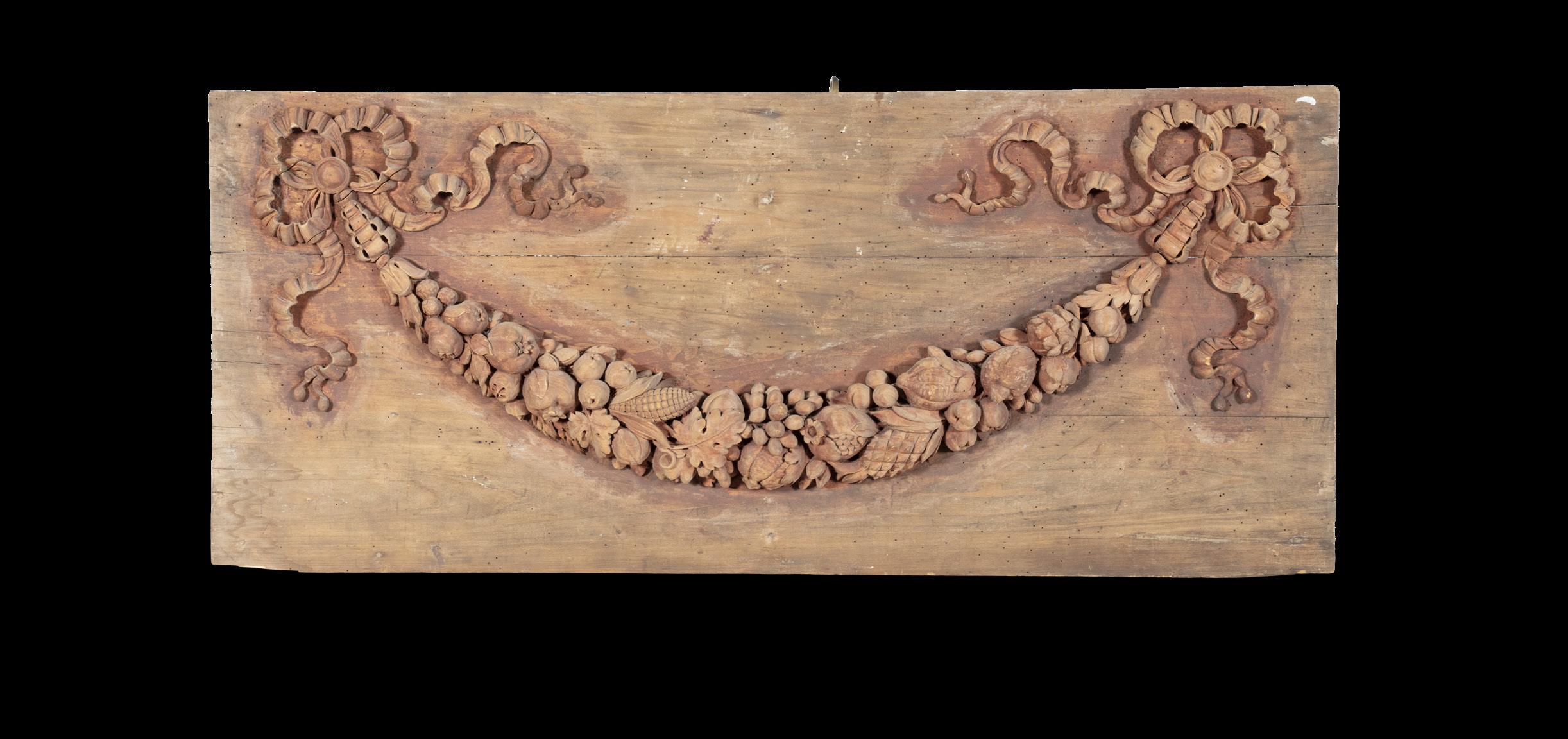
board, the panel measuring 144cm long, 62cm wide
€ 800 - 1,200
126
A GEORGE III EBONISED BRACKET CLOCK, BY WEBSTER & HUNTER, LONDON, MID-18TH CENTURY
the white enamel dial with Roman numerals inscribed ‘Webster & Hunter, Cornhill London’, with brass carrying handle on bracket feet, 45cm high, including handle, 31cm wide, 19cm deep
€ 1,000 - 1,500


127
A PAIR OF GEORGE IV MAHOGANY AND BRASS MOUNTED HALL CHAIRS, CIRCA 1825, each with rope-twist handle above a quatrefoil panel centred with a crested roundel, solid panel seat and sabre legs
€ 600 - 1,000
128
A PAIR OF NORTH ITALIAN STAINED WOOD FIGURES OF KNIGHTS IN ARMOUR, SECOND HALF 19TH CENTURY AFTER BARON MAROCHETTI
each carved on rectangular plinth bases, 29cm high
Provenance: Works of Art from the Collection of S.A.R. La Principessa Reale Maria Gabriella di Savoia, sale, Christie’s, London, 27

129

A 19TH CENTURY COPPER WEATHER VANE, modelled as a feathered arrow with spherical finial displayed on metal plinth stand. 53cm high, 161cm high including stand, 80cm wide
€ 800 - 1,200
130
A WILLIAM IV MAHOGANY FOUR DOOR COMPACT BOOKCASE, with fitted breakfront green marble top, with angled corners above a frieze with interlaced rosettes, four glazed panel doors, shelved interior and conforming plinth base, 107cm high, 159.5cm wide, 40cm deep
€ 2,000 - 3,000

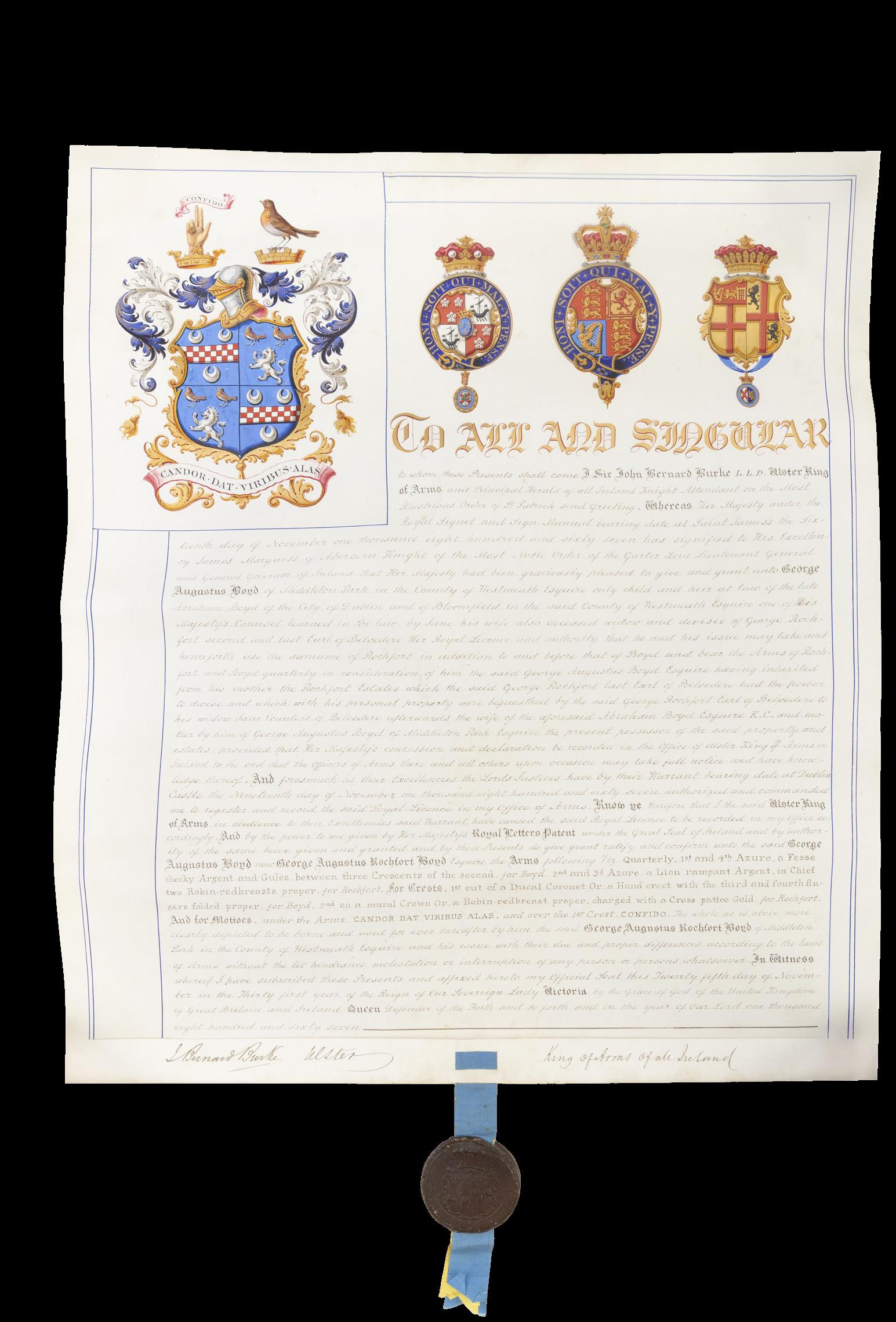

TWO 19TH CENTURY HANDWRITTEN LETTERS PATENT GRANTING USE OF ARMS AND TITLE OF BOYD, MCOY AND ROCHFORT BY THE ULSTER KING OF ARMS
including:
1. Sir William Betham granting to George Augustus Boyd, Bloomfield, Co. Westmeath the use of the arms of Boyd and McCoy of Scotland. Dated 24th April 1837, signed with gilt metal seal pendant, with fitted black leather case. 41.5 x 48.5cm; the case 51.5 x 10.5cm
2. Sir John Bernard Burke L.L.D granting to George Augustus Boyd Esq. of Middleton Park, Co. Westmeath, and his issue to use the surname of Rochfort and to use the coat of arms of Rochfort. Dating to 16th November 1867, signed, with black seal pendant, with fitted black leather case. Paper 5.5 x 48cm; the case 53 x 8cm
€ 500 - 800
George Augustus Rochfort-Boyd (18171887) was the eldest son and heir of Abraham Boyd. Abraham had married Jane MacKay, the widow of George Rochfort, 2nd Earl of Belvedere (1738 - 1814). The Earl had died without issue and so his estate was left to Jane which then passed on to her and Abraham’s children. He married Sarah Jane Woods in 1843 and together they had seven children. He held the office of Deputy Lieutenant of County Westmeath.
Sir William Betham (1779 - 1853) was a British antiquarian who was knighted by King George III in 1812. He was a member of RIA and the American Antiquarian Society. He was the Ulster King of Arms from 18201853.
Sir Bernard Burke (1814 - 1892) was a British genealogist who helped to publish Burke’s Peerage. He was the Ulster King of Arms from 1853 - 1892.



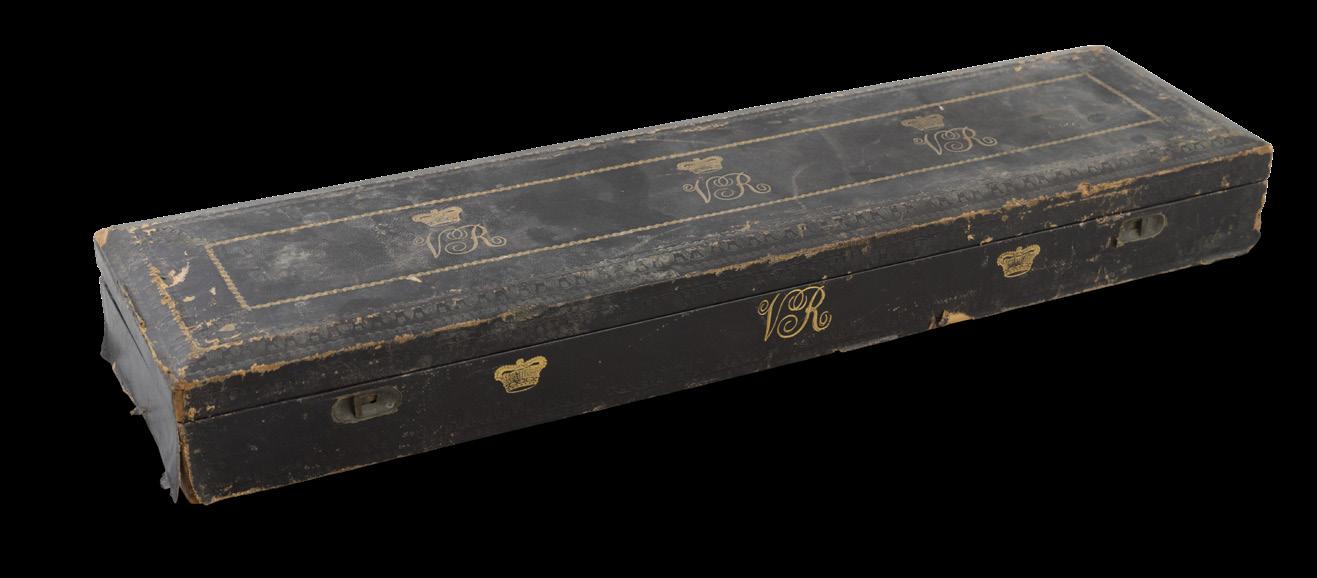
132
Sir Albert William Woods to create the honorable John Wilson Fitzpatrick of Grantstown Manor and Lisduff, a peer of the United Kingdom & Ireland titled Baron Castletown of Upper Ossory, Queen’s County. Dated 22nd December 1869, signed, with gilt metal seal pendant, with fitted black leather case (damaged). 63.5 x 52.5cm; the case 56.5 x 6cm
Sir Albert William Woods (1816 - 1904) was an English Officer of Arms. He served as Garter Principal from 1869 - 1904. Woods was responsible for the compilation of the important unpublished ordinary of arms (a systematic register of coats of arms) known as “Garter’s Ordinaries”. He began work on it in 1842 and continued until his death in 1904.
John Fitzpatrick (1809 - 1883) was an Anglo-Irish Liberal politician. He was the illegitimate son of John Fitzpatrick, 2nd Earl of Upper Ossory and Elizabeth Wilson.
Wilson, who in 1842 assumed the surname of FitzPatrick by Royal Licence, was appointed High Sheriff of Queen’s County in 1836. He was then elected to the House of Commons for Queen’s County in 1837, a seat he represented until 1841, and again from 1847 to 1852 and from 1865 to 1869. He was admitted to the Irish Privy Council in 1848.
In 1869, he was raised to the peerage as Baron Castletown, of Upper Ossory, reviving an ancient title that had belonged to the Fitzpatrick’s around 1500. Apart from his parliamentary career he was also Lord Lieutenant of Queen’s County from 1855 to 1883.
He was succeeded by his only son Bernard who died without heirs in 1937 and the barony became extinct.
€ 800 - 1,200

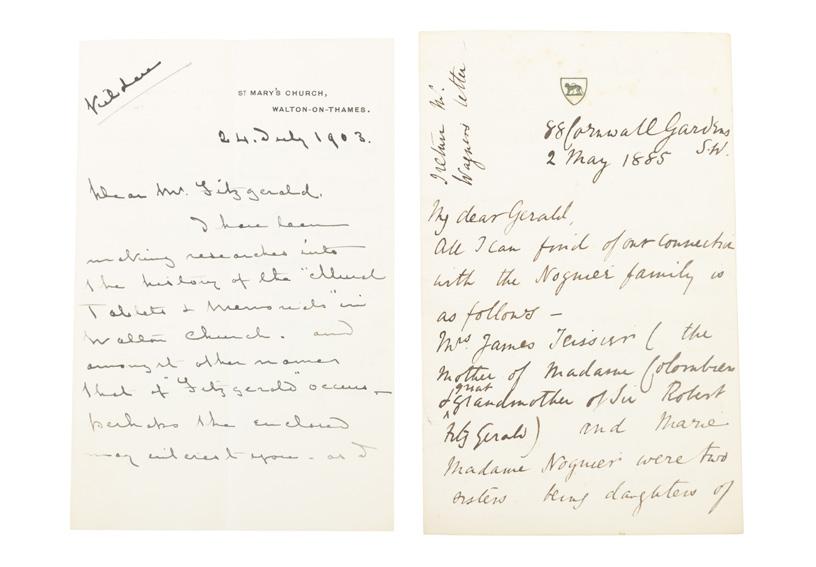
134
COUNTY FROM 1546 to 1882
Paper laid down on canvas, 60.5cm x 141cm
With handwritten annotations and the Leinster (FitzGerald) Coat of Arms
Together with; A handwritten letter dated 1885 on crested paper (Leinster [FitzGerald] Coat of Arms) addressed to ‘Gerald’ of 88 Cornwall Gardens S.W London. Together with; A handwritten letter dated 1903 on headed paper (St Mary’s Church, Walton-On-Thames) addressed to ‘Mr. FitzGerald’

135
€ 200 - 300

A VICTORIAN CAST IRON ARMY QUARTERMASTER STRONG BOX, with hinged top and carrying handles. 44.5cm wide, 32cm deep, 21cm high
€ 400 - 600
SIR WALTER RALEIGH (1554 - 1618)
Indenture document, 1st February 1589 (dated 1588 to page)
One page on vellum, c.43 x 70cm (irregular)
Signed by Robert Reve to bottom left
Mounted and framed (70 x 98cm)
Lacking seals
€ 10,000 - 15,000
Indenture, issued 1 February 1589, in the 31st year of Queen Elizabeth I’s reign, as she confirms an agreement between Sir Walter Raleigh, one of the principal agents of repopulating unclaimed lands in Counties Cork and Waterford, and Robert Reve and his wife Alice, of Bury St Edmunds, Suffolk, granting Robert and Alice 400 acres of ploughland and associated rights at Corrofin, Cluaine and Poulnalour in the Barrony of Inchiquin (Co. Clare). William and Alice will appear in the manor court twice a year, and pay a monetary rent, which will be modified in 1593 and on the death of Katherine, Dowager Countess of Desmond, plus a render of two capons or hens at Easter and the feast of St Michael (29 September). William and Alice shall also erect a manor house on the lands. Walter appoints Andrew Colthurst, Robert Mawle, and Michael Butler his agents in the transaction.
We would like to thank Dr. Mark Faulkner, Trinity College Dublin, for his assistance in the cataloguing of this lot.
Following his knighthood in 1585, Raleigh received 40,000 acres in the Munster Plantation including the coastal town of Youghal, where he served as mayor from 1588 – 89, and where his manor Myrtle Grove still stands to this day. Queen Elizabeth had begun a year earlier to survey land in Ireland to be divided amongst her undertakers.
The Munster Plantation of the 1580s was instituted in part as punishment for the Desmond Rebellions, an insurrection lead by Geraldine Earl of Desmond against English interference in Munster. In 1584, the Surveyor General of Ireland, Sir Valentine Browne and a commission surveyed Munster, to allocate confiscated lands to English Undertakers, wealthy colonists who “undertook” to import tenants from England to work their new land. The English Undertakers were obligated to develop new towns, employ English farming methods and provide for the defence of planted districts from attack.
Within the first three years of his grant, Raleigh installed at least 148 tenants. In this present indenture between Raleigh and Robert Reve, he is granting him and his wife Ann, land in the barony of Inchiquin, Co. Clare. Their rent will be revised after a period of four years and upon the death of Lady Katherine Fitzgerald, Countess of Desmond.
She is referred to in the present document as ‘oulde countess dowager’ a nickname popularised by Sir Walter Raleigh due to her longevity, with a recent biography putting her at 90 years old when she died. The Countess’ husband, 11th Earl of Desmond, had granted her a life tenancy in Inchiquin Castle. Upon the Countess Desmond’s death, the castle was to revert to the line of the Earls of Desmond. In 1575, she passed title to the castle and lands in trust, to the incumbent earl, Gerald FitzGerald. When the lands were leased to Raleigh following the Desmond Rebellions, he continued to preserve this position of the Countess and allow her to remain in the castle until her death.
Raleigh, an entrepreneurial character, used the land to also harvest forests but his estates proved to be ultimately unprofitable, and he sold the lands in 1602 to Richard Boyle, 1st Earl of Cork for £1,500.
Settlement by the English in Ireland was not novel in the sixteenth century. Since the 11th century Englishmen and their descendants had lived in Ireland. However, by the 16th century there was re-evaluation of English ruling policy in Ireland. Considerable threats existed since the time of Henry VIII to traditional English power, in particular lack of control by England over large parts of the country; raids from Gaelic lords into the Pale and an increasingly Gaelicised Anglo-Irish population. The English monarchy and its agents in Ireland proposed plans for an organised settlement of Ireland, which would see it become a central component of England, and later, in Britain’s burgeoning modern empire.

137
AFTER SIR PETER LELY
Portrait of King Charles II Oil on canvas, 200 x 135cm
The original is in Guildhall, Winchester
€ 3,000 - 5,000
138
A VICTORIAN MAHOGANY SIDE TABLE CIRCA 1880,
the moulded rectangular top above a carved apron centred with a mask flanked by scrollwork decoration, on acanthus carved cabriole legs and scroll pad feet. 121cm wide, 64cm deep, 78cm high
€ 3,000 - 5,000
139
A GEORGE IV STYLE MAHOGANY WINE COOLER
the canted corners and panelled sides on scrolled legs and claw feet with castors, 51cm high, 71cm wide, 53cm deep
€ 400 - 600


Dublin c.1760, each of circular with undulating gadrooned rims, the sides pierced with fruiting grapevines popu lated by infant Bacchanals, with further Irish towers and windmills, the scroll cartouche engraved with a crest, each on turned wood base, marked near rim with maker’s mark only (13 cm.) diameter (2)
Provenance: The Barratt Collection
€ 2,000 - 4,000
140
London c.1718, maker’s mark of Thomas Mann, the domed lid with scrolled thumb-piece on plain tapering body with a ribbed banding, scroll handle, contemporary coat of arms, on skirt base, the undertier engraved H over I and with a rose, marked inside lid, body and handle, (31.5 troy ozs). 19cm high, the base 14cm diameter
€ 3,000 - 5,000

Edinburgh 1802, mark of Francis Howden, the paterae fluted base with embossed foliate banding, with pierced ‘berainesque’ flanked handles and raised on conforming feet, (18 troy ozs all in). Each 26.5cm wide, 8cm high



Dublin c.1770, of pear shaped form, the hinged lid with pineapple final, the body chased and embossed rococo decoration with shields to each side containing a crest, above chinoiserie figures and motifs, with applied timber c-scroll handle, raised on a spreading circular foot (c.31.5 troy ozs including handle). 26cm high.

€ 4,000 - 5,000

144


London, c.1869, mark of George Fox, of circular form, with twin masked carrying handles, the openwork body applied with six silver Royal Dublin Society Medallions commemorating various prizes from agricultural shows including ‘Royal Dublin Society For the Best Short Haired Ox 3 year old, 1834’; ‘Royal Dublin Society Cattle Shew [sic] For the Best Kerry Fat Cow, 1845’; ‘Show of Farm Products For the Best Pen of Short Wooled Sheep of any age, 1858’ x2; ‘Winter Show of Fat Stock, 1859, Best Pen of Three Long Wooled Wedders of any age’; ‘Winter Show of Fat Stock, 1859, Best Pen of Six Short Wooled Sheep of any age’, with clear glass liner, (29.8 troy ozs excl. liner). 28.5cm wide across handles, 11cm high
€ 700 - 1,000
145
A PAIR OF GEORGE II SILVER DESK CANDLESTICKS,
London c.1745, lacking maker’s mark, with knopped and foliate cast stems, raised on square stepped cast bases (c.27 troy ozs in all). Each 18.5cm high
€ 4,000 - 5,000

Dublin c.1765, lacking maker’s mark but in the style of Robert Calderwood, each with fluted and knopped stems with scroll and shell decoration, with detachable drop pans and raised on spreading shaped circular bases (c.100 troy ozs in all). Each 24cm high
€ 12,000 - 15,000



147
JAMES LODER OF BATH (BRITISH, 1784-1860)
Horse in Stable, Bath
Signed J Loder Pinx, Bath and dated 1839
Oil on canvas, 76 x 63.5cm
€ 2,000 - 3,000
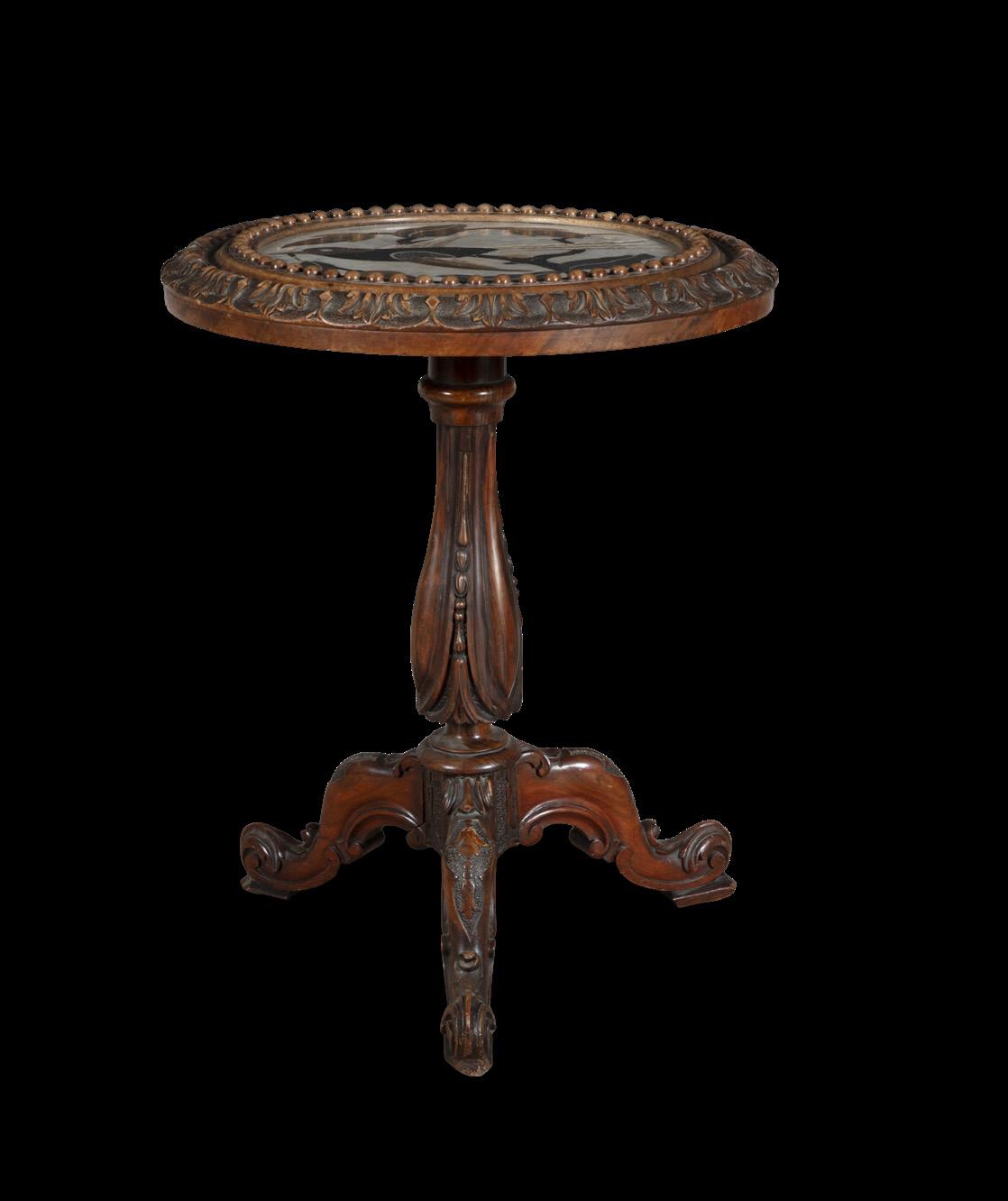

148
J.W MORRIS (1865 - 1924)
Ram, Ewes and lambs by a lakeside with mountains in the distance
Oil on canvas, 60 x 50cm
Signed ‘J. W Morris, lower right
€ 1,000 - 1,500

149
A VICTORIAN WALNUT AND PIETRA DURA CIRCULAR OCCASIONAL TABLE, CIRCA 1870, the centre inset with a song bird perched on fruiting branches in various coloured stones enclosed by a beaded and leaf carved border on carved centre pillar on arched triform base, 71cm high, 59cm diameter
€ 800 - 1,200


The Grand Duke’s Madonna, Oil on canvas, 84 x 57cm
With original gallery label verso ‘Leopoldo Dumini E Figlio’
*A copy of Raffaello Sanzio’s painting housed in the Collection of Palazzo Pitti in Florence
€ 2,000 - 3,000

152
Fez, Morocco
Oil on artist board, 25 x 34cm
Signed, inscribed and dated (19)’24
€ 700 - 1,000

151 MANNER OF DAVID TENIERS
Tavern Interior Oil on panel, 19.5 x 26cm
€ 400 - 600

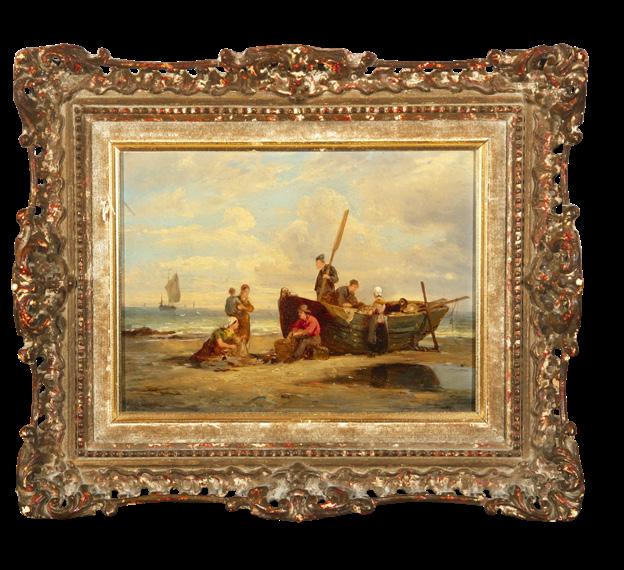
Mending the nets on the shore
A pair, oil on board, each 15 x 19cm
Signed and dated indistinctly (lower left)
Provenance: Sale, Sheppards, 25 April 2017, lot 2017
€ 800 - 1,000

154 STYLE OF CORNELIA SCHOUTEN HEAVY
Still life with flowers Oil on panel, 39 x 27cm
€ 500 - 800
156
AN IRISH 19TH CENTURY MAHOGANY DOUBLECHAIR BACK SETTEE, the openwork back, with twin intertwined splat, upholstered drop-in seat and leaf carved cabriole legs, 121cm wide
€ 800 - 1,200

155 FOLLOWER OF JOHN ASTLEY
Portrait of a Lady in blue silk dress, lace bonnet and chemise,
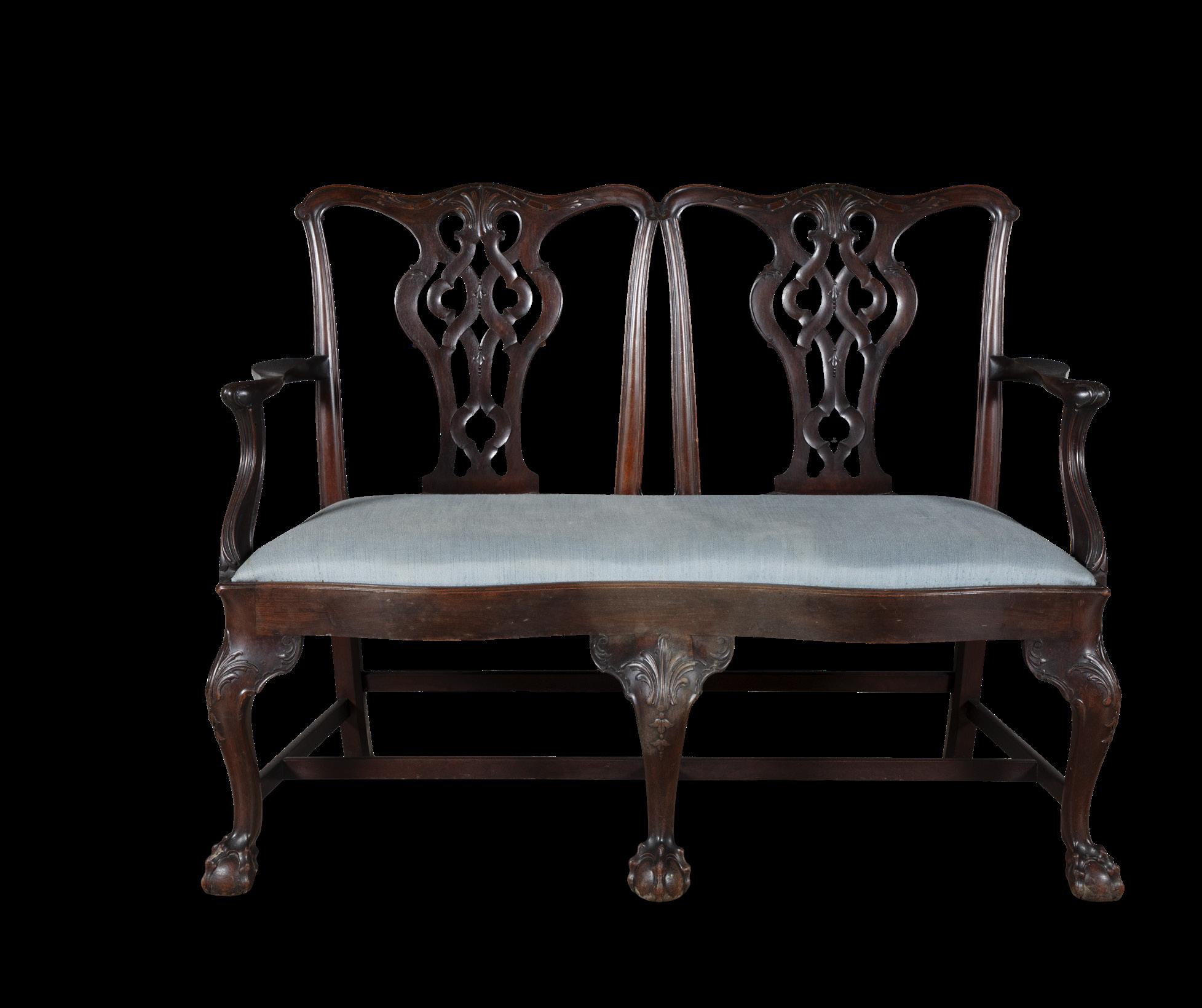
the raised back with arched cresting above a row of carved demilune panels of carved armorials and still life’s with lift top panel seat, down swept arms and a storage compartment base. 144cm high, 120cm wide, 60cm deep € 500 - 700


of rectangular shape, with leaf carved cornice, above the cupboard section with three recessed panels, each carved with battle scenes over two short drawers fitted with brass drop handles and deep cupboard section. 181cm high, 151cm wide,

€ 4,500 - 5,500


160
AN ORDNANCE SURVEY MAP OF KNOCKLOFTY ESTATE, CO. TIPPERARY, 1908
linen backed fold-out map, there is one fold-out in 37 sections, with hand written annotations for areas of land that have been sold ‘To Captain Robinson’ & ‘To E. C Power’, published by Ordnance Survey Office, Phoenix Park, Dublin, bound in half red leather with cloth boards, spine with gilt lettering and dated 1911. The map 235 x 182cm (irregular)
€ 200 - 300
161
A VICTORIAN MAHOGANY FRAMED UPHOLSTERED DAYBED,
with twin scrolled ends covered in a soft blue fabric with brass studding on turned baluster les and castors, 61cm high, 216cm long, 85cm deep
€ 1,500 - 2,000

162
A TONIC DICTIONARY OF THE CHINESE LANGUAGE IN THE CANTON DIALECT BY SAMUEL WELLS WILLIAMS (1812-1884)
First Edition, Printed at the office of the Chinese Repository 1856 (Rebound)
Samuel Wells Williams was an America missionary, scholar, diplomat and Sinologist. Williams carried out a number of missionary and teaching projects in China throughout his twenties and was fluent in Chinese. In 1833 Williams travelled to China with the American Board of Commissioners for Foreign Missions to work with the Canton mission press. During his time in China, Williams wrote the ‘An English and Chinese Vocabulary in Court Dialect’ published in 1844. In 1855, Williams was appointed Secretary of the United States Legation to China, and during this time he wrote ‘A Tonic Dictionary Of The Chinese Language In The Canton Dialect’ (英華 分韻撮要) which was published in 1856.
Upon his return to the United States in 1877, Wells was appointed as the first Professor of Chinese language and literature in the United States at Yale


each with solid panel seat and raised backs with opposing C-scrolls and roundels on fluted tapering legs
€ 500 - 800

163
A GEORGIAN MAHOGANY FOLD TOP TEA TABLE, the moulded rectangular top with plain interior and extending to gate leg action supports on leaf capped cabriole legs and pad feet, 73cm high, 92cm wide, 45cm deep
€ 800 - 1,000


165
ITALIAN SCHOOL, 19TH CENTURY, The Penitent Magdalen Oil on panel, 52 x 44cm
Provenance: Almost certainly, Christie’s, 4 July, 1991, lot 612
€ 1,500 - 2,000
166
A 19TH CENTURY HARP, unstrung, decorated with carved gilt floral and leaf sprays, 165cm high
€ 300 - 500

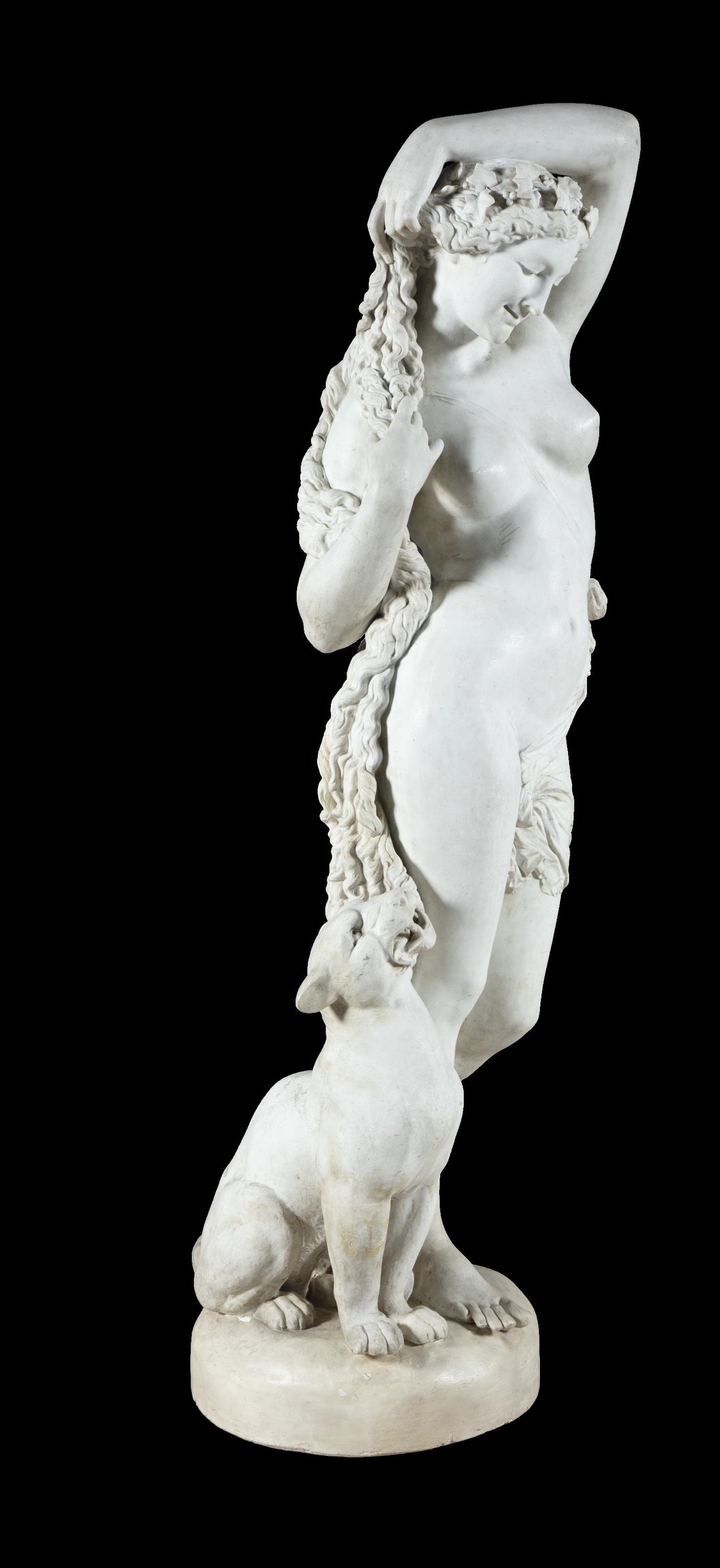
A LIFE-SIZE CERAMIC MODEL OF ARIADNE / A MAENAD,
standing with a panther by her left side, with long flowing hair crowned by an ivy band, wearing loose drapery, standing on round base, 160cm high
€ 3,000 - 5,000
In Greek mytholody Maenads were the fmale followers of Dionysus. They were the most signifcant members of the Thiasus, an estatic gathering of his worshippers.
In artworks they are often protrayed in a state of excited frenzy, dancing or drinking wine. In in this present example the figure looks down smiling at the panther seated at her feet. An ivy wreath, a symbol associated with maenads, is wrapped around her head, falling gracefully over her shoulder and legs. Dionsyus also often carries a sceptre wound with trailing ivy. The panther is closely related to Dionysus reprensenting his free and untamed nature and he is often depicted carrying the animal skin.
Depictions of maenads are often seen on red and black Greek pottery vessels or as a large scale marble, bronze and porcelain figural sculptures.

The Irish Rebellion: or, an History of the beginnings and first progress of the General Rebellion, raised within the Kingdom of Ireland, upon the three and twentieth day of October, 1641. Dublin, Aaron Rhames, 1724. Full calf
€ 300 - 500

Memoirs of the different Rebellions in Ireland. From the Arrival of the English. Dublin, John Milliken, 1801. 2nd edition. Full calf, 4to. With fold out maps.
€ 200 - 300
the rectangular top with leather writing panel and lift-up compartment and fit ted candle well, with slide extensions on cupboard section with arched fielded panel doors. 61cm high, 115cm wide, 55cm deep

The History of Ireland From the Earliest Period of the Irish Annals to the Present Time. Vol I - III. London, London Printing and Publishing Company, n.d. With steel engravings from original drawings by H Warren Esq. Half calf
€ 200 - 300


Portrait of Rear-Admiral Sir Robert Lewis Fitzgerald in his Library Oil on canvas, 75 x 59cm
Robert Lewis Fitzgerald (1776-1844) married Jane Welch at Melcombe Regis in August 1800. Fitzgerald was awarded a share in the compensation of the Hyde estate in St Thomas-in-theVale Jamaica in right of his wife Jane Fitzgerald (q.v.), one of the daughters of Richard Welch, the former Chief Justice of Jamaica. Fitzgerald was Knighted in 1835 and died in January 1844 at Bath aged 68, Vice Admiral of the Red. ‘This officer is descended from a younger branch of the very ancient and noble house of Leinster, in the kingdom of Ireland, and nearly related to the Earl of Kingston.’ Edinburgh Gazette 4439 04/12/1835 p. 1. Five sons and four daughters survived of eleven children, including Maria Phillipa (1813-1845), Georgina Favell (1817-1841), Charlotte Mary (18191823), James Lewis (1806-1835) and George Milner (1816-1843).
€ 800 - 1,200
174
A VICTORIAN ROSEWOOD LIBRARY TABLE MID 19TH CENTURY, with shaped rectangular top and twin frieze drawers, deco rated with scrollwork moulding, on turned trestle-end supports joined by stretcher, 74cm high, 135cm long, 68cm wide
€ 600 - 1,000


175
AN IRISH GEORGE III CARVED GILTWOOD WALL MIRROR, fitted with plain glass plate surmounted with a depiction of a castle within a scroll cartouche flanked by opposing ho-ho birds to sides with S-scrolls and carved foliate trails repeated to the apron. 125cm high, 66cm wide
€ 10,000 - 15,000
See ‘Irish Funriture’, The Knight of Glin and James Peill, illus. fig. 243, page 266, mirror by Francis and John Booker.

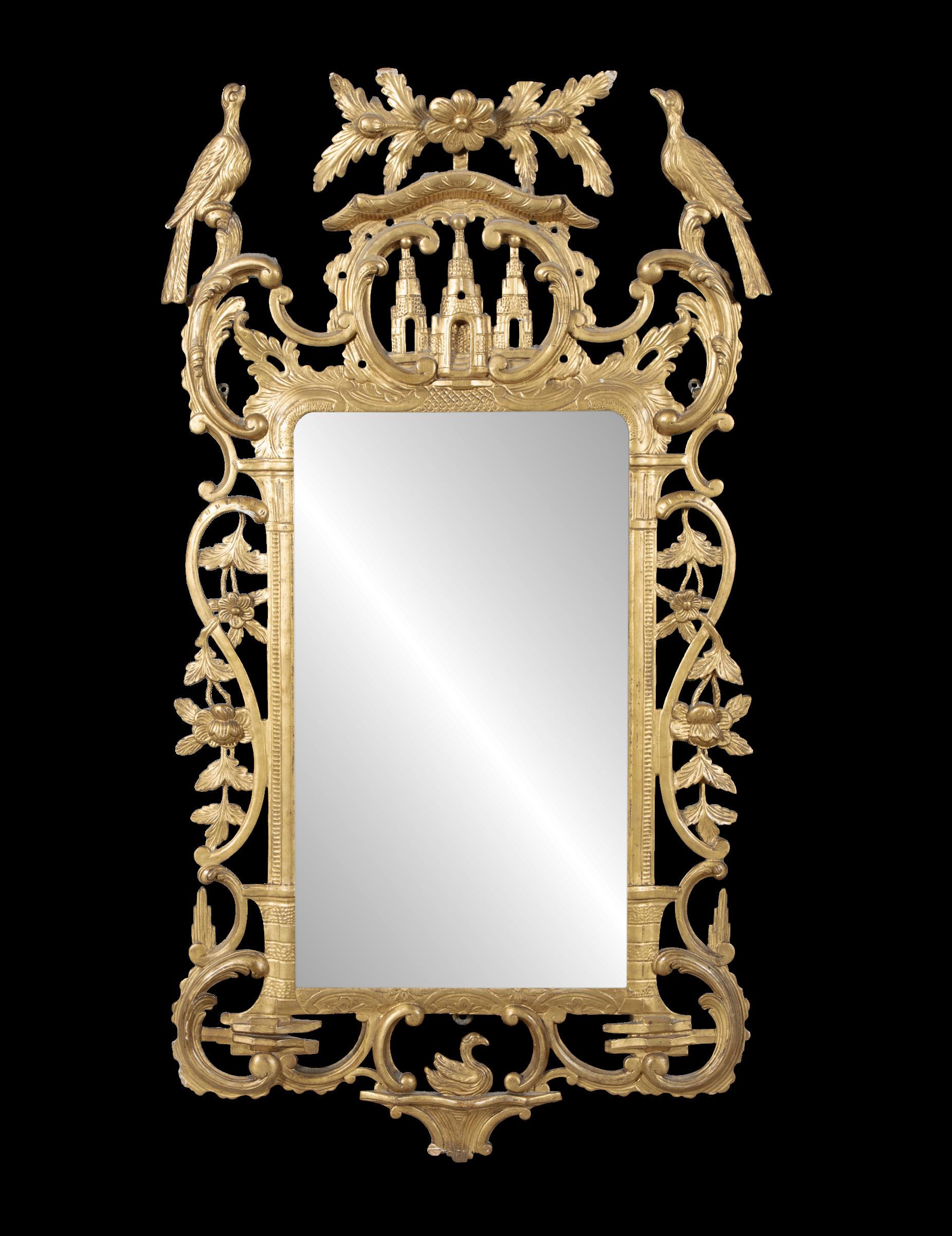

176
A PAIR OF VICTORIAN MAHOGANY TUBBACK CLUB ARMCHAIRS, LATE 19TH CENTURY, each with button back and squab cushion covered in dark green leather on tapering square legs, 90cm high, 86cm wide, 98cm deep (2)
€ 1,000 - 1,500
177
JOSEPH W. YARNOLD (c. 1817-1852)
Off the Coast; and Ships in Rough Sea Oil canvas, 30 x 50cm; 40 x 60cm (2)
Provenance: With N.R. Omell Gallery, London, where acquired
€ 1,000 - 1,500


Shipping Off the Coast Oil on canvas, 30 x 39cms
Signed ‘ F Calvert’ (lower right)
Provenance: With N.R. Omell Gallery, London, where acquired May 2011
€ 800 - 1,200
179
AN IRISH CARVED MAHOGANY SIDETABLE 19TH CENTURY
solid rectangular top, moulded edge above a wavy apron centred by scallop shell, the cabriole legs carved with acanthus and pendent bellflowers on claw and ball feet. 79.5cm high, 144cm wide, 70cm deep
€ 1,000 - 1,500

180
A MAHOGANY GUN CABINET, 19TH CENTURY
of rectangular upright form, with pediment, above single glazed door, opening to baise lined interior fitted with hooks and slots for gun barrels, above single base draw er. 166cm high, 60cm wide, 27cm deep
€ 500 - 800


A PAIR OF FLINTLOCK LIGHT DRAGOON SERVICE
PISTOLS DUBLIN CASTLE EARLY 19TH CENTURY
each with walnut three-quarter stock and brass fitments, engraved with ‘GR’ cypher and marked ‘DUBLIN CASTLE’, 40 cm long, 22 cm, barrel
€ 1,000 - 1,500

182 AN ITALIAN 17TH CENTURY DAGGER

with slender tapering double edged blade of flattened diamond section, etched with stylised scroll work and a central cartouche of a winged cherub, the hilt comprising of a turned hardwood grip of tapering form, a mounted domed metal flower shaped pommel surmounted with a finial, and a smaller

A COLLECTION OF CEREMONIAL SWORDS, 20TH CENTURY
including two Indian sabres, each 97.5cm long (overall) and a Turkish dagger, 36cm long (overall) (3)
€ 150 - 250

184
BRITISH 1907 PATTERN BAYONET (POSSIBLY BY CHAPMAN) AND SCABBARD
the ricasso marked with a crown over ‘1907’ and various inspector marks, with a single-edge blade and deep fuller, timber grip, black leather scabbard with steel chape and mounts, with webbing frog. 43cm blade
€ 100 - 150
186
A MAHOGANY SQUARE TOP LIBRARY TABLE, 19TH CENTURY
the solid panel top with rounded corners, above a plain frieze with bead and reel trim and fretwork corner bracket raised on stop-fluted legs with block feet. 74cm high, 145cm wide, 122cm deep
€ 1,000 - 1,500

185
A CONTINENTAL CAVALRY TROOPERS SABRE BLADE
the blade with one broad and one narrow fuller, etched with decoration including foliage, and a central figure in traditional armour, full tang. 64cm blade, 79cm overall together with;
A CONTINENTAL CAVALRY SWORD BLADE with a broad double-edged blade and central fuller etched with a foliate scroll and stylised trophy of arms including spears, swords and banners on both sides at the forte, full tang. 94.5cm blade, 103.5cm overall together with;
A RAPIER BLADE
with tapering double-edged blade of flattened diamond section, the forte with central short fuller on both sides, full tang. 97cm blade, 111cm overall
€ 200 - 300



187
A PAIR OF AUBUSSON ENTRE FENÊTRE TAPESTRIES 19TH CENTURY, each depicting a classical figure, exotic bird and arrangements of fruit and flowers 354cm x 51.5cm
€ 800 - 1,200
188
TWO FLEMISH NEEDLEPOINT TAPESTRY FRAGMENTS, 76cm x 31cm
€ 400 - 600
189
A GEORGE III MAHAGONY SLOPEFRONT ESTATE CABINET
surmounted with swan neck pediment and urn finials with parquetry inlay star above arched mirror panel doors and pull out candle slides, the interior fitted with an arrangement of small drawers, pigeon holes and stationary compartments over a fall front slope with book ridge, fitted interior over two short and three long drawers on bracket feet. 230cm high, 102cm wide, 58cm deep
€ 1,000 - 2,000
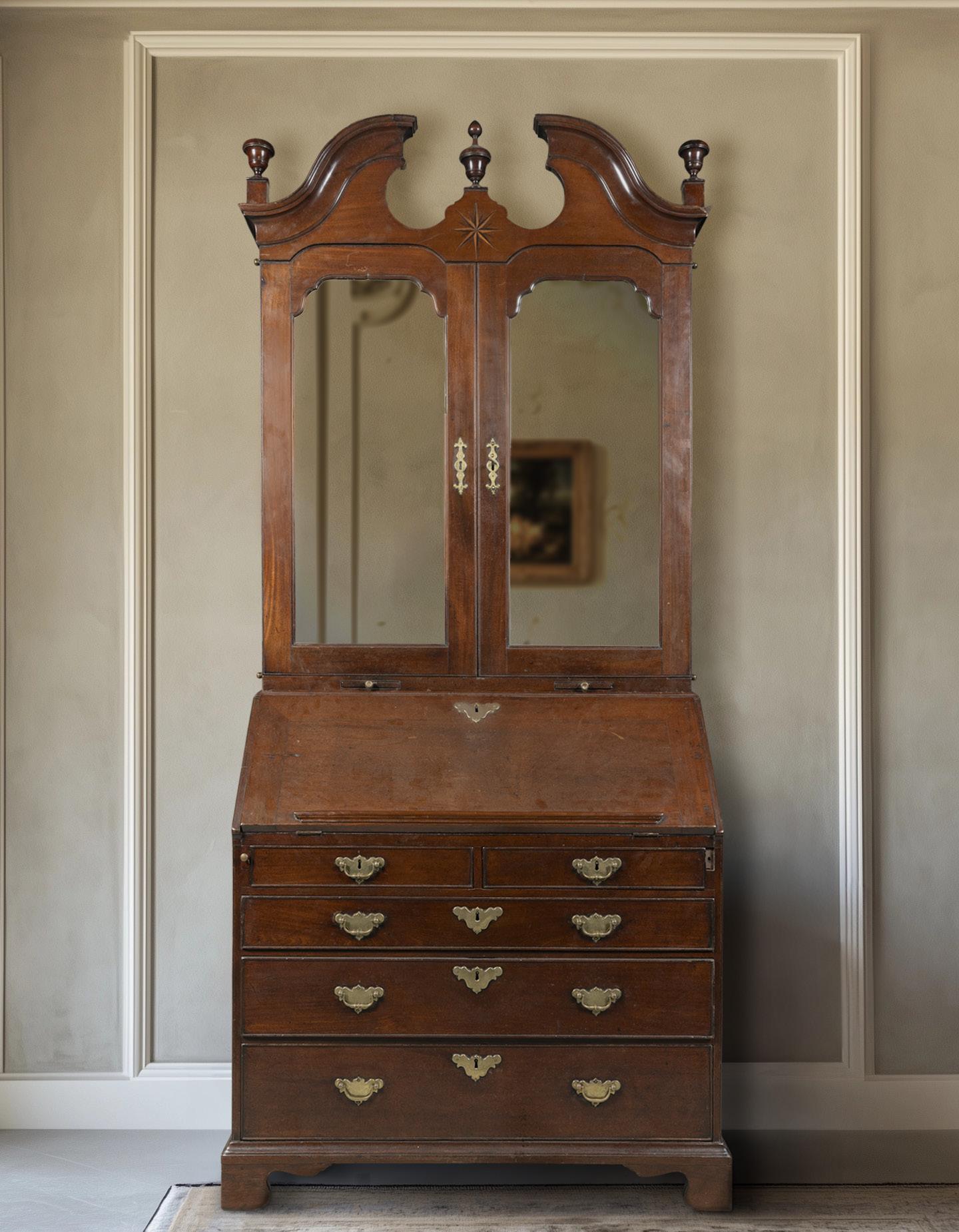

191
GEORGE CHAMBERS (1803-1840)
Paddle Steamers Heading into Harbour Oil on canvas, 46 x 61cm
Signed and dated ‘G. Chambers 1831’ (lower left)
Provenance : Sale; Adams 16th October 2018, Lot 583
€ 2,000 - 3,000

190
GEORGE STAINTON (1838-1900)
On the Medway Oil on canvas, 30 x 50cm
Signed ‘Geo STAINTON’ (lower right), and signed and inscribed with title verso
Provenance: With N.R. Omell Gallery, London, where acquired February 2011
€ 800 - 1,200

192 A WILLIAM IV MAHOGANY TUB BACK LIBRARY ARMCHAIR,
covered in a tanned brown hide with brass studding and out-turned armrests on carved tapering legs with brass castors
€ 800 - 1,200

193
A PAIR OF GREY MARBLE DESK OBELISKS each of upright square form, on shaped veined white marble plinth bases. Each 57cm high
€ 500 - 800
194 A BELLEEK FIRST PERIOD MODEL OF A CROUCHING VENUS (1863-1890), the classical female figure depicted leaning on one knee, turned slightly to the right, on naturalistic oval base, with gilded highlights. 46cm high



197
A GEORGE II SILVER SHAPED CIRCULAR CARD TRAY,
London c.1743, mark of Robert Abercromby, the piecrust rim interposed with shell motifs and the central reserve engraved with a crest, on hoof feet, (12 troy ozs). 21cm diameter
€ 400 - 600

196
A GEORGE II IRISH SILVER PLAIN BOWL,
Dublin c.1752, maker’s mark of Samuel Walker, the bowl of plain form, engraved with the crest of Nugent Earl of Westmeath, raised on circular foot (c.16 troy ozs). 17.7cm diameter, 9.5cm high
€ 3,000 - 5,000

198
A GEORGE II SILVER BEER JUG
London c.1754, markers mark partially rubbed ‘R..’ of baluster form, with applied c-scroll handle, on circular foot, crested (9.5 troy ozs). 12cm high
€ 400 - 600

199
AN IRISH GEORGE III OVAL SILVER PRESENTATION TRAY, Dublin 1805, mark of Richard Sawyer, the beaded rim enclosing an engraved reserve ‘Presented to the Rev. John Moody DD by his friend William Conyngham 1st Baron Plunket, Lord Chancellor of Ireland’, raised on scroll feet, (c. 110 troy ozs). 60 x 45cm
€ 5,000 - 8,000
William Conyngham Plunket was the fourth and youngest son of Thomas Plunket, a presbyterian minister, and his wife, Mary Plunket (née Conyngham). In 1768 the Plunket family moved to Dublin when Thomas Plunket was appointed the colleague of the Rev. Dr Moody in the ministry of the Strand Street Chapel. Thomas, who had a deep knowledge of politics, was active in the liberal cause and became an adviser to patriot members of parliament. A man of little personal fortune, he died in 1778 leaving his widow financially reliant on the support of the Strand Street congregation.
Given the charity and kindness Rev. John Moody had shown to the Plunket family, it is unsurprising that William Conyngham should present him with such a generous gift bearing the Moody coat of arms. Rev. Moody died in 1813 and William Conyngham was appointed Lord Chancellor in 1830, so we can deduce that the tray was likely presented to Moody in 1805 or shortly thereafter and the inscription was engraved posthumously.
200

London c.1747/1748, maker’s mark of Johh Hugh le Sage, each with removeable drip pans, the knopped stems with scroll and floral decoration, raised on shaped circular bases (c.67 troy ozs). 28cm high
€ 3,000 - 5,000





202
Birmingham c.1908, mark of Alfred Edward Jones, with lion finial, the plain hammered body with embossed banding and raised on four tab feet, (7.5 troy ozs). 15cm high, 8.5cm diameter
€ 400 - 600


Dublin (lacking date mark and maker’s mark), of helmet form, the body decorated in the rococo taste, and with embossed and chased decoration depicting a shepherd in a rural farmyard scene, raised on human mask capped legs and shell feet, with applied s-scroll handle (c.9.5 troy ozs). 17cm wide over handle and spout
€ 400 - 600

203
A PAIR OF ARTS AND CRAFTS SILVER AND ENAMEL DISHES
by Omar Ramsden, London 1938, each of shallow circular form with notched rim, enclosing a pierced floral boss filled with red enamelwork, the base inscribed ‘OMAR RAMSDEN ME FECIT’, (7 troy ozs). Each 11.5cm diameter (2)
€ 1,200 - 1,800
Omar Ramsden was born in Sheffield in 1873. He was the son of silver engraver Benjamin Woolhouse Ramsden and his wife, Norah. He apprenticed at a Sheffield firm of silversmiths, an experience that, combined with early exposure to his father’s craft, laid the foundation for his lifelong dedication to his art. Ramsden went on to study at the Sheffield School of Art, which at the time was considered one of the leading institutions for art and design. It was here that he met Alwyn C. E. Carr, who would become his close friend and business partner.
Following their graduation, Ramsden and Carr established St Dunstan’s Studio and workshop in Chelsea in 1898. The partnership of Ramsden & Carr flourished until the outbreak of the First World War, when Carr enlisted with the ‘Artists’ Rifles’, effectively bringing their collaboration to an end.
Ramsden’s work was deeply informed by the ideals of the Arts and Crafts movement, which looked to revive traditional craftsmanship and a return to simpler, hand-made forms in reaction to the mass-produced and often excessively ornate silverware of the Victorian era. Drawing inspiration from nature, as well as from Renaissance, Gothic, and Celtic styles, the studio developed a distinctive style that combined historical references with a modern simplicity.
This pair of dishes exemplifies this approach. The decoration at the centre is a stylised rose, clearly inspired by natural forms and closely resembling a Tudor rose, though not an exact rendering. The hammer marks on the surface have been intentionally left visible, drawing attention to the hand-worked nature of the silver and celebrating the uniqueness of each piece. Ramsden often signed his work with the Latin inscription “OMAR RAMSDEN ME FECIT” (“Omar Ramsden made me”), echoing the practice of Medieval and Renaissance artists and underscoring his commitment to individual craftsmanship.
205
A COLLECTION OF FOUR SILVER DECANTER LABELS,
‘LISBON’, ‘MADEIRA’, ‘BUCELLAS’, ‘TENERIFFE’, three stamped with maker’s mark John Teare and one with mark of John Townsend (c.1.9 troy ozs)
€ 200 - 300
bearing the mark of Hester Bateman, the hinged silver side with bands of bright-cut decoration. 8.3cm long
€ 600 - 800


Dublin 1770, maker’s marks rubbed, each of helmet form, with beaded rims, the bodies decorated with chased and embossed garlands of flowers against a fish scale ground, with applied acanthus wrapped c-scroll handle, raised on shell capped legs (c.33 troy ozs) 21cm wide over handle and spout
(Dent to underside of one exam -
€ 1,500 - 2,500
Dublin c.1780, maker’s mark of Richard Williams (other hallmarks not visible), each with pierced chased and embossed bodies decorated with Bacchanal of Putti amongst fruiting vines, birds, windmills etc., having turned timber bases. c.13cm diameter, 6cm high


209
GEORGE MOUNSEY WHEATLEY ATKINSON (1806 - 1884)
Crowded Harbour with paddlesteamers Oil on canvas, 65 x 100cm
Provenance: Sale, Christie’s, South Kensington,
210
A FRENCH CHARLES X MARBLE TOPPED COMMODE, of rectangular form, with slightly outset corner fitted with Carrara marble above three long drawers, with angular handles and oval escutcheon flanked by fluted pilasters and tapering legs and brass socks, 92cm high, 116cm wide, 54.4cm deep
211
ENGLISH SCHOOL C. 1830
Portrait of Esther Lowe Peacock Oil on canvas, 80.5 x 70cm
Esther Lowe Peacock married James Pickford Bloor on 16th May 1827 in Manchester.
€ 600 - 800


212
A PAINTED TIMBER THREE-MAST POND YACHT, 19TH / 20TH CENTURY, the varnished hall and deck with architectural hatch and compartments supported on a fitted stand, 131cm long € 400 - 600


A VICTORIAN TAXIDERMY GROUP, 19th century, formed as exotic birds perched on naturalistic branches, glazed and contained within a bamboo frame, splayed feet. 136cm high, 72cm wide
€ 600 - 800


SATINWOOD INLAID DOUBLE DROP LEAF WORK TABLE
shaped rectangular top, over a frieze of two short drawers, on ring turned legs and brass castors. 71cm high x 76cm wide x 51cm deep
€400 – 600
215 A GEORGE II MAHOGANY FRAMED SIDE CHAIR
with solid vase shaped splat and upholstered drop in seat covered in gros point needlework on cabriole legs and carved trifid feet. 102cm high, 62cm wide, 54cm deep, 48cm seat height
€ 200 - 400
Portrait of a Girl in a White Dress and Bonnet Oil on canvas, 63 x 53cm
€ 3,000 - 5,000
217
A GEORGE III WALNUT AND CROSSBANDED LOWBOY
the shaped rectangular top over a three drawer frieze, shaped apron, on downswept legs with pad feet. 70cm high x 76cm wide x 51cm deep
€ 800 - 1,200


218 *
A COLLECTION OF AFRICAN CURIOUSITIES comprising :
AN AFRICAN CRESCENT SHAPED COSMETIC BOX , 19th Century, KUBA PEOPLES (Democratic Republic of Congo), con taining traces of camwood powder, the exterior carved with arches, slices and interlacing strapwork. Marked with inventory/accession number 15cm wide
A STIPPLE DECORATED SIDE-BLOWN IVORY HORN
19/20th Century
Mende people, Sierra Leone, with metal coiled ring, sim ple stippled design, lacking end mount, inventory num ber 95
40cm long
AN EGYPTIAN ALABASTER URN with out-turned lipped rim and variegated body 16cm high
€ 400 - 600
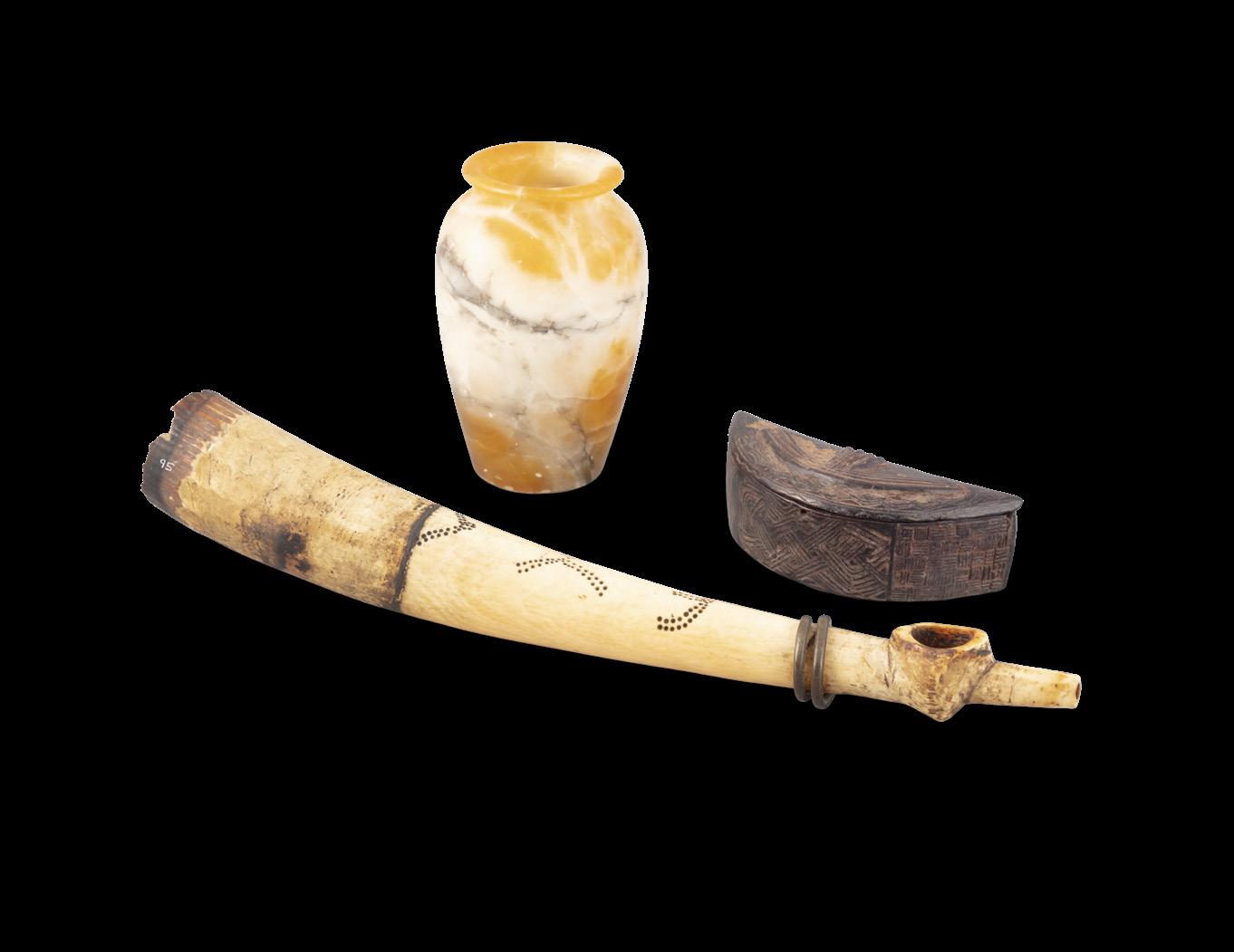

219 AN EMPIRE STYLE MARBLE TOP BRASS MOUNTED MAHOGANY CONSOLE TABLE, EARLY 19TH CENTURY,
the rectangular top above a frieze with gilt brass floral mounts, raised on square tapered legs topped with caryatide heads, raised on shaped platform base. 94.5cm high, 108.5cm wide, 50.5cm deep
€ 400 - 600

Amazon on Horseback
Bronze, 53.5cm high (including marble base), 33cm wide, 18.5cm deep
Signed ‘C. Hilgers’; also with an applied plaque to base
Provenance: The dedication on the plaque to the base translates from German as follows “To Mr. Hans Barnbrock In memory of the Schwabenland Dedicated by the representatives of HAPAG in Württemberg and Hohenzollern Stuttgart, 31 December 1929”.
€ 2,000 - 3,000
The dedication likely commemorates Hans Barnbrock’s contributions to HAPAG (Hamburg-Amerikanische Packetfahrt-Actien-Gesellschaft), also known as the Hamburg America Line, one of the preeminent German shipping companies of the era. Hans Barnbrock appears as a cabin passenger on the SS Pennsylvania’s manifest dated April 22, 1902. The SS Pennsylvania was a vessel operated by the Hamburg America Line in the early 20th century. The reference to Schwabenland in the dedication likely alludes to the vessel MS Schwabenland, a catapult ship operated by HAPAG, which later became significant for its role in the German Antarctic Expedition of 1938–39.
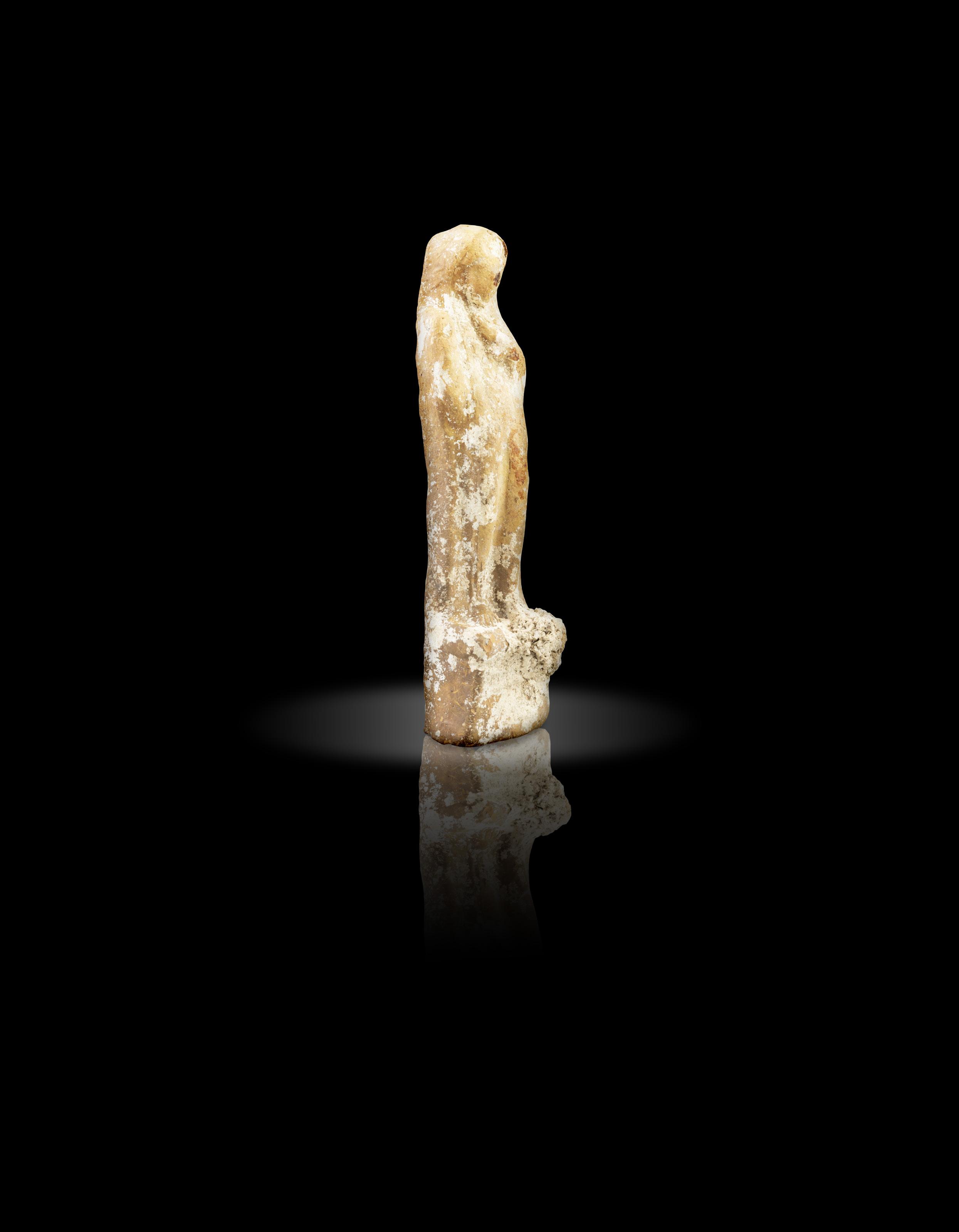
A CARTHAGINIAN TERRACOTTA FEMALE FIGURE OF THE GODDESS TANITH, the standing figure of upright form, with right hand raised to her chest on a hollow platform base. 34cm high x 9cm wide x 7cm deep.
Provenance : Private Collection, Ireland
Tanith also known as ‘Serpent Lady’ is the Phoenician Goddess of Carthage and mother goddess of fertility and the moon. She derives from a local Berber deity and the consort of Ba’al-Hammon. She was also the goddess of wisdom, civilisation and the crafts. Where worshipped, Tanith is the protector of homes and towns.
€ 1,000 - 1,500

AN EGYPTIAN PALE GREEN FAIENCE GLAZED
USHABTI LATE PERIOD
carved in standing position with folded arms, wigged and bearded inscribed with eight bands of hieroglyphs on square base with back pillar. 19cm high
€ 1,000 - 2,000

224
A VICTORIAN MAHOGANY FRAME TUB BACK LIBRARY CHAIR,
the top rail and seat upholstered in burgundy hide with gallery back, serpentine front on turned tapering legs.
€ 200 - 400

223
A GEORGE III STYLE GILTWOOD PIER MIRROR, the rectangular plate enclosed within an open scrollwork frame and trailing flowers. 135cm high, 68cm wide
€ 2,000 - 4,000

225
AN INLAID WALNUT SWIVEL TUB CHAIR, 19TH CENTURY, with padded seat on turned revolving centre pillar and tripod base
€ 100 - 300
226
A LARGE PAIR OF ‘SEVRES STYLE’ COBALT BLUE-GROUND PORCELAIN AND ORMOLU MOUNTED VASES,
the domed fixed lids with pineapple finals above ovoid bodies, each with two painted panels depicting battle scenes and alternatively castles in lake and mountain landscapes, gilt metal mounts, raised on shaped octagonal bases. each 97cm high
€ 3,000 - 5,000
227
A HUNGARIAN WALNUT AND ORMOLU MOUNTED CROSSBANDED COMMODE 18TH/19TH CENTURY
the bowed outline with shaped top above a long slim drawer and two further drawers with leaf cast ormolu handles concave sides on short cab riole legs and hoof feet. 85cm high, 123cm wide, 43cm deep
€ 1,000 - 1,500


228
PIETER ANGELLIS (1685-1734)
‘The Newspaper Sellers’, A View of Ludgate Hill from Fleet Ditch, with Ludgate, Church of St Marin and St Paul’s Cathedral Oil on canvas, 61 x 50cm
Provenance : Sale, Sotheby’s, London, 18 November 1981, lot 15; Sale, Adam’s, 18 November 2021, Lot 601A
Literature: S. Herring ‘Pieter Angellis 1685-1734, Oxford DNB 2004; Walpole, Anecdotes of Painting in England Walpole Society, vol. 3; K.T. Parker ‘Mercier Angelis and DeBar Old Master Drawings’ 1938-39
Angellis lived in London’s Covent Garden from 1719 to 1727 where he painted many local views with social activities, conversation pieces and market scenes. While in London he collaborated with Peter Tillemans, John Vanderbank and others.
€ 2,000 - 4,000
230
ENGLISH SCHOOL, 18TH CENTURY
Portrait of an artist
Oil on canvas laid on panel 12.7 x 11.5cm, oval, label verso, inscribed painted in Rome 1782
€ 400 - 600
231
ENGLISH SCHOOL, 18TH CENTURY
Portrait of an artist Oil on canvas laid on panel, 12.7 x 11.5cm, oval
€ 400 - 600
229
ANTHONY DEVAS ARA (1911-1958)
Portrait of a woman standing, three quarter length
Oil on canvas, 75 x 50cm
Signed ‘Devas’ (lower left), and inscribed ‘Model Rosselli Studio Markham Sq’ (on the canvas overlap)
Provenance : With Agnew’s, London (according to label verso); Sale, Christie’s, South Kensington, 9th May 2007, lot 37
€ 1,000 - 1,500


232
A PAIR OF GEORGE III STYLE MAHOGANY LIBRARY ARMCHAIRS, LATE 19TH EARLY / 20TH CENTURY, the curved button backs, armrests and seat covered in close-nailed dark green leather on claw-and-ball feet, 91cm high, 74cm wide, 86cm deep (2)
€ 1,000 - 1,500
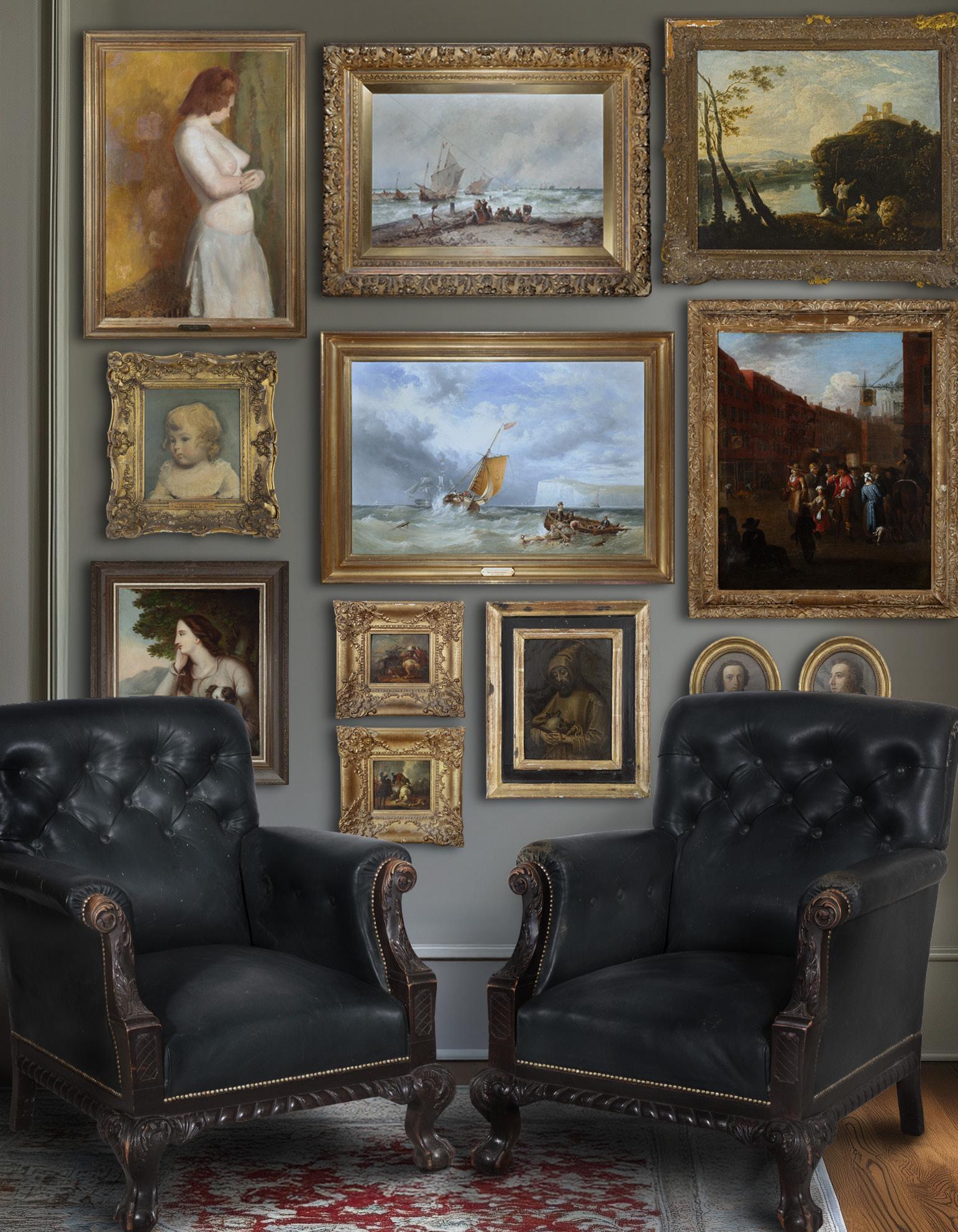



233
THEODORE WEBER (GERMAN, 1836-1907)
High tide at Gravelines Oil on canvas, 54 x 84cm
Signed ‘Th Weber’ (lower right)
€ 2,000 - 3,000
234 HENRY KING TAYLOR (fl. 1815-1874)
The Dover Pilot Cutter, No 3 Heading Back Inshore, with a large merchantman hove-to out in the bay Oil on canvas, 61 x 91.5cm
Signed ‘H K. TAYLOR (lower left)
Provenance: Sale, Bonham’s London, 28 September 2010, lot 185; With N.R. Omell Gallery, London, where acquired October 2011
€ 3,000 - 4,000
235
FOLLOWER OF RICHARD WILSON
Classical landscape, Lake Avernus Oil on canvas, 63.5 x 76 cm
Provenance: Senator Edward McGuire, Newtownpark House, Blackrock, thence by descent
€ 1,000 - 1,500
EUROPEAN SCHOOL, 19TH CENTURY
Portrait of a woman, half-length, seated holding a flute with a dog on her lap Oil on canvas, 77 x 64cm
€ 2,000 - 3,000
ATTRIBUTED TO JOHN RUSSELL RA (1745-1806)
Portrait of Miss Margaret Lee Oil on canvas, 32 x 28.5 cm
Provenance: By repute from the Collection of Sir Thomas Alston Bt. Odell Castle, Bedfordshire; Senator Edward McGuire, Newtownpark House, Blackrock, thence by descent
It is believed that Miss Margaret Lee was Sir Thomas Alston 5th Bt.’s housekeeper at Odell Castle. He had separated from his wife Catherine Davis-Bovey by mutual consent two years after their marriage. Upon his death in 1774 his entire estate was left to Miss Lee and subsequently to their illegitimate son Thomas.
€ 1,000 - 1,500
238 AFTER HIERONYMUS WIERIX
St. Francis of Assisi with Instruments of the Passion Oil on copper panel, 15 x 10.5cm
€ 400 - 500
239
A WILLIAM IV ROSEWOOD LIBRARY TABLE
the shaped rectangular top over a frieze of two long drawers, raised on lyre end sup ports, carved paw feet. 74cm high x 116cm long x 60.5cm wide
€ 1,000 - 1,500

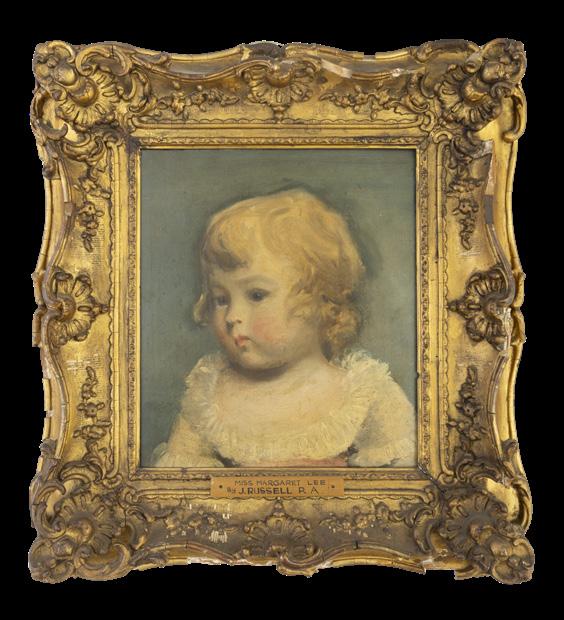



240
JOSEPH WATKINS (IRISH, 1838 - 1871)

Portrait Bust of Hon. Henry Arthur Cole, Florence Court, County Fermanagh Carrara Marble, 59cm high Signed and dated 1866
€ 2,000 - 3,000
This lot is accompanied by a hardback copy of “Florence Court - My Irish Home” by The Countess of Enniskillen
The Honourable Henry Arthur Cole was born on 14 February 1809, the fifth son of John Willoughby Cole, 2nd Earl of Enniskillen. He served with the 7th Hussars, the 12th Regiment of Foot, and for a time with the East India Company, rising to the rank of Lieutenant-Colonel. Cole entered Parliament in 1844 as MP for Enniskillen, later representing County Fermanagh from 1855 until his retirement in 1880. He died on 2 July 1890, aged 81.
The present bust, The Hon. H. A. Cole, MP by Joseph Watkins (1883-1871), was exhibited at the Royal Hibernian Academy in 1866 (cat. no. 512). Watkins, a Fermanagh-born sculptor celebrated for his portraiture, trained in Dublin and Rome and exhibited widely before his untimely death in 1871. The bust is recorded in the University of Glasgow’s Mapping the Practice and Profession of Sculpture in Britain and Ireland 1851–1951 (object ID: msib3_1203596411).
The work holds particular local significance, uniting two prominent sons of County Fermanagh—Cole, a long-serving political representative of the region, and Watkins, one of its most promising artistic talents of the 19th century.
the shaped rectangular top inset with leather scriber, above three frieze drawers with ormolu mounts, raised on sabre legs. Inscribed ‘P.SORMANI, PARIS / 10 rue Charlot’ on lock plate of central drawer. 74cm high, 128cm wide, 74 cm deep
€ 15,000 - 20,000
Although Paul Sormani worked in the 19th Century, he is best known for this wonderful, high-quality recreations of Louis XIV, Louis XV and Louis XVI period furniture. His furniture was of such high quality that he soon established himself amongst elite European society. He earned the patronage of Empress Eugénie, wife of Emperor Napoleon III, who decorated the Palace of the French Imperial Family with Sormani’s furniture.




243
A NORTH ITALIAN GILTWOOD AND ETCHED GLASS MIRROR VENICE 19TH CENTURY, of shaped form, depicting decorative motifs, 62 cm high, 36 cm wide
Provenance: Senator Edward McGuire, Newtownpark House, Blackrock, thence by descent
242
AN IRISH MAHOGANY UPRIGHT STOOL BY STRAHAN & CO. 19TH CENTURY stamped ‘Strahan & Co. 39205’, the sloped seat covered with leather and brass studding on turned legs joined by stretcher. 59cm high, 43cm wide


A PAIR OF EDWARDIAN MAHOGANY UPHOLSTERED DRAWING ROOM ARMCHAIRS, each with raised angular backs covered in a red striped fabric with loose seat cushions on inlaid tapering legs
€ 1,500 - 2,000
245
A NEAR PAIR OF FRENCH BRASS MOUNTED TWO-TIER OCCASIONAL TABLES, EARLY 20TH CENTURY,
each of squared shape with brass corner posts topped with acorn finials and ending with small brass castors, 59cm high, 37cm, 32cm
€ 300 - 500
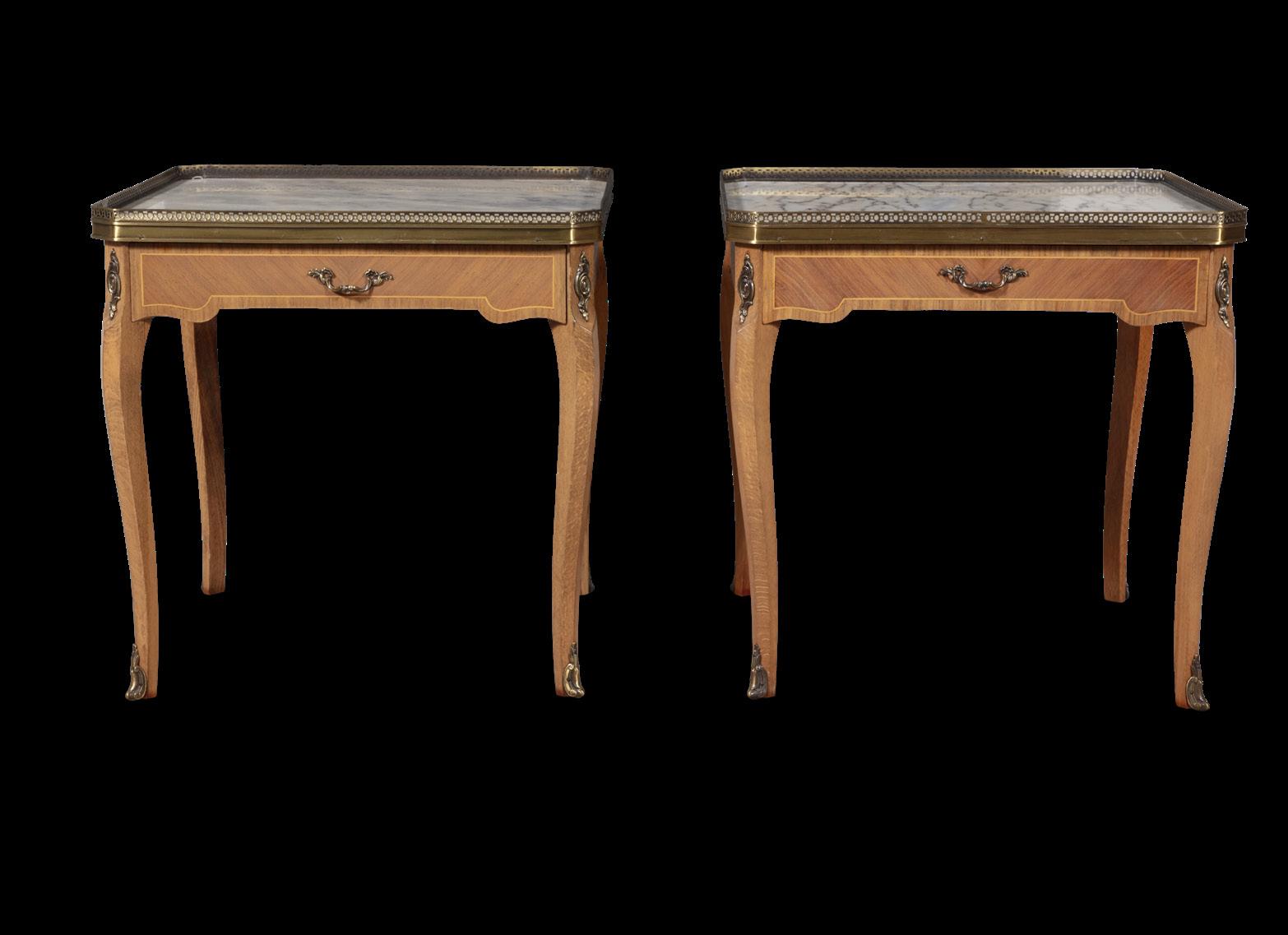
247
A PAIR OF MODERN BRASS FRAMED BUCKETS
of cylindrical form, gilt painted interiors, enclosed within a trellis frame and raised on ram masked legs and hoof feet. Each 30cm high, 25.5cm diameter
€ 400 - 600

246
A PAIR OF FRENCH KINGWOOD AND MARBLE TOP OCCASIONAL TABLES,
each of squared shape with angled corners, fitted with shallow brass gallery above a slim frieze drawer on cabriole legs, 50cm high, 50cm wide, 50cm deep
€ 300 - 400



248
A FINE SILVER PLATED OVAL MEAT DISH COVER BY MATTHEW BOULTON (17281809)
of domed shape applied with leaf cast loop handle, the interior struck with double sunburst mark of the silversmith, bearing the crest of Viscount Bangor, Co. Down. 30cm high, 54cm long
€ 300 - 500
Matthew Boulton (1728–1809) was a pivotal figure in the British Industrial Revolution, known for his innovative approach to metalworking and his production of high-quality silver and silver-plated wares. Born in Birmingham, Boulton inherited his father’s business. In 1762, he founded the Soho Manufactory, located near Birmingham, which became the largest and most technologically advanced metalworking facility of its time. Combining mechanisation with skilled craftsmanship, it set new standards in decorative metal production.
Boulton’s output was diverse, including not just silver and plated wares but also ormolu-mounted objects, clocks, and fine metal fittings. His pieces were distinguished by intricate repoussé decoration and neoclassical motifs, appealing to the tastes of the British elite. The distinctive double sunburst mark on his silver-plated items became synonymous with craftsmanship and design excellence.
His partnership with engineer James Watt significantly advanced steam engine production, while his association with John Fothergill and engraver Francis Eginton enriched the artistic quality of his work. This combination of industrial innovation and artistic integrity made Boulton’s creations highly valued both in his time and among collectors today.

249
of rectangular form with side carrying handles, the hinged lid centred with brass inlaid initials, opening to reveal a fitted interior with mirror back, green leather removable trays fitted with silver gilt and cut glass perfume bottles and boxes marked for London c.1854, mark of John Harris, and a mother of pearl handled vanity set. 17.5cm high, 35.5cm wide, 26.5cm deep
€ 1,500 - 2,000
250 A VICTORIAN SILVER PRESENTATION TWIN HAN DLE CUP,
London c.1897, maker’s mark of Sibray, Hall & Co. Ltd, the bowl with central girdle, one side engraved with the ‘Crosbie’ crest, the other side bearing the inscription ‘Presented to Major General Crozier R.E. by his friends & colleagues on his retirement from the post of Chief Engi neering Inspector to the Local Government Board...’, fur ther inscribed with date to rim of foot ‘1st June 1902’, ap plied with cast ‘harp’ shaped handles. 40cm wide across handles, 20cm high (excluding ebon stand)
€ 1,500 - 2,500


251
A GEORGE III SILVER SAUCE BOAT, Dublin (date mark and maker’s mark rubbed), of helmet form, with punched rim and decorated with chased and embossed floral swags, with applied c-scroll handle, raised on human mask capped legs with shell feet (c.9.7 troy ozs). 19cm wide over handle and spout
€ 400 - 600
252
A GEORGE III IRISH SILVER WINE COASTER, stamped twice indistinctively with maker’s mark to the base, with pierced chased and embossed body decorated with Bacchanal of Putti amongst fruiting vines, birds, windmills etc., having turned timber base. c.12cm diameter, 8cm high
€ 500 - 800



253
hallmarks rubbed, of helmet form with central girdle, with applied s-scroll acanthus wrapped handle, raised on human mask capped legs and shell feet (c.7.9 troy ozs). 14.5cm wide across handle and spout, 12.5cm high
€ 300 - 500
254
Dublin 1898, makers mark of Charles Lam be, each with central girdle and profusely embossed and chased with floral and roco co decoration, raised on lion mask legs and barley twist legs with shell feet (c.9 troy ozs)
Sugar bowl 10cm diameter, 11.5cm wide over handle and spout
€ 200 - 300


255
A LARGE GEORGE III IRISH SILVER SAUCE BOAT,
Dublin c.1750, maker’s mark of William Townsend, of helmet form, the body chased and engraved with a bird perched on a branch with blooming flowers, with applied cast handle in the form of a dolphin, raised on human mask, shell feet (16.3 troy ozs). 20.5cm wide over handle and spout, 16.5cm high
€ 500 - 700
Dublin c.1736/37, (date mark partially rubbed), mark probably of Charles Leslie (partially covered by decorative engraving), with acanthus capped scroll handles, the body with central girdle, chased decoration, on stepped circular base, with arms for the family of Kirkpatrick and possibly Ormiston, the crest of tower over rockwork not related to either Kirkpatrick or Ormiston, (43 troy ozs). 17.5cm high, 24.5cm wide over handles
Provenance: With Koopman Rare Art, London, where acquired.
€ 2,000 - 3,000
The arms as engraved upon this George II Irish Sterling Silver Twin-Handled Cup by Charles Leslie hallmarked Dublin 1736 are those of the family of Kirkpatrick. They may be blazoned as follows:
Arms: Quarterly 1st and 4th Argent a saltire azure[i] on a chief or three cushions gules (for Kirkpatrick) 2nd and 3rd Or three pelicans vulning themselves gules (for possibly Ormiston)
Crest: Upon a rock a slighted tower (proper?)[ii] (for ……?)
Upon the balance of probability and without any evidence to the contrary these arms pertain to one of the armigerous Kirkpatrick families. There were repre -

sentatives of the Kirkpatricks who lived in both Scotland and Ireland at the time of the manufacture of this cup, but sadly, there appears to be dearth of genealogical information in respect of any gentleman of the Kirkpatrick family marrying a daughter and heiress of the Ormiston family. A search of printed and other secondary sources has presently drawn a blank. (Beacon Genealogical and Heraldic Research, United Kingdom)
[i] The use of ‘a saltire azure’ (blue) would indicate the Kirkpatrick family rather than the Johnston/Johnstone family whose ‘saltire’ is tinctured ‘sable’ (black). The tincturing of the ‘chief’ of these arms are also at a variance with other known Kirkpatrick arms.
[ii] This crest appears to have no connection to either the Kirkpatrick or Ormiston families. More than likely it pertains to a later owner of the cup who caused his crest to be engraved thereon.
257
London c.1716, maker’s mark of Joseph Ward, the domed lid with scrolled thumb-piece on skirt base, the plain body with a reeded banding, marked inside lid, body and handle, (24.9 troy ozs). 18cm high, the base 13cm diameter
€ 2,000 - 3,000


258
A NORTH EUROPEAN POLYCHROME-PAINTED LIME WOOD CORPUS CHRISTI POSSIBLY 16TH/17TH CENTURY
29 cm high, 13 cm wide, 12 cm deep
Provenance: Senator Edward McGuire, Newtownpark House, Blackrock, thence by descent
€ 500 - 800


259
A NORTH EUROPEAN CARVED LIME WOOD GROUP OF THE ANNA SELBDRITT, POSSIBLY 17TH CENTURY,
standing in a classical temple shrine, figure: 29 cm high, shrine: 43 cm high, 24 cm wide, 15 cm deep
Provenance: Senator Edward McGuire, Newtownpark House, Blackrock, thence by descent
€ 400 - 600
260
A NORTH EUROPEAN STAINED-OAK FIGURE OF THE MADONNA, POSSIBLY 17TH CENTURY,
on a late silk covered stand, 21 cm high, 13.5 cm wide, 4 cm deep
Provenance: Senator Edward McGuire, Newtownpark House, Blackrock, thence by descent
€ 300 - 500

261
ITALIAN SCHOOL, 17TH CENTURY/18TH CENTURY Saint Francis in Ecstasy Oil on canvas, 123 x 90cm In a later 19th Century gilt and gesso frame.
€ 3,000 - 5,000

262
FOLLOWER OF PIETRO VANNUCCI
Portrait of The Madonna Oil on board laid down on panel, 41 x 30.5 cm
Provenance: Senator Edward Maguire, Newtownpark House, Blackrock, thence by descent
€ 1,000 - 1,500


263
A SPANISH OR ITALIAN SILK AND METAL THREAD ORPHERY PANEL POSSIBLY 16TH CENTURY
The three panels depicting saints surrounded by burgundy velvet, 105 cm high, 30.5 cm wide
Provenance: Senator Edward McGuire, Newtownpark House, Blackrock, thence by descent
€ 500 - 800
264
A CONTINENTIAL NEEDLEWORK TAPESTRY
Depicting the crucifixion of Christ, in a giltwood frame, overall: 95 x 76 cm
Provenance: Senator Edward McGuire, Newtownpark House, Blackrock, thence by descent
€ 300 - 500
265
AFTER SIR JOSHUA REYNOLDS
Portrait of William Robert Fitzgerald, Duke of Leinster
Engraved by John Dixon, 57 x 35.5cm
€ 150 - 200

266
A CARVED MAHOGANY GAINSBOROUGH ARMCHAIR 19TH CENTURY
the rectangular stuffed back, seat and armrest covered in a golden damask with down scroll arms and foliate carved cabriole legs. 101cm high, 75cm wide, 70cm deep
€ 1,000 - 1,500

267 AFTER WILLIAM HOGARTH
Black and white engravings, Marriage a La Mode, Plate 1 & IV, engraved by Richard Earlom, 49 x 62cm (2)
€ 1,500 - 2,000
269
MAP OF THE CITY OF WATERFORD
Woodblock, 42 x 52cm
In an Edwardian oak frame
€ 200 - 300

268 AFTER JOSEPH BAKER
Lincoln Cathedral in 1750
Engraving, 52.5 x 63cm
€ 300 - 500
270 AFTER DAVID ROBERTS RA
Two Egyptian Scenes
Engravings, 14.5 x 20cm
€ 150 - 200




271
of squared-shape with silvered dial, Arabic numerals with stylised hands embellished with rose-cut diamond highlights, within a narrow white enamelled surround, with easel-back stand, with maker’s marks ‘MC’ or ‘MG’, contained within its original fitted case with its easel-back stand, length 9.2cm, width 8.8cm
€ 700 - 900

272 AFTER AUGUSTE MOREAU (FRENCH 1834 - 1917)
Boy with flute
Signed to base Bronze, 72cm high
€ 600 - 1,000


273 CAPTIAN WILLIAM BAILLIE (1723-1792)
The Piping Boy, after Nathaniel Hone Mezzotint, 33 x 22.8cm
€ 500 - 800
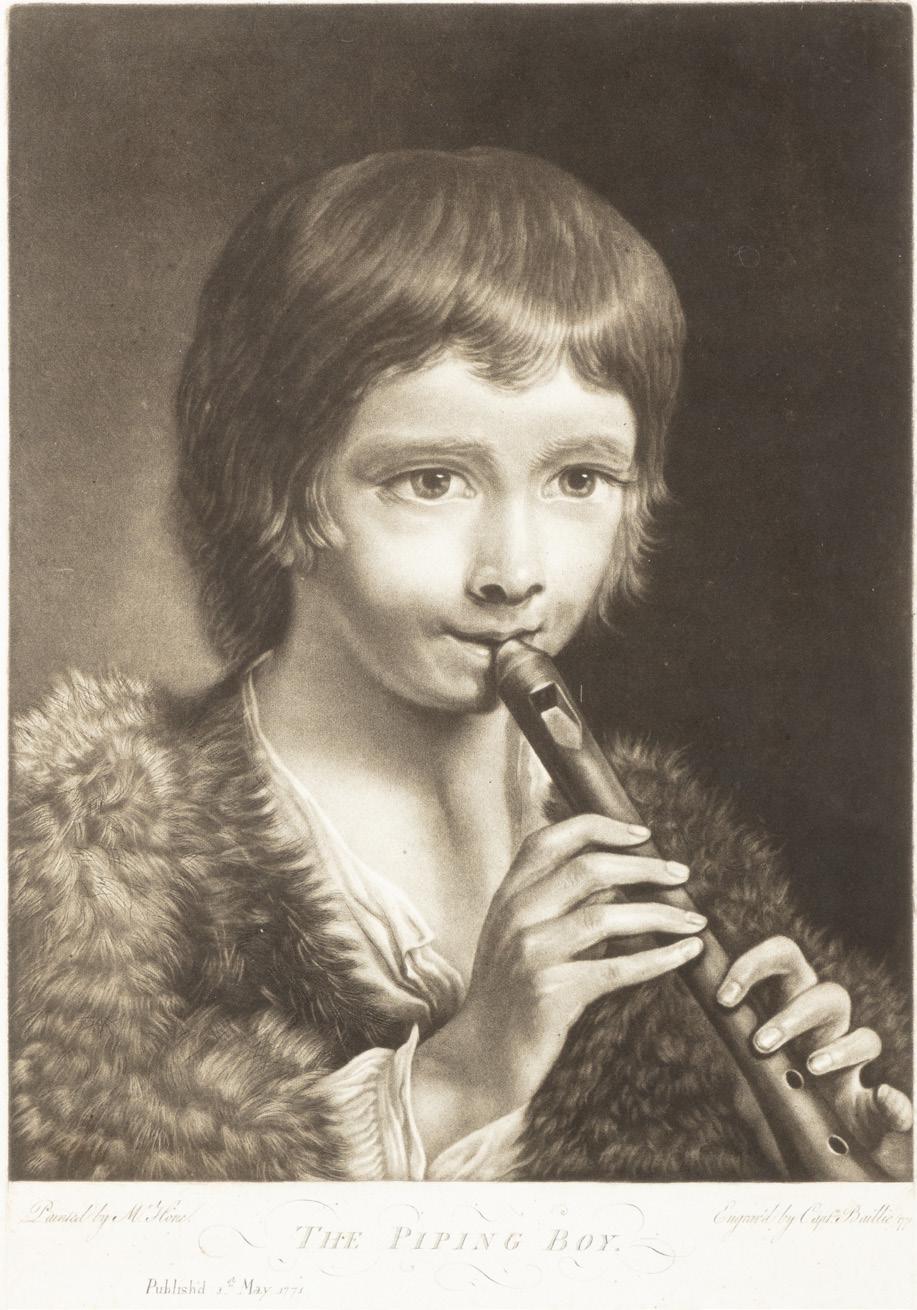


196cm x 255cm
€ 800 - 1,200

each with inverted breakfront reed top rail fluted by stylised capitals on downswept armrests on cabriole legs and stylised paw feet, 102cm high, 64cm wide, 64cm deep; together with
A VICTORIAN MAHOGANY COURT JUDGE’S THRONE CHAIR (5)
€ 2,000 - 3,000
276
JAMES E MEADOWS (BRITISH 1828-1888) Marine Scene
Signed and dated 1880 lower left
Oil on canvas, 61 x 106cm
€ 1,500 - 2,000


277
A GEORGE IV MAHOGANY DRESSING CHEST
of rectangular form fitted with four long graduated drawers, the upper drawer fit ted with a ratchet action dressing table mirror, lidded boxes and an arrangement of compartments on outset feet. 86cm high, 97cm wide, 54cm deep
€ 800 - 1,200


278
JOHN FAULKNER (1835-1894)
Boats at Galway harbour
Watercolour, 42 x 71cm
Signed and inscribed lower left
€ 800 - 1,200
279

ATTRIBUTED TO EDOUARD DROUET (1859-1945)

Pan Bronze with a green patina, on art deco marble base, 47cm high, overall
€ 500 - 800
with rectangular back, seat and armrests covered in a golden velour and supported on squared chamfered legs joined by stretcher. 97cm high
€ 1,000 - 1,500

JOSEPH JULIUS CAESAR BOND (1833-1926)
Boats on the Water, church steeple beyond, Galway Oil on canvas, 74 x 102cm
Signed and dated 1850, lower right
€ 1,000 - 1,500
William Joseph Julius Caeser Bond, otherwise known as ‘Alphabet Bond’ was a well-regarded English landscape and marine painter and member of the Liverpool Academy in the 19th century. Bond began quite humbly as the son of a post-office clerk and trained in the art of picture restoration and cleaning before taking up painting on the advice of local tobacco merchant and collector John Miller who had admired some of his Liverpool dock sketches.
As referenced in Denys Brook- Hart’s comprehensive book on the subject entitled ‘British 19th Century Marine Painting’, Bond forged a rather illustrious career in the North of the country, earning the moniker ‘The Turner of the North’ as his later style favoured the semi-impressionistic style and warm palette associated with the London born artist. This painting presented is identified as quite an early work by the artist by both the date of 1850 and the decidedly tighter use of brushstrokes and attention to detail.
The scene presented is certainly one of Bond’s lesser-known examples as it depicts the Woodquay area of Galway city, specifically ‘Sickeen’, now familiar to the viewer as St. Brendan’s Avenue. Silhouetted in the background we see the spire of St. Nicholas’s Collegiate Church as it was in 1850 before it was rebuilt and furnished with a clock in 1883 and to the right the Franciscan Abbey built earlier in the 19th century. An assemblage of squat straw-thatched cottages smoke gently in the midground, of which nothing remains today. Bearing in mind that the scene painted was produced during the Great Famine and before the re-development of the city it serves as a valuable record of the urban landscape in the mid-nineteenth century, of which there are few visual records.

283 AN IRISH ARBUTUS AND MARQUETRY INLAID KILLARNEY WORK TABLE, 19TH CENTURY
the hinged top centred with a depiction of Muckross Abbey ruins, enclosing a fitted interior on a tapering column and paw feet, 75cm high, 57cm wide, 32cm deep
€ 2,000 - 3,000
282
AN IRISH ARBUTUS ‘KILLARNEY WORK’ EXTENDING BOOK SLIDE,
19th century, inlaid with a depiction of Ross Castle, Killarney, 37cm wide when compact
€ 150 - 250
284 A GEORGE III MAHOGANY THREE TIER CIRCULAR DUMBWAITER
with graduated dish tier joined by turned baluster centre column, splayed triform base. 121cm high
€ 300 - 500




A PAIR OF SIMULATED MARBLE TABLE LAMPS with painted columns and stepped plinth bases, each with blue shades. 67cm high to light fitting (E)
€ 300 - 500
286
A PAIR OF BRASS TABLE LAMPS each with spiral turned supports, with cream shades. 80.5cm high to light fitting (E)
€ 400 - 600
288
AN IRISH GEORGE III MAHOGANY PEMBROKE TABLE
extending to rectangular shape the top with round corners and reeded edge on a turned and fluted central column arched legs the claw and ball feet with barrel casters. 69cm high, 67cm wide
€ 600 - 800

287 A TERRESTRIAL DESK GLOBE BY WAGNER & DEBES
Leipzig, early 20th century, inscribed “Terrestrial Globe, 96 cm circumference, reworked by Dr. H. Fischer, Leipzig, Wagner & Debes, Lehrm.Anst., Ludw. Jul. Heymann, scale 1:42,000,000.”, on turned timber stand. c.83cm high including stand
€ 500 - 700


289
AFTER FRANCESCO ALBANI (BOLOGNA 1578-1660)
Toeletta Di Venere
Oil on canvas, 62.5 x 78.5cm
€ 2,000 - 3,000
The present picture is based on a well known work by Francesco Albani (1578–1660), a leading figure of the Italian Baroque and the Bolognese school. Trained from the age of twelve under Denis Calvaert and later with the Carracci at the Accademia degli Incamminati, Albani moved to Rome around 1600. There, he worked under Annibale Carracci and alongside Guido Reni and Domenichino on major commissions, developing the lyrical, classicising style that defined his career.
Depicting Venus at her toilette—attended by nymphs and cupids, beside a fountain and with her chariot above—the scene reflects Albani’s gift for weaving mythological themes into Arcadian settings. The reclining goddess before a mirror held by Cupid recalls the “Toilet of Venus” motif, popularised by Venetian artists and reimagined with Albani’s distinctive style.
This painting is in reverse to versions in the Louvre and Prado, and likely based on Benoît Audran the Elder’s (Lyon, 16611721) engraving after Albani. The reversal, typical of printmaking, suggests the composition was drawn from the print rather than the original, a common practice in the 18th century when Albani’s mythologies were highly prized in France. Albani’s idealised vision—his cherubs said to be modelled on his twelve children—appealed to both religious and aristocratic patrons. Through painting and print, his work helped define the elegant, decorative current of Baroque classicism. A closely related painting to this lot sold in Christie’s, London 24 Apr 2001 Lot 106 for £5,875.

291
The rectangular plate depicting Christ on the Cross with Mary, surrounded by a pierced giltwood frame, 65 cm high, 46.5 cm wide
Provenance: Senator Edward Maguire, Newtownpark House, Blackrock, thence by descent
€ 500 - 800
AN IRISH REGENCY MAHOGANY SLENDER OPEN BOOKCASE, EARLY 19TH CENTURY with white marble top, with moulded rim and roundels to the centre and corners, with spiral engaged columns and reeded side panels, on reeded legs and ball feet, 118cm high, 159cm wide, 32cm deep

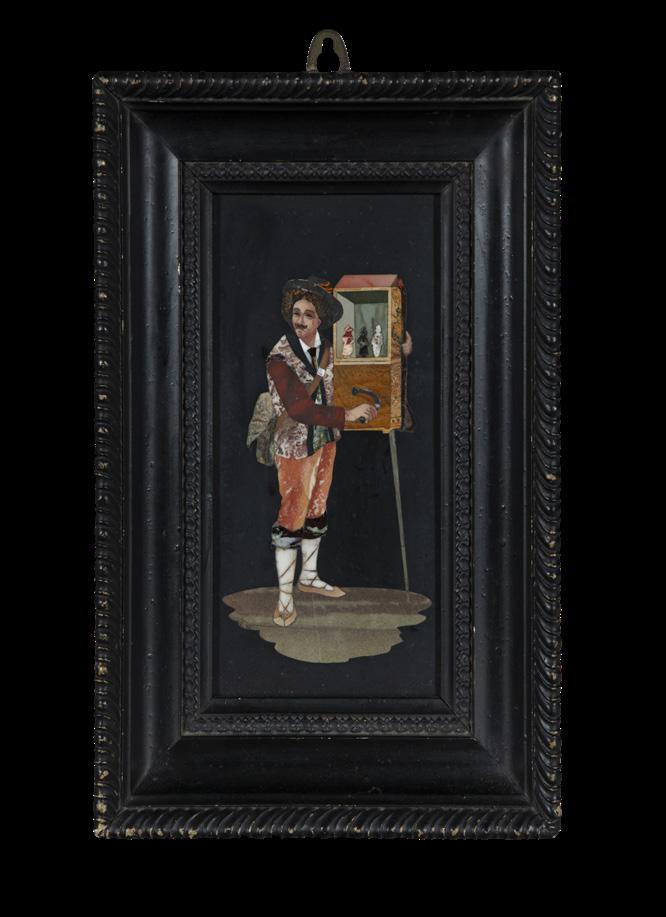
292
AN ITALIAN PIETRA DURA FRAMED PANEL, MID 19TH CENTURY, depicting a puppeteer / street entertainer in various coloured stones against a black ground. 21 x 10cm
€ 800 - 1,000
293
A CARVED LIMEWOOD MODEL OF A SCALLOP SHELL, in upright position on square plinth base, 40cm high in total
€ 150 - 250

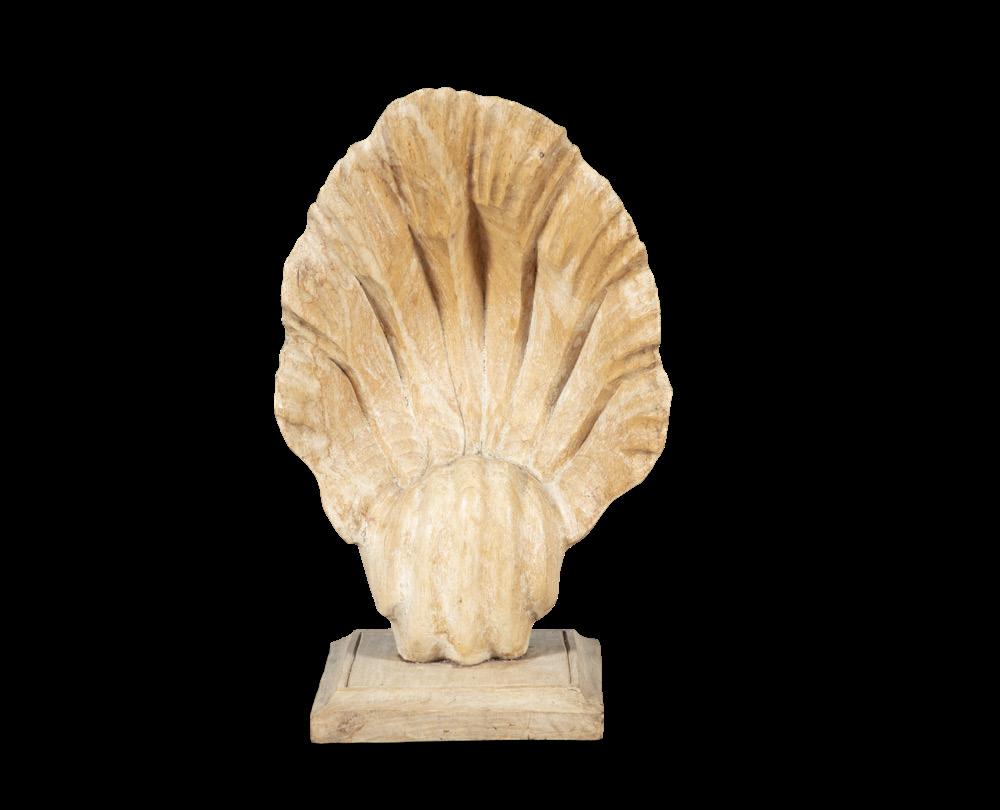
294
A SET OF THREE ‘COUNTY OF DOWN 1835’ IMPERIAL BRONZE MEASURES BY SAMUEL GATCHELL & SON, DUBLIN, graduating in size, comprising of an Imperial half pint, and Imperial gill and an Imperial half gill, the largest being 9.5cm high, 7.8m diameter
295
A WILLIAM IV ROSEWOOD RECTANGULAR LIBRARY TABLE,
the figured top with rounded corners above twin frieze draw er, on turned lotus carved col umn and concave base, 74cm high, 128cm wide, 64cm deep
€ 1,500 - 2,000

296
CONSALVO CARELLI (1818 - 1900)
A View of the formal gardens at Powerscourt from the House Watercolour, 12 x 17cm (4¾ x 6.6”)
Provenance: With Thomas Agnew & Sons, London, label verso
€ 600 - 800
297
A PAIR OF LARGE POTTERY MODELS OF IRISH GREYHOUNDS
each 90cm high, 54 cm wide
€ 1,000 - 1,500



298
A FINE POLISHED BRASS DOOR LOCK, 19TH CENTURY
from Clancy Barracks, Dublin, the rectangular plate applied with maker’s label ‘Hobbs & Co., 76 Cheap side, London’, with rivet holes, receiver and working key engraved ‘Shell store 10 and 11 gun’, the box plate 20 x 13cm
€ 300 - 400

WITH BOOT TREES
51cm high
€ 200 - 300


301
A MAHOGANY BROWN LEATHER BUTTON BACK TUB ARM CHAIR
with close-nailed padded back and seat, out-turned arms on fluted tapering legs, 79 cm high, 81 cm wide, 84 cm deep

300
ATTRIBUTED TO FRANCESO ANTONIO SIMONINI (1696-1753)
Battle Scenes
A pair, oils on canvas laid down on panel, Each 16 x 19cm
Provenance : The late Elizabeth O’Kelly, formerly of The Dower House, Emo Court, Co. Laois; Sale, Sheppards, 27 April 2017, lot 2013
€ 1,000 - 1,500

302
A GEORGE III MAHOGANY PEMBROKE TABLE CIRCA 1800,
extending to oval shape, the moulded top with drop leaf sides, fitted with a flame-mahogany frieze drawer and square tapering legs with castors, 71cm high, 97cm long, 76cm wide
€ 600 - 800
1809 - 1876)
Figures on camel back with donkeys with walled town beyond Gouache and watercolour, 25.5 x 36.5cm
Signed lower right
€ 1,500 - 2,000

305
AN EARLY VICTORIAN OAK CELLARETTE BY STRAHAN OF DUBLIN
of sarcophagus form, with hinged lid, raised on lion paw feet, stamped to inside and numbered ‘15667’. 60cm high x 76cm x 59cm
€ 1,000 - 1,500


304
A GEORGE III CARVED MAHOGANY TILT TOP WINE TABLE,
of shaped carved form, the top with circular roundels and carved leafy boarders on turned and leaf carved centre pillar and tripod base. 31cm diameter, 71cm high
€ 800 - 1,200


Design for a decorative wall panel
Watercolour, 52 x 42cm
Inscribed with ‘No. 8’, also with collector’s stamp recto and numbered ‘39’
€ 700 - 1,000

Within the arched green foliage border, adorned with small flowers and leaves, and among the stylised lion heads holding yellow garlands, exotic birds, butterflies, and insects, is a panel depicting a parrot harnessed to a chariot, with a grasshopper acting as the charioteer. The whimsical image is based on an etching by Nicola Vanni (1720–1800) after Roccus Pozzi (fl. 1750–1770). The image is inspired by ancient Roman wall paintings discovered in Herculaneum, which were documented in the 18th-century publication Le Antichità di Ercolano Esposte, published between 1757 and 1792 by the Regia Stamperia. An example of a completed wall panel featuring the same grasshopper driving a parrot-cart can be found in the Vana-Võidu Manor, Estonian Academy of Arts, Estonia, completed in the mid-19th century.
The collectors mark in blue ink (lower right), almost octagonal in form, resembles a mark that has been observed on several drawings spanning a variety of schools by Frits Lugt and recorded in Les Marques de Collections de Dessins & d’Estampes (L. 4792). Its appearance remains somewhat enigmatic. Notably, multiple examples from the renowned collection of Albert Finot (L.3627) bear a mark similar to this lot. Among these are sheets presented at the Drouot Estimations sale held on 18 November 2005 in Paris, including Lot 34, attributed to Roland-Louis Trinquesse; Lot 40, attributed to Louis Tocqué; Lot 87, ascribed to Jan van Huysum; part of Lot 92, attributed to the School of Jean-Baptiste Oudry; and part of Lot 94, from the workshop of Domenico Piola. An earlier appearance possibly of this mark was documented during a sale on 6 December 1982 in Paris, featuring sheets from the same collection. On this occasion, the mark was stamped with the letter “C” at its center, on the recto of a drawing attributed to P. Damini (Lot 16), now part of a private Parisian collection. The relationship between the mark and the letter “C” remains uncertain. Additionally, the mark has been identified on the counterproof of a drawing attributed to Adam Frans van der Meulen, engraved by Jan van Huchtenburg, though the provenance of this example remains unclear (Sanchez-Seydoux Gallery, Paris, 2001).
307
A GEORGE IV INLAID MAHOGANY FOLDING TOP TEA TABLE, the cross banded top, above a frieze decorated with ebony stringing, raised on turned and ropetwist centre pillar, on concave base and four reeded downswept legs, cast brass toe caps and castors. 76cm high, 99cm wide,

309

308
A PAIR OF EARLY VICTORIAN MAHOGANY HALL CHAIR C. 1840
each raised back carved with a rondel over solid panel seat and sabre legs. 85cm high, 40cm wide
€ 400 - 600
A 19TH CENTURY MAHOGANY AND BRASS INLAID BRACKET CLOCK
by James Scott, London, of architectural form, the case surmounted by a domed pagoda top with central and flanking brass ball finials above a glazed arched door enclosing a silvered dial with Roman numerals and subsidiary strike/silent and regulation dials, signed James Scott, London, with pierced Breguet-style hands, the sides with fish scale brass panels and carrying handles, the front with inlaid brass floral and Greek key motifs within fielded panels, flanked by Corinthian columns on an outset plinth base and paw feet; the movement signed ‘James Scott, London, Hor R. H.R.H the Duke of Kent’, with pendulum and winding key. 61cm high, 37cm wide, 22cm deep
A similar example by James Scott is held in the Royal Collection Trust, UK.
€2,500 - 3.500
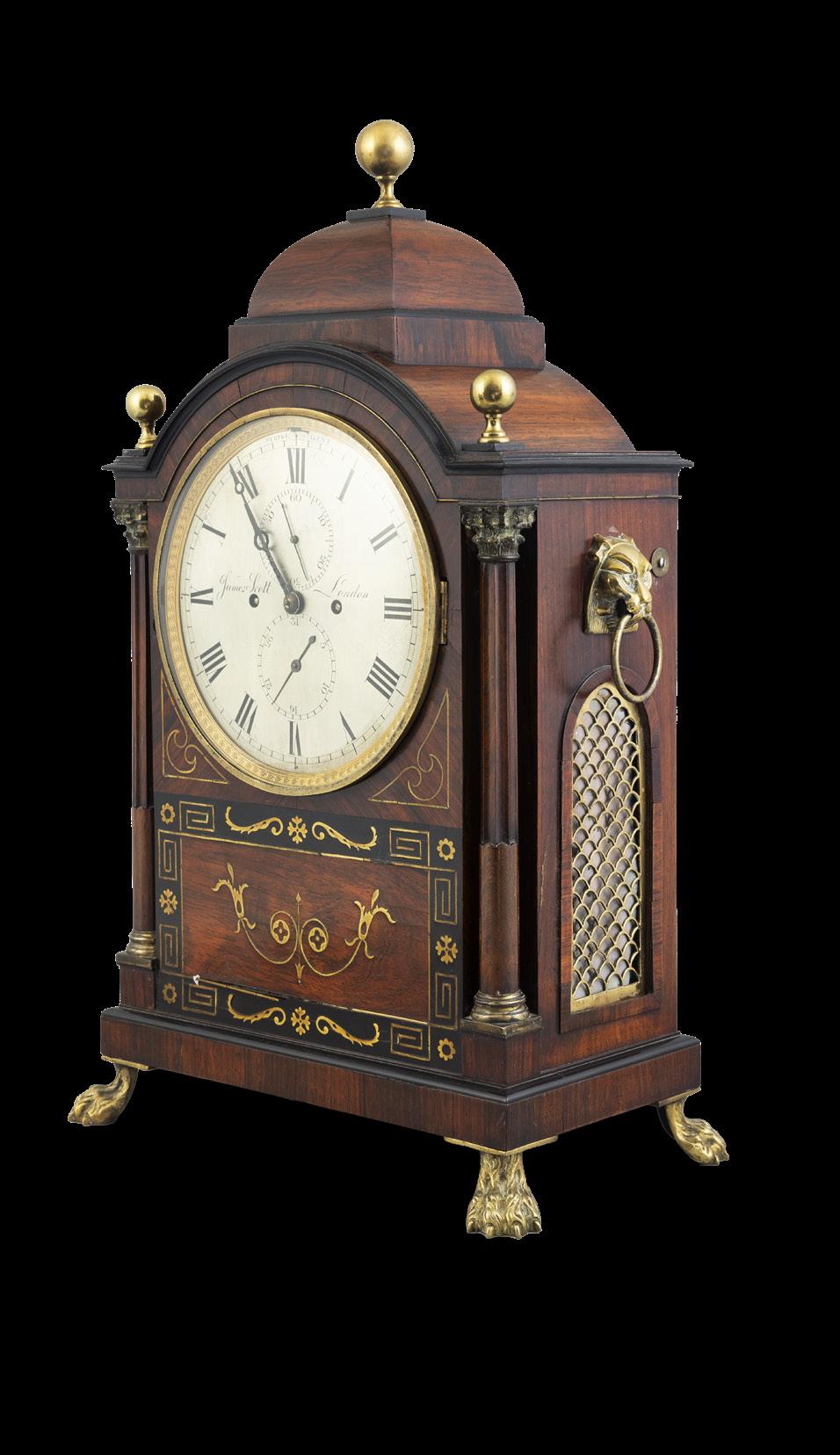
each rectangular top with canted corners crossbanded and decorated with brass foliate inlay, the interiors baize lined in green on tapering scroll supports, arched downswept legs, brass paw feet and castors. 76cm high, 90cm wide, 45cm deep
€ 2,000 - 3,000
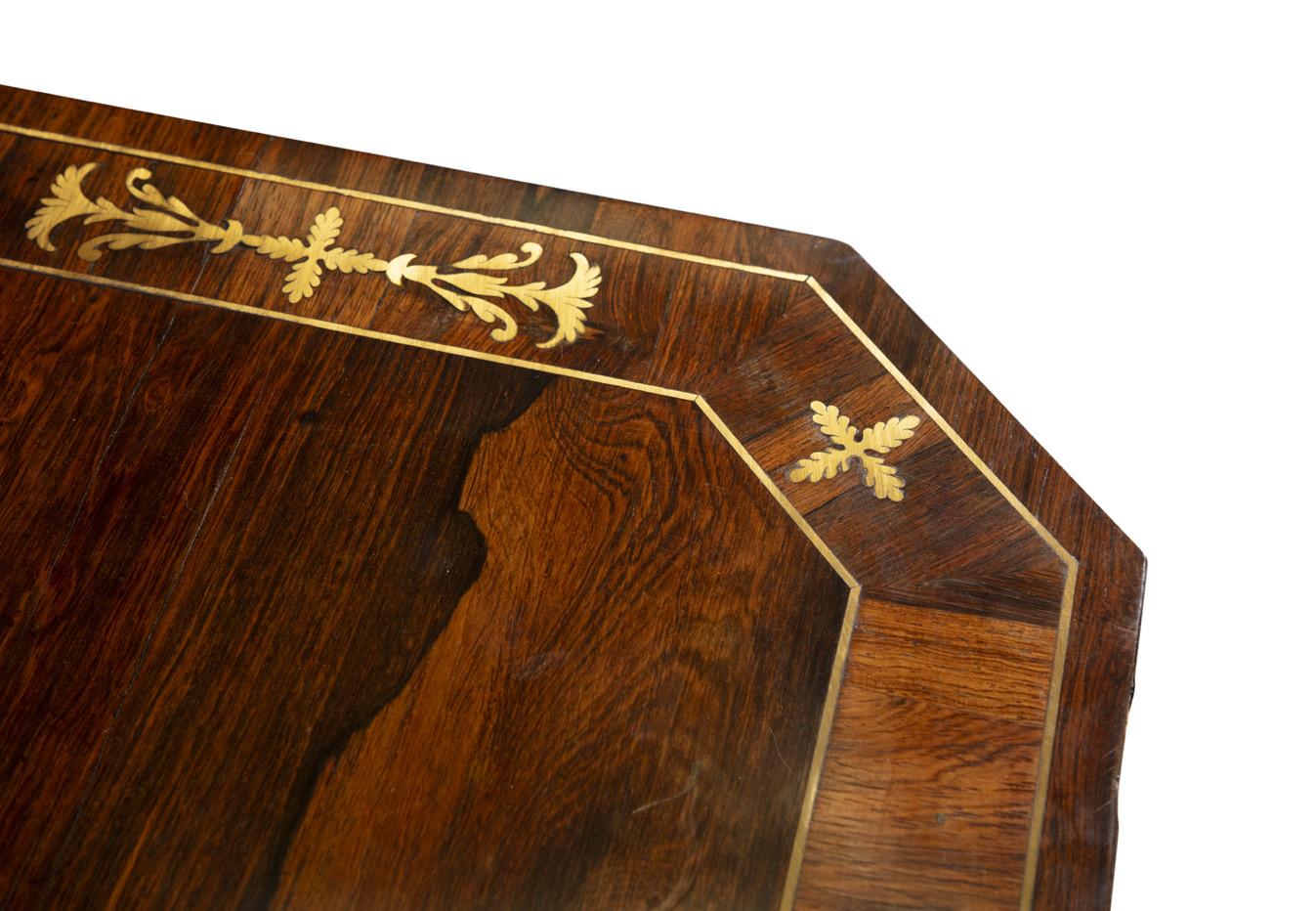
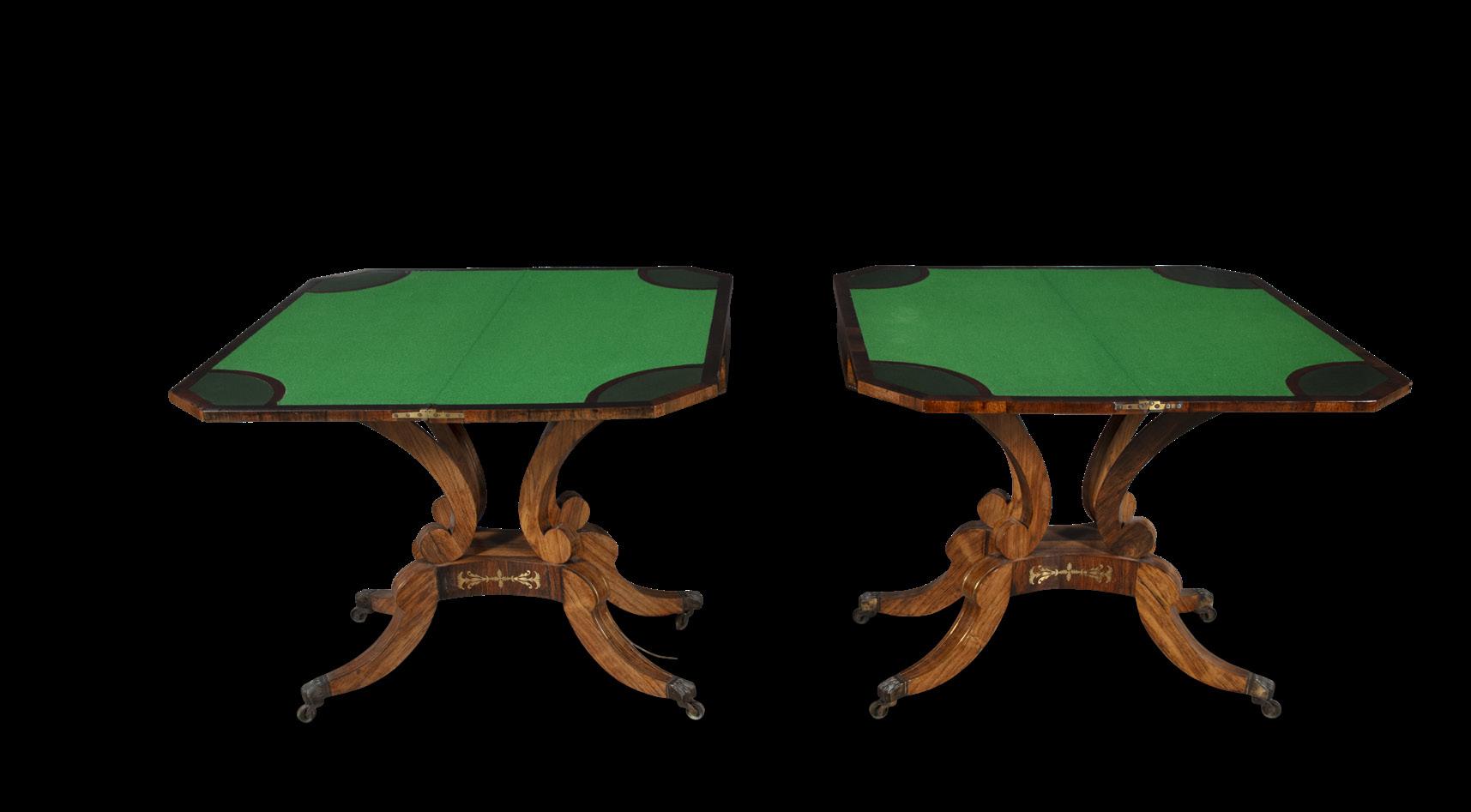


A FRENCH GILTMETAL KINGWOOD MARQUETRY AND BRASS MOUNTED BED IN THE MANNER OF LINKE FRANÇOIS 19TH CENTURY,
the domed headboard, with an architectural moulded cornice, above a central oval vignette depicting cupid with his bow and arrow drawn, enclosed within brass scrolling borders, the bed end with corresponding decoration. The headboard 174cm high, 170cm wide
€ 1,500 - 2,500

312 WILLIAM MAGRATH (1838 - 1918)
Jealousy
Watercolour, 36 x 66cm
Signed
Provenance : Sale, Whyte’s 16 September 2003, lot 167
€ 1,000 - 1,500

313

A MAHOGANY AND SATIN WOOD BANDED TAMBOUR TOP WRITING DESK of rectangular form with arched domed slide, the interior with short drawers and leather writing top on square tapering legs and spade feet. 90cm high, 87cm wide, 54cm
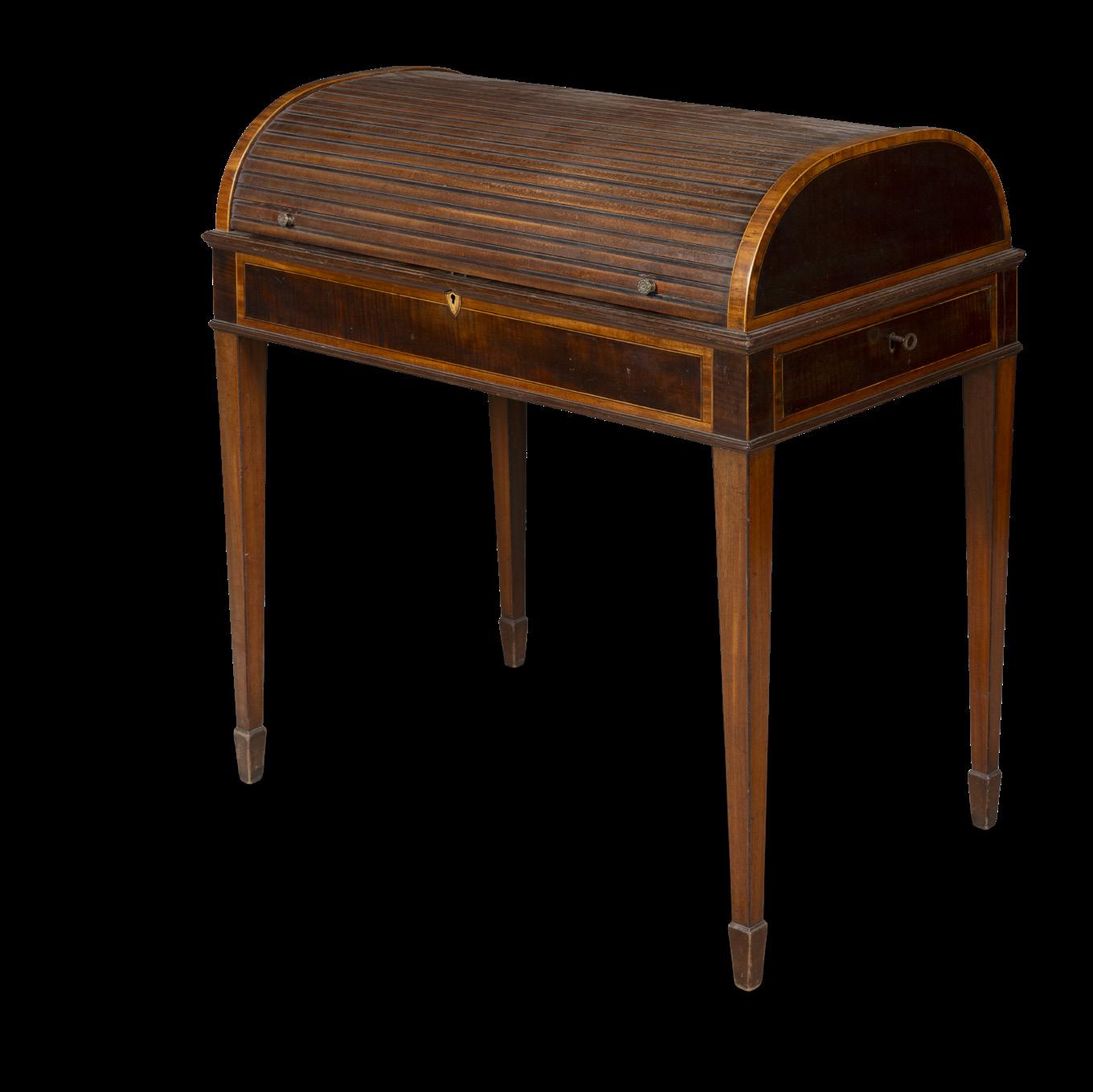

FRAME MIRROR 19TH CENTURY
fitted with bevelled plate, 112 x 92cm
€ 500 - 800


rectangular top over a frieze with twin faux drawers, with end supports joined by a turned stretcher, downswept feet with castors.
€ 400 - 600
rectangular back and broad seat covered in a soft cream fabric on square legs joined by H-stretcher. 90cm high, 72cm wide, 70cm deep
€ 1,000 - 1,500

318
ENGLISH SCHOOL, 19TH CENTURY
Galleon at Sea
Indistinctly signed, ‘C.K.R’ (lower left)
Oil on canvas, 40 x 59cm

319
DUTCH SCHOOL
Maritime Landscape
Oil on board, 20.5 x 26cm
€ 400 - 600

of rectangular form, the top with rounded corners, above two long and three short drawers, with brass drop handles and lock plates, flanked by fluted gilt ribbon tied corners, above shaped carved parcel gilt apron, raised on short cabriole legs and claw and ball feet. 109cm high, 152cm wide, 54.5cm deep
€ 600 - 1,000



Dublin c.1752, maker’s mark of Andrew Goodwin, of helmet form with central girdle and engraved with squirrel crest, raised on three lion mask capped legs with shell feet (c. 5.7 troy ozs). 11cm high, 14cm over handle and spout
€ 600 - 800
321
A SET OF ELEVEN CLEAR AND CUT GLASS WINE RINSERS,
19th century, each with double lipped rim, the bodies cut with a band of diamonds and a row of facet-cut fluting, 15cm wide
€ 400 - 600
322
A SET OF FOUR WINE GLASS RINSERS,
19th century, each with double lipped rim, the exteriors cut with a band of diamonds and facets, 14cm wide
€ 200 - 300

324
A GEORGE III BRIGHT-CUT SILVER SOUP LADLE,
Dublin 1798, maker’s mark of Samuel Neville, with scallop bowl, the handle crested (c.5 troy ozs). 36cm long
€ 300 - 500
325

Dublin c.1745, maker’s mark of William Williamson, of tapered cylindrical form, the hinged lid with pineapple finial, the body with chased and embossed with rocaille and floral decoration, having shields on both sides containing original crests, with timber handle (c. 34.8 troy ozs). 24cm high, 25cm wide over handle and spout
€ 4,000 - 6,000

326

A FRENCH WHITE-PAINTED AND PARCEL GILT PIER MIRROR, 19TH CENTURY, of upright rectangular form, with plain glass plate, flanked by relief carved foliate trails and surmounted with a panel carved and decorated with scallop shells and rosettes,
326A
A CONTINENTAL CREAM AND PARCEL GILT SIDE TABLE, LATE 18TH CENTURY, the white-painted timber top above a frieze carved with rosettes and bellflowers on supports carved with opposing leaves and tapering flutes. 86cm high, 120cm wide, 59cm deep

€ 1,500 – 2,000
327
SIR WINSTON CHURCHILL,

A typewritten poem from Mrs Edna Robinson to Sir Winston Churchill on the occasion of his birthday (November 1961) and by return a facsimile letter from Churchill expressing gratitude, on watermarked paper headed ‘28 Hyde Park Gate, London SW7’ with original envelope complete with postal history marks
€ 100 - 150
328
A BUTTON-BACK CLOSE-NAILED WINGBACK ARMCHAIR / WHEELCHAIR, 19TH CENTURY, upholstered in red/orange hide with adjustable arms and slide-out footrest; raised on brass and leather wheels, 74cm wide, 123cm high, 76cm deep
€ 200 - 300

329
FRANCIS WILLIAM TOPHAM, RA OWS (1808-1877)
‘Late Again’
Watercolour, 27 x 20cm
Signed and dated ‘F.W. Topham 1856’ (lower left)
Provenance : With Ferguson Gallery, Donegal; Sale, Whyte’s, 17 February 2004, lot 159
€ 500 - 800
331
A VICTORIAN BLUE LEATHER UPHOLSTERED ARMCHAIR, with out-turned arms and rectangular padded back.
€ 500 - 800

330
DAME LAURA KNIGHT RA RWS (1877-1970)
Bareback
Black chalk and watercolour on paper laid down on board, 27.3 x 36.8cm
Signed with initials, inscribed and dated ‘Islington 1938 L.K.’ (lower right)
Provenance : Sale, Christie’s, London, 4 June 2008, Lot 84
€ 1,500 - 2,000
331A
A GEORGIAN MAHOGANY DOUBLE DROP LEAF
TABLE, 18TH CENTURY
the body of oval form with rounded drop-leaf sides, on slight cabriole legs on facetted pad feet. 70cm high, 92cm wide



332
A FRENCH TAPESTRY, MODERN
Depicting figures in a stylised landscape, 128 x 145 cm
€ 300 - 500
333
AN AUBUSSON STYLE TAPESTRY, MODERN
Depicting idyllic scenes, 98 x 180cm
€ 400 - 600


334
A MAHOGANY BREAKFRONT BOOKCASE, 19TH CENTURY with architectural pediment decorated with Greek key; above four astragal glazed doors, opening to a shelved interior, above cupboard base, 300cm wide, 273cm high, 43cm deep
€ 1,500 - 2,500


A COLLECTION OF NEEDLEPOINT TAPESTRY SECTIONS, each of a floral design, the longest being 487cm long (5)
€ 500 - 800

336
FANNIE MOODY (BRITISH 1861 -1948)
The Butcher’s Cart
Watercolour, 34 x 36cm
Signed
€ 800 - 1,200


337
AN IRISH GEORGE III MAHOGANY FOLDING TOP CARD TABLE, of rectangular shape with outset rounded corners, the top opening to reveal a red baize lined inte rior with candle holders and counter wells, raised on cabriole legs and pad feet. 74cm high, 87cm wide, 43cm deep
€ 800 - 1,200

338
A CARVED GILTWOOD AND MARBLE TOPPED CONSOLE
TABLE, CIRCA 1830, IN THE MANNER OF DEL VECCHIO, of rectangular form and fitted with verdis antico marble panel above a bobbin turned recessed frieze on acanthus carved cabriole legs ending with paw feet, 93cm high, 143cm wide, 58cm deep.
€ 2,000 - 3,000


339
A GEORGE III MAHOGANY FRAMED WINGBACK ARMCHAIR with stuffed back and seat, lacking upholstery out turned armrests, cabriole legs and pad feet. 116cm high, 77cm wide
€ 1,000 - 1,500
340
J.J EVERARD
Sailing Boats at Sea
Signed and dated J.J Everard, 1885’ Oil on canvas, 45.5 x 75.5cm
€ 800 - 1,200


A VICTORIAN WHITE PAINTED CARVED WOOD FIRE SURROUND, the outset mantle above a frieze carved with Classical females between rows of upright acanthus leaves and eggand-dart banding supported upon a pair of scroll uprights carved in relief with oak leaves and acorns 141cm wide and approximately 137cm high
€ 1,000 - 1,500

343 A MAHOGANY OVAL DROP LEAF TABLE, 19TH CENTURY
with drop leaf sides and rounded moulded edge on square gate leg action supports, with stamp for the Customs House, Dublin . 73cm high, 147cm high
€ 700 - 1,000
342
AN EARLY VICTORIAN MAHOGANY FRAME ELBOW CHAIR, the oval padded back, armrests and seat upholstered in burgundy hide, raised on turned fluted legs
€ 200 - 300


AN IRISH MAHOGANY WRITING TABLE BY ARTHUR JONES, Dublin, mid 19th century, the rectangular top with three-quarter gallery, fitted with tooled leather panel over twin frieze drawers and turned legs, stamped twice to drawer edge, 80cm high, 91cm wide, 57cm deep
€ 600 - 800
345
A GEORGE IV INLAID MAHOGANY PEMBROKE TABLE,
the double drop leaf top with canted corners and inlaid border, above single frieze drawer with boxwood string ing and twin handles, raised on square tapering legs and brass toe caps and castors. 72.5cm high, 84cm wide, 51.5cm deep (closed), 97.5cm deep (opened)
€ 400 - 600



346
A VICTORIAN WALNUT BAGATELLE TABLE the out folding top revealing a baise lined game interior, raised twin fluted and turned supports, joined by stretcher and scroll feet, with two pool cues (lacking playing balls). 91cm high, 128cm wide, 78cm deep. The top 121cm long, 71cm wide
€ 500 - 800

Auction Tuesday 13 th May 2025
Achieving the highest results for Antique, Vintage & Contemporary Jewellery at auction

By Michele Della Valle

Auction Thursday 15th May 2025




HUGH DOUGLAS HAMILTON RHA (1740-1808)
Portrait of William Ormsby, M.P. of Willowbrook, Co Sligo (1718-1781); Portrait of Hannah Ormsby, née Wynne of Hazelwood, Co. Sligo ( - 1798); Portrait of Maria Susannah Ormsby (1745-1827); and Portrait of Jane Ormsby (1750-1802) pastel on paper, oval, each 23.5 x 19.5cm, in original giltwood frames (4)
Estimate: €15,000 - 20,000
Enquiries:
Stuart Cole s.cole@adams.ie
Auction Tuesday 20th May 2025
Some lots featured at the Festival of Garden and Nature, Stradbally Co. Laois.

A CARVED WHITE MARBLE FIGURE OF DIANA, 19TH CENTURY, 190cm high
€ 2,000 - 4,000
Enquiries: Nat Nicholson n.nicholson@adams.ie


Nigel Slater, Diar muid Gavin, Darina Allen, Tom Stuar t-Smith, Sean Ronayne, Johnny F l ynn, Fergus Gar r ett, Dominic West, Klaus Laitenberger, Jamie Walton (aka Nettles & Petals), Mer lin Sheldrake, Char lie Har pur, Catherine FitzGerald, ...and many other g reat voices & minds from the worlds of Gardens and Nature


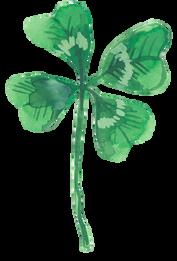





A weekend of intriguing & enter taining talks by world leaders of hor ticulture, botany, food and nature, Workshops and practical demos in the How To... area
Garden Tours of Ballintubber t’s org anic g ardens
Carefully selected plant and g arden stalls


Seriously g ood food and coffee stalls www.festivalofgardensandnatur e.com @festival of gardens and natur e









Auction Wednesday 28 th May 2025
AUCTION WEDNESDAY 29TH MARCH 2023
Auction Wednesday May 28th 2025
Now Consigning

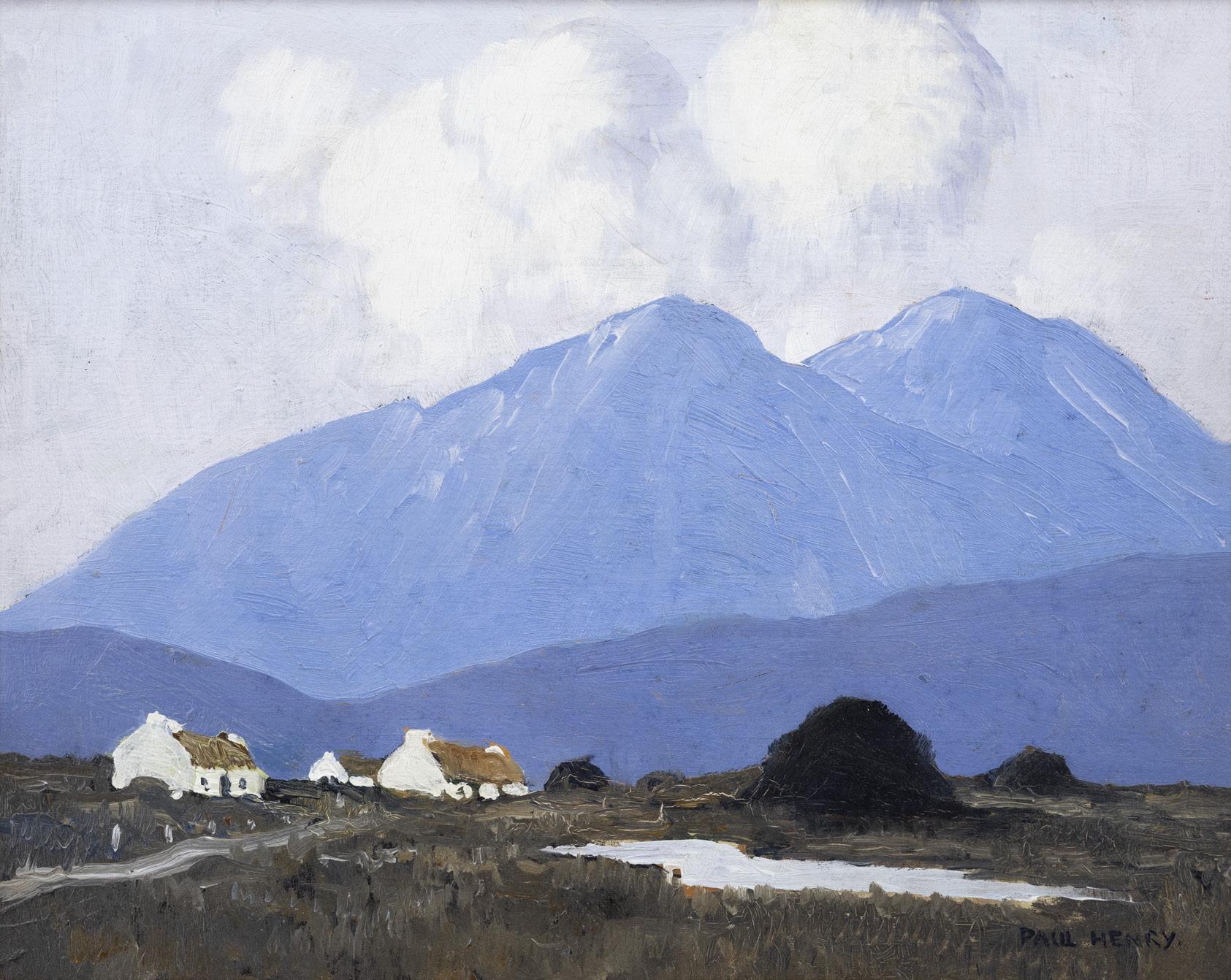
Mary Swanzy HRHA (1882-1978)
Pont Du Gard
Oil on canvas, 53.3cms x 45.7cms
PRICE REALISED € 50,000
PAUL HENRY RHA RUA (1876-1958)
Mountain Landscape with Cottages c.1926-30
Oil on board, 28 x 35.5cm (11 x 14’’)
We are now accepting further entries for this prestigious sale
For informed, confidential and friendly advice on including works please contact James O’Halloran (j.ohalloran@adams.ie), Nicholas Gore Grimes(nicholas@adams.ie) or Stuart Cole (s.cole@adams.ie)

Auction Wednesday 25th June 2025


A RETICULATED WHITE JADE ‘EGRETS AND LOTUS’ GROUP
明代 青白玉透雕 ‘一路连科‘ China, Ming dynasty
Price realised: €42,500
For informed, professional and friendly advice contact Dr. Wei Wang
wei.wang@adams.ie

26 St. Stephen’s Green, Dublin 2. Ireland
+353 1 676 0261
info@adams.ie | www.adams.ie

The Auctioneer carries on business on the following terms and conditions and on such other terms or conditions as may be expressly agreed with the Auctioneer or set out in any relevant Catalogue. Conditions 12-21 relate mainly to buyers and conditions 22-32 relate mainly to sellers. Words and phrases with special meanings are defined in condition 1. Buyers and sellers are requested to read carefully the Cataloguing Practice and Catalogue Explanation contained in condition 2.
1. In these conditions the following words and expressions shall have the following meanings:
Auctioneer - James Adam and Sons trading as Adam’s.
Auctioneer’s Commission - The commission payable to the Auctioneer by the buyer and seller as specified in conditions 13 and 25.
Catalogue - Any advertisement, brochure, estimate, price or other publication.
Forgery - A Lot which was made with the intention of deceiving with regard to authorship, culture, source, origin, date, age or period and which is not shown to be such in the description therefore in the Catalogue and the market value for which at the date of the auction was substantially less than it would have been had the Lot been in accordance with the Catalogue description.
Hammer Price - The price at which a Lot is knocked down by the Auctioneer to the buyer.
Lot - Any item which is deposited with the Auctioneer with a view to its sale at auction and, in particular, the item or items described against any Lot number in any Catalogue.
Proceeds of Sale - The net amount due to the seller being the Hammer Price of the Lot after deducting the Auctioneer’s Commission thereon under condition 25 the seller’s contribution towards insurance under condition 26, such VAT as is chargeable and any other amounts due by the seller to the Auctioneer in whatever capacity howsoever arising.
Registration Form or Register - The registration form (or, in the case of persons who have previously attended at auctions held by the Auctioneer and completed registration forms, the register maintained by the Auctioneer which is compiled from such registration forms) to be completed and signed by each prospective buyer or, where the Auctioneer has acknowledged pursuant to condition 12 that a bidder is acting as agent on behalf of a named principal, each such bidder prior to the commencement of an auction.
Sale Order Form - The sale order form to be completed and signed by each seller prior to the commencement of an auction.
Total Amount Due - The Hammer Price of the Lot sold, the Auctioneer’s Commission due thereon under condition 13, such VAT as is chargeable and any additional interest, expenses or charges due hereunder.
V.A.T. - Value Added Tax.
Cataloguing Practice & Catalogue Explanations
2. Terms used in Catalogues have the following meanings and the Cataloguing Practice is as follows:
The first name or names and surname of the artist - In the opinion of the Auctioneer a work by the artist.
The initials of the first name(s) and the surname of the artist - In the opinion of the Auctioneer a work of the period of the artist and which may be in whole or in part the work of the artist.
The surname only of the artist - In the opinion of the Auctioneer a work of the school or by one of the followers of the artist or in his style.
The surname of the artist preceded by ‘after’ - In the opinion of the Auctioneer a copy of the work of the artist.
Signed/Dated/Inscribed - In the opinion of tile Auctioneer the work has been signed/dated/inscribed by the artist.
With Signature/With date/With inscription’- In the opinion of the Auctioneer the work has been signed/dated/inscribed by a person other than the artist.
Attributed to - In the opinion of the Auctioneer, probably a work of the artist.
Studio of/Workshop of - In the opinion of the Auctioneer a work executed in the studio of the artist and possibly under his supervision. Circle of - In the opinion of the Auctioneer a work of the period of the artist and showing his influence.
Follower of - In the opinion of the Auctioneer a work executed in the artist’s style yet not necessarily by a pupil. Manner of - in the opinion of the Auctioneer a work executed in artist’s style but of a later date.
GENERAL CONDITIONS
Auctioneer Acting as Agent
3. The Auctioneer is selling as agent for the seller unless it is specifical-
ly stated to the contrary. The Auctioneer as agent for the seller is not responsible for any default by the seller or the buyer. The auctioneer reserves the right to bid on behalf of the seller.
Auctioneer Bidding on behalf of Buyer
4. It is suggested that the interests of prospective buyers are best protected and served by the buyers attending at an auction. However, the Auctioneer will, if instructed, execute bids on behalf of a prospective buyer. Neither the Auctioneer nor its employees, servants or agents shall be responsible for any neglect or default in executing bids or failing to execute bids.
Admission to Auctions
5. The Auctioneer shall have the right exercisable in its absolute discretion to refuse admission to its premises or attendance at its auctions by any person.
6. The Auctioneer shall have the right exercisable in its absolute discretion to refuse any bids, advance the bidding in any manner it may decide, withdraw or divide any Lot, combine any two or more Lots and, in the case of a dispute, to put any Lot up for auction again.
Indemnities
7. Any indemnity given under these conditions shall extend to all actions, proceedings, claims, demands, costs and expenses whatever and howsoever incurred or suffered by the person entitled to the benefit of the indemnity and the Auctioneer declares itself to be a trustee of the benefit of every such indemnity for its employees, servants or agents to the extent that such indemnity is expressed to be for their benefit.
8. Representations or statements made by the Auctioneer in any Catalogue as to contribution, authorship, genuineness, source, origin, date, age, provenance, condition or estimated selling price or value is a statement of opinion only. Neither the Auctioneer nor its employees, servants or agents shall be responsible for the accuracy of any such opinions. Every person interested in a Lot must exercise and rely on their own judgment and opinion as to such matters.
9. The headings of the conditions herein contained are inserted for convenience of reference only and are not intended to be part of, or to effect, the meaning or interpretation thereof.
Governing Law
10. These conditions shall be governed by and construed in accordance with Irish Law.
Notices
11. Any notice or other communication required to be given by the Auctioneer hereunder to a buyer or a seller shall, where required, be in writing and shall be sufficiently given if delivered by hand or sent by post to, in the case of the buyer, the address of the buyer specified in the Registration Form or Register, and in the case of the seller, the address of the seller specified in the Sale Order Form or to such other address as the buyer or seller (as appropriate) may notify the Auctioneer in writing. Every notice or communication given in accordance with this condition shall be deemed to have been received if delivered by hand on the day and time of delivery and if delivered by post three (3) business days after posting.
The Buyer
12. The buyer shall be the highest bidder acceptable to the Auctioneer who buys at the Hammer Price. Any dispute which may arise with regard to bidding or the acceptance of bids shall be settled by the Auctioneer. Every bidder shall be deemed to act as principal unless the Auctioneer has prior to the auction, acknowledged in writing that a bidder is acting as agent on behalf of a named principal.
The Commission
13. The buyer shall pay the Auctioneer a commission at the rate of 20% of the Hammer Price, exclusive of VAT at the applicable rate on all individual lots.
Payment
14. Unless credit terms have been agreed with the Auctioneer before the auction the buyer of a Lot shall pay to the Auctioneer within one (2) days from the date of the auction the Total Amount Due. Notwithstanding this, the Auctioneer may, in its sole discretion, require a buyer to pay a deposit of 25% of the Total Amount Due at the conclusion of the auction.
The Auctioneer may apply any payments received by a buyer towards any sums owing from that buyer to the Auctioneer on any account whatever regardless of any directions of the buyer or his agent in that regard whether express or implied.
The Auctioneer shall only accept payment from successful bidders in cash, draft in Euro or by the bidder’s own cheque drawn on an Irish bank account vouched to the satisfaction of the Auctioneer. Cheques drawn by third parties, whether in the Auctioneer’s favour or requiring endorsement, shall not be accepted. We also accept payment by credit card, Visa & Mastercard subject to a administration charge of 2% of the total amount due. American Expess 3.65% administration charge. We also accept debit card payments by way of Laser, with no surcharge, however the cardholder in person can only make the payment.
Reservation of Title
15. Notwithstanding delivery or passing of risk to the buyer the ownership of a Lot shall not pass to the buyer until he has paid to the Auctioneer the Total Amount Due.
Collection of Purchases
16. The buyer shall at his own expense collect the Lot purchased not later than seven (2) days after the date of the auction but (unless credit terms have been agreed with the Auctioneer pursuant to condition 14) not before payment to the
Auctioneer of the Total Amount Due.
The buyer shall be responsible for any removal, storage and insurance charges in respect of any Lot which is not taken away within seven (2) days after the date of the auction.
The purchased Lot shall be at the buyer’s risk in all respects from the earlier of the time of collection or the expiry of (2) days from the date of the auction. Neither the Auctioneer nor its employees, servants or agents shall thereafter be liable for any loss or damage of any kind howsoever caused while a purchased Lot remains in its custody or control after such time
Packaging and Handling of Purchased Lots
17. Purchased Lots may be packed and handled by the Auctioneer, its employees, servants or agents. Where this is done it is undertaken solely as a courtesy to buyers and at the discretion of the Auctioneer. Under no circumstances shall the Auctioneer, its employees, servants or agents be liable for damage of any kind and howsoever caused to glass or frames nor shall the Auctioneer be liable for the errors or omissions of, or for any damage caused by, any packers or shippers which the Auctioneer has recommended.
Non-Payment or Failure to Collect Purchased Lots
18. If a buyer fails to pay for and/or collect any purchased Lot by the dates herein specified for payment and collection the Auctioneer shall, in its absolute discretion and without prejudice to any other rights or remedies it may have, be entitled to exercise one or more of the following rights or remedies without further notice to the buyer:
(a) To issue court proceedings for damages for breach of contract;
(b) To rescind the sale of that Lot or any other Lots sold to the buyer whether at that or at any other auction;
(c) To resell the Lot or cause it to be resold whether by public auction or private sale. In the event that there is a deficiency between the Total Amount Due by the buyer and the amount received by the Auctioneer on such resale after deduction of any necessary expenses the difference shall be paid to the Auctioneer by the buyer. Any surplus arising shall belong to the seller;
(d) To store (whether at the Auctioneer’s premises or elsewhere) and insure the purchased Lot at the expense of the buyer;
(e) To charge interest on the Total Amount Due at the rate of 2% over and above the base rate from time to time of Bank of Ireland or if there be no such rate, the nearest equivalent thereto as determined by the Auctioneer in its absolute discretion from the date on which payment is due hereunder to the date of actual payment;
(f) To retain that Lot or any other Lot purchased by the buyer whether at the same or any other auction and release same to the buyer only after payment to the Auctioneer of the Total Amount Due;
(g) To apply any sums which the Auctioneer received in respect of Lots being sold by the buyer towards settlement of the Total Amount Due.
(h) To exercise a lien on any property of the buyer in the possession of the Auctioneer or whatever reason.
Liability of Auctioneer and Seller
19. Prior to auction ample opportunity is given for the inspection of the Lots on sale and each buyer by making a bid acknowledges that he has, by exercising and relying on his own judgment, satisfied himself as to the physical condition, age and Catalogue description of each Lot (including but not restricted to whether the Lot is damaged or has been repaired or restored). All Lots are sold with all faults and imperfections and errors of description. None of the seller, the Auctioneer nor any of their employees, servants or agents shall be responsible for any error of description or for the condition or authenticity of any Lot. No warranty whatsoever is given by the seller or Auctioneer or by any of their employees, servants or agents in respect of any Lot and any condition or warranty express, or implied by statute or otherwise is hereby specifically excluded. Forgeries
20. Any amount paid by a buyer in respect of a Lot which, if it is proved within three (3) years of the date of the auction at which it was purchased, to have been a Forgery shall be refunded to the seller subject to the provisions hereof, provided that:
(a) The Lot has been returned by the buyer to the Auctioneer within three (3) years of the date of the auction in the same condition in which it was at the time of the auction together with evidence proving that it is a Forgery, the number of the Lot and the date of the auction at which it was purchased;
(b) The Auctioneer is satisfied that the Lot is a Forgery and that the buyer has and is able to transfer good and marketable title to the Lot free from any third party claims;
FURTHER PROVIDED THAT the buyer shall have no rights hereunder if:
(i) The description of the Lot in the Catalogue at the time of the auction was in accordance with the then generally accepted opinion of scholars or experts or fairly indicated that there was a conflict of such opinion;
(ii) The only method of establishing at the time of the auction in question that the Lot was a Forgery would have been by means of scientific processes which were not generally accepted for use until after the date of the auction or which were unreasonably expensive or impractical.
The buyer’s sole entitlement under this condition is to a refund of the actual amount paid by him in respect of the Lot. Under no circumstances shall the Auctioneer be liable for any damage, loss (including consequential, indirect or economic loss) or expense suffered or incurred by the buyer by reason of the Lot being a Forgery.
The benefit of this condition shall be solely and exclusively for the buyer and shall not be assignable. The buyer shall for the purpose of this condition be the person to whom the original invoice in respect of the sale of the Lot is made.
Photographs
21. The buyer authorises the Auctioneer at any time to make use of any photographs or illustrations of the Lot purchased by the buyer for such purposes as the Auctioneer may require.
22. New VAT Regulations
22a) All lots are sold within the Auctioneer’s VAT margin scheme. Revenue Regulations require that the buyers premium must be invoiced at a rate which is inclusive of VAT. This VAT is not recoverable by any VAT registered buyer.
CONDITIONS WHICH MAINLY CONCERN THE SELLER
Auctioneer’s Discretion
23. With regard to the sale of any Lot the Auctioneer shall have the following powers exercisable solely in the discretion of the Auctioneer:
(i) To decide whether to offer any Lot for sale or not;
(ii) To decide whether a particular Lot is suitable for sale by the Auctioneer and, if so, to determine which auction, the place and date of sale,
the conditions of sale and the manner in which such sale should be conducted;
(iii) To determine the description of any Lot in a Catalogue.
(iv) To decide whether the views of any expert shall be obtained and to submit Lots for examination by any such experts.
(v) To determine what illustration of a Lot (if any) is to be included in the Catalogue.
Seller’s Warranty and Indemnity
24. The seller warrants to the Auctioneer and to the buyer that he is the true owner of the Lot or is legally authorised to sell the Lot on behalf of the true owner and can transfer good and marketable title to the Lot free from any third party claims. As regards Lots not held by the Auctioneer on its premises or under its control the seller warrants and undertakes to the Auctioneer and the buyer that the Lot will be available and in a deliverable state on demand by the Auctioneer or buyer. The seller shall indemnify the Auctioneer and the buyer or any of their respective employees, servants or agents against any loss or damage suffered by any of them in consequence of any breach of the above warranties or undertakings by the seller.
25. Subject to the Auctioneer’s discretion, the seller shall be entitled prior to the auction to place a reserve on any Lot. All reserves must be agreed in advance by the Auctioneer and entered on the Sale Order Form or subsequently be confirmed in writing to the Auctioneer prior to auction. This also applies to changes in reserves. A reserve may not be placed upon any Lots under €150 in value. The reserve shall be the minimum Hammer Price at which the Lot may be sold by the Auctioneer. A reserve once in place may only be changed with the consent of the Auctioneer. A commission shall be charged on the ‘knock-down’ bid for Lots which fail to reach the reserve price. Such commission shall be 5% of the ‘knock-down’ bid. This commission and any VAT payable thereon must be paid before removal of the Lot after the auction. The minimum commission hereunder shall be €50. The Auctioneer may in its sole discretion sell a Lot at a Hammer Price below the reserve thereon but in such case the Proceeds of Sale to which the seller shall be entitled shall be the same as they would have been had the sale been at the reverse. Unless a reserve has been placed on a Lot in accordance with the provisions set out above such Lot shall be put up for sale without reserve. In the event that any reserve price is not reached at auction then for so long as the Lot remains with the Auctioneer and to the extent that the Lot has not been re-entered in another auction pursuant to condition 31 the seller authorises the Auctioneer to sell the Lot by private treaty at not less than the reserve price. The Auctioneer shall ensure that in such a case those conditions herein which concern mainly the buyer shall, with any necessary modification, apply to such sale.
26. The Seller shall pay the Auctioneer commission at the rate of 10% on the Hammer Price of all Lots sold on behalf of the seller at Irish Art Sales and 17.5% on all other Sales together with VAT thereon at the applicable rate. Minimum charges are detailed below. The seller authorises the Auctioneer to deduct from the Hammer Price paid by the buyer the Auctioneer’s Commission under this condition; VAT payable at the applicable rates and any other amounts due by the seller to the Auctioneer in whatever capacity howsoever arising. The seller agrees that the Auctioneer may also receive commission from the buyer pursuant to condition 13.
Minimum Charges: Each individual lot is subject to a minimum fee of €3.00 plus VAT, with a minimum charge per account of €50.00 plus VAT.
27. Unless otherwise instructed by the seller, all Lots (with the exception of motor vehicles) deposited with the Auctioneer or put under its control for sale shall automatically be insured by the Auctioneer under the Auctioneer’s own fine arts policy for such sum as the Auctioneer shall from time to time in its absolute discretion determine. The seller shall pay the Auctioneer a contribution towards such insurance at the rate of 1.5% of the Hammer Price plus VAT. If the seller instructs the Auctioneer not to insure a Lot then the Lot shall at all times remain at the risk of the seller who undertakes to indemnify the Auctioneer and hold the Auctioneer harmless against any and all claims made or proceedings brought against the Auctioneer of whatever nature and howsoever and wheresoever occurring for loss or damage to the Lot. The sum for which a Lot is covered for insurance under this condition shall not constitute and shall not be relied upon by the seller as a representation, warranty or guarantee as to the value of the Lot or that the Lot will, if sold by the
Auctioneer, be sold for such amount. Such insurance shall subsist until such time as the Lot is paid for and collected by the buyer or, in the case of Lots sold which are not paid for or collected by the buyer by the due date hereunder for payment or collection such due date or, in the case of Lots which are not sold, on the expiry of seven (7) days from the date on which the Auctioneer has notified the seller to collect the Lots.
Illustration Charges:
27a. Catalogue illustrations are included at the discretion of the Auctioneer. Illustration charges will be calculated on the particular category of sale. These charges are subject to change. Irish art sale illustrations: €150.00 full page, €100.00 half page, €50 all other sizes. Fine art illustrations: Scaled fee €100.00 for lots sold for €3,000.00 hammer price & over, €50.00 for lots sold under €3000.00 hammer price. Contemporary picture illustrations: €25.00 per illustration. All lots illustrated and not sold are charged at €25.00 per illustration.
Recision of Sale
28. If before the Auctioneer has paid the Proceeds of Sale to the seller the buyer proves to the satisfaction of the Auctioneer that the Lot sold is a Forgery and the requirements of condition 20 are satisfied the Auctioneer shall rescind the sale and refund to the buyer any amount paid to the Auctioneer by the buyer in respect of the Lot.
Payment of Proceeds of Sale
29. The Auctioneer shall remit the Proceeds of Sale to the seller not later than thirty (30) days after the date of the auction, provided however that, if by that date, the Auctioneer has not received the Total Amount Due from the buyer then the Auctioneer shall remit the Proceeds of Sale within seven (7) working days after the date on which the Total Amount Due is received from the buyer. If credit terms have been agreed between the Auctioneer and the buyer the Auctioneer shall remit to the seller the Proceeds of Sale not later than thirty (30) days after the date of the auction unless otherwise agreed by the seller. If before the Total Amount Due is paid by the buyer the Auctioneer pays the seller an amount equal to the Proceeds of Sale then title to the Lot shall pass to the Auctioneer. If the buyer fails to pay the Auctioneer the Total Amount Due within fourteen (14) days after the date of the auction, the Auctioneer shall endeavour to notify the seller and take the seller’s instructions on the course of action to be taken and, to the extent that it is in the sole opinion of the Auctioneer feasible, shall endeavour to assist the seller to recover the Total Amount Due from the buyer provided that nothing herein shall oblige the Auctioneer to issue proceedings against the buyer in the Auctioneer’s own name. If circumstances do not permit the Auctioneer to take instructions from the seller or, if after notifying the seller, it does not receive instructions within seven (7) days, the Auctioneer reserves the right, and is hereby authorised by the seller at the seller’s expense, to agree special terms for payments of the Total Amount Due, to remove, store and insure the Lot sold, to settle claims made by or against the buyer on such terms as the Auctioneer shall in its absolute discretion think fit, to take such steps as are necessary to collect monies due by the buyer to the seller and, if necessary, to rescind the sale and refund money to the buyer.
Payment of Proceeds to Overseas Sellers
30. If the seller resides outside Ireland the Proceeds of Sale shall be paid to such seller in Euro unless it was agreed with the seller prior to the auction that the Proceeds of Sale would be paid in a currency (other than Euro) specified by the seller in which case the Proceeds of Sale shall be paid by the Auctioneer to the seller in such specified currency (provided that that currency is legally available to the Auctioneer in the amount required) calculated at the rate of exchange quoted to the Auctioneer by its bankers on the date of payment. All payment instructions must be in writing.
Charges for Withdrawn Lots
31. Once catalogued. Lots withdrawn from sale before proofing/publication of Catalogue will be subject to commission of 5% of the Auctioneer’s latest estimate of the auction price of the Lot withdrawn together with VAT thereon and any expenses incurred by the Auctioneer in relation to the Lot. If Lots are withdrawn after proofing or publication of Catalogue they will be subject to a commission of 10% of the Auctioneer’s latest estimate of the auction price of the Lot withdrawn together with VAT thereon and any expenses incurred by the Auctioneer in relation to the Lot. All commission hereunder must be paid for before Lots withdrawn may be removed.
Unsold Lots
32. Where any Lot fails to sell at auction the Auctioneer shall notify the seller accordingly and (in the absence of agreement between the seller
and the Auctioneer to the contrary) such Lot may, in the absolute discretion of the Auctioneer, be re-entered in the next suitable auction unless instructions are received from the seller to the contrary, otherwise such Lots must be collected at the seller’s expense within the period of thirty (30) days of such notification from the Auctioneer. Upon the expiry of such period the Auctioneer shall have the right to sell such Lots by public auction or private sale and on such terms as the Auctioneer in its sole discretion may think fit. The Auctioneer shall be entitled to deduct from the price received for such Lots any sums owing to the Auctioneer in respect of such Lots including without limitation removal, storage and insurance expenses, any commission and expenses due in respect of the prior auction and commission and expenses in respect of the subsequent auction together with all reasonable expenses before remitting the balance to the seller. If the seller cannot be traced the balance shall be placed in a bank account in the name of the Auctioneer for the seller. Any deficit arising shall be due from the seller to the Auctioneer. Any Lots returned at the seller’s request shall be returned at the seller’s risk and expense and will not be insured in transit unless the Auctioneer is so instructed by the seller.
Auctioneer’s Right to Photographs and Illustrations
33. The seller authorises the Auctioneer to photograph and illustrate any Lot placed with if for sale and further authorises the Auctioneer to use such photographs and illustrations and any photographs and illustrations provided by the seller at any time in its absolute discretion (whether or not in connection with the auction).
VAT
34. It is presumed unless stated to the contrary, that the items listed herein are auction scheme goods as defined in the Finance Act 1995.
Artist’s Resale Rights (Droit de Suite)
35. Government Regulations (S.1. 312/2006), under this legislation a royalty (Droit de Suite) is payable to living artists and the estates of deceased artists within 70 years from their date of death, of E.U. Nationality on all works resold for €3,000 or more, other than sold by the artist or the artist’s agent.The resale royalty payable is calculated as follows
From €3,000 to €50,000 4%
From €50,000.01 to €200,000 3%
From €200,000.01 to €350,000 1%
From €350,000.01 to €500,000 0.5%
Exceeding €500,000 0.25%
The total amount of royalty payable on any individual sale shall not exceed €12,500. The seller is liable for payment (paragraph 7.1 of Government Regulations (S.1. 312/2006) of this royalty on completion of the sale. The artist may request from the Auctioneer any information necessary to secure payment. Unless otherwise directed by the vendor, the Auctioneer will automatically deduct the amount due from the proceeds of sale and will hold in trust for the artist or their representative the said sum.

